Contents
- 1. Safety Regulatory Guide
- 2. Users Guide 1
- 3. Users Guide 2
Users Guide 1
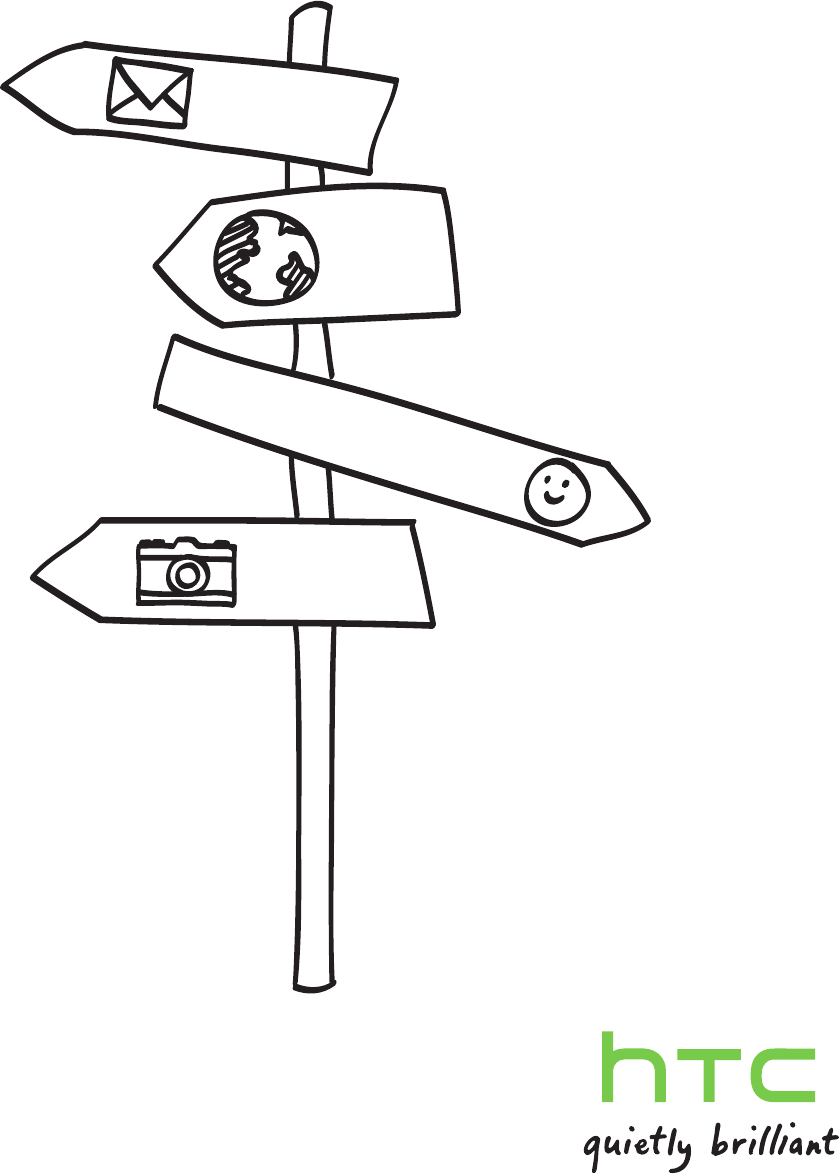
Your HTC Desire HD
User guide

2
Conventions used in this guide
In this user guide, we use the following symbols to indicate useful and important
information:
This is a note. A note often gives additional information, such as what happens on
your phone when you choose to do or not to do a certain action. A note also provides
information that may only be applicable to some situations.
This is a tip. A tip gives you an alternative way to do a particular step or procedure, or
lets you know of an option that you may find helpful.
This indicates that something is very important. Important information is something that
you need to do in order to accomplish a certain task or to get a phone feature to work
properly.
This provides safety precaution information, that is, information that you need to be
careful about to prevent potential problems when using your phone.

3 Contents
Contents
Basics 7
Inside the box 7
Your phone 7
Bottom cover 9
SIM card 10
Storage card 11
Battery 12
Switching your phone on or off 15
Entering your PIN 15
Finger gestures 15
Getting started 16
Setting up your phone for the first time 16
Home screen 16
Status and notifications 18
Notifications panel 20
Connecting your phone to a computer 21
Searching your phone and the Web 23
Adjusting the volume 25
Sleep mode 26
Personalizing 27
Making your phone truly yours 27
Personalizing your phone with scenes 27
Changing your wallpaper 28
Applying a new skin 29
Personalizing your Home screen with widgets 29
Adding icons and other shortcuts on your Home screen 31
Adding folders on your Home screen 31
Rearranging or removing widgets and icons on your Home screen 32
Rearranging the Home screen 33
Changing your ringtones and alarms 34
Rearranging or hiding application tabs 36
Phone calls 37
Making calls 37
Receiving calls 40
HTC Caller ID 41
Using in-call options 41
Using Call history 44
Blocking callers 45
Call services 46
Turning Airplane mode on or off 46

4 Contents
People 47
About People 47
Setting up My contact card 48
Ways of getting contacts into your phone 48
Merging contact information 50
Your contacts list 52
Contact information and conversations 54
Contact groups 56
People widget 58
Keyboard 59
Using the onscreen keyboard 59
Entering words with predictive text 61
Entering text by speaking 62
Editing text 63
Adjusting touch input settings 64
Messages 66
About Messages 66
Sending a text message (SMS) 67
Sending a multimedia message (MMS) 68
Resuming a draft message 69
Viewing and replying to a message 69
Managing message conversations 72
Setting message options 73
Accounts and sync 75
Synchronizing with online accounts 75
Synchronizing with your computer 78
Social 85
Facebook for HTC Sense 85
Facebook for Android 86
What’s the difference between Facebook for Android and Facebook for HTC Sense? 87
Tweeting on your phone 87
Friend Stream 90
Chatting in Google Talk 93
Email 95
Using Gmail/Google Mail 95
Using Mail 100
Calendar 108
About Calendar 108
Creating calendar events 108
Changing calendar views 110
Managing calendar events 112
Calendar event reminders 113
Displaying and synchronizing calendars 114
Changing Calendar settings 115
About the Calendar widget 115

5 Contents
Clock and Weather 116
About the HTC Clock widget 116
About the Clock app 116
Using Desk Clock 117
Using World Clock 118
Setting the alarm clock 119
Checking weather 121
About the Weather widget 122
Internet connections 123
Data connection 123
Wi-Fi 124
Adding connection widgets 126
Connecting to a virtual private network (VPN) 126
Using your phone as a modem (tethering) 127
Connecting your phone to the Internet through a computer (Internet Pass-through) 128
Using your phone as a wireless router 128
Web browser 129
Using your phone’s web browser 129
Copying text, looking up information, and sharing 132
Viewing bookmarks and previously visited pages 134
Setting browser options 135
Bluetooth 136
Bluetooth basics 136
Connecting a Bluetooth headset or car kit 136
Disconnecting or unpairing from a Bluetooth device 137
Sending information using Bluetooth 138
Receiving information using Bluetooth 139
Camera 141
Camera basics 141
Taking a photo 143
Recording video 144
Adding effects 145
After capturing 145
Changing camera settings 146
Photos, videos, and music 147
Browsing your Gallery 147
Listening to music 155
Sharing media on your home network 161
HTCSense.com 163
About HTCSense.com 163
Signing up for your HTCSense.com account 163
Using HTCSense.com 164
Dashboard 164
Footprints 166
People 168

6 Contents
Messages 169
HTC Hub 171
Signing out from or deleting your HTCSense.com account 171
Maps and location 172
Turning on location services 172
Locations 172
Google Maps 182
More apps 190
Watching videos on YouTube 190
Reading news feeds 191
Reading eBooks 194
Working on documents, spreadsheets, and presentations 198
Keeping track of your stocks 199
Listening to FM Radio 201
Recording your voice 202
Using Flashlight 203
Finding and installing apps from Android Market 204
Sharing games and apps 207
Security 209
Protecting your SIM card with a PIN 209
Protecting your phone with a screen lock 210
Settings 211
Settings on your phone 211
Changing display settings 212
Changing sound settings 214
Changing the phone language 215
Optimizing your phone’s battery life 215
Managing memory 216
Checking information about your phone 217
Update and reset 218
Updating the phone software 218
Restarting or factory resetting your phone 219
Trademarks and copyrights 220
Index 221
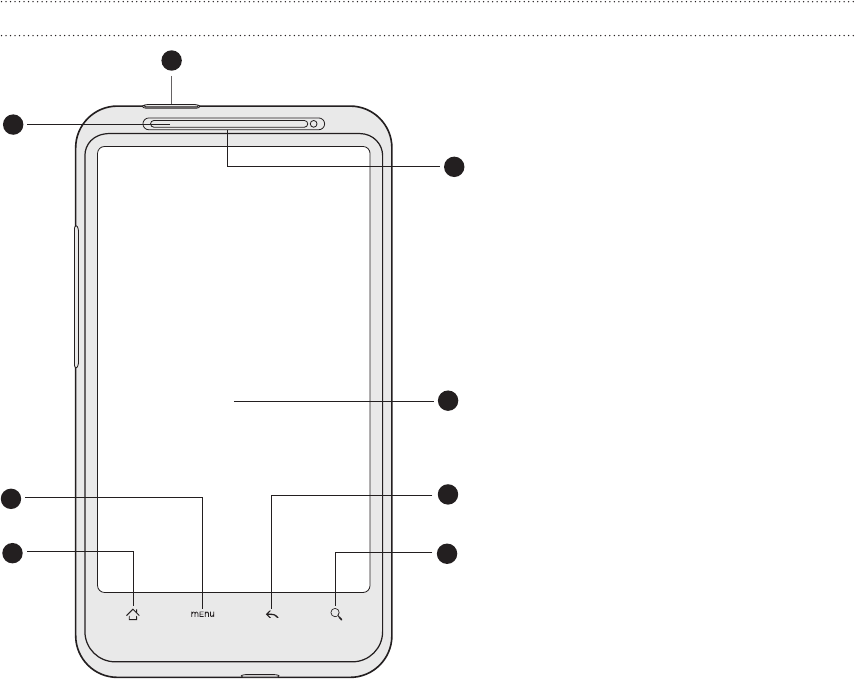
7 Basics
Basics
Inside the box
You will find the following inside the box:
Phone
Battery (preinstalled)
microSD™ card (preinstalled)
USB cable
3.5mm stereo headset
Power adapter
Quick start guide
Safety and regulatory guide
Your phone
Front panel
8
3
4
1
5
6
7
2
1 POWER
2 Notification LED
3 MENU
4 HOME
5 SEARCH
6 BACK
7 Touch screen
8 Earpiece
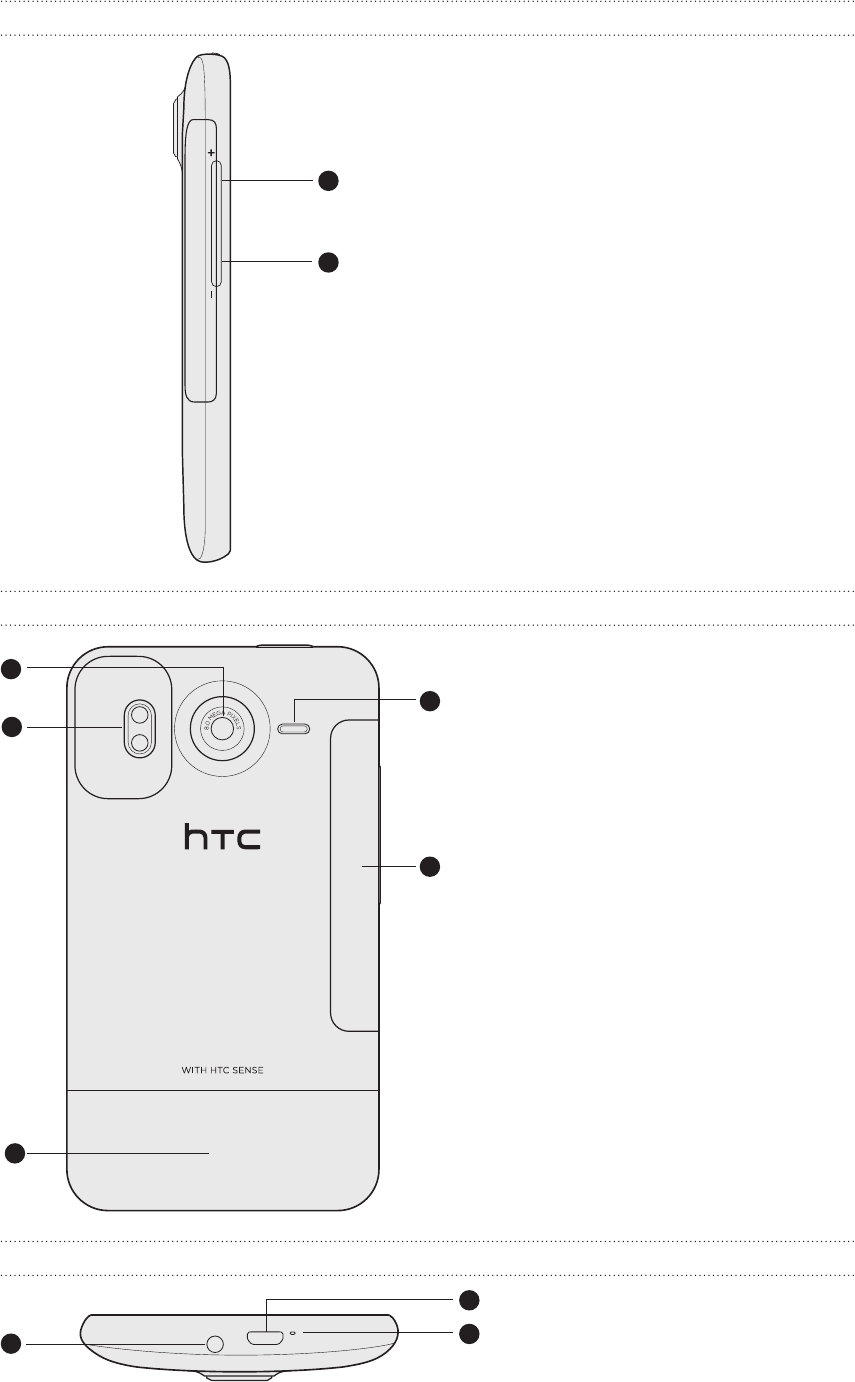
8 Basics
Left panel
1
2
1 VOLUME UP
2 VOLUME DOWN
Back panel
3
2
1
4
51 8 megapixel camera
2 Dual LED flash
3 Bottom cover
4 Battery compartment cover
5 Speaker
Bottom panel
2
1
31 3.5mm headset jack
2 Microphone
3 USB connector
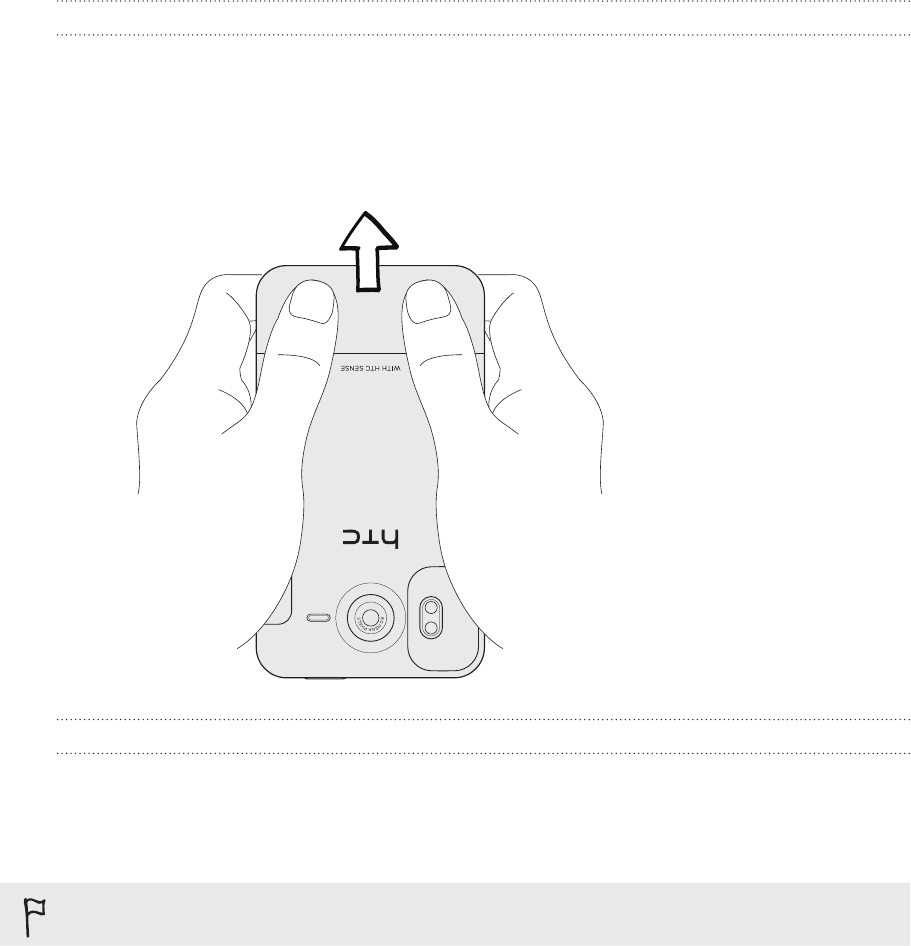
9 Basics
Bottom cover
Removing the bottom cover
Remove the bottom cover to access the SIM card slot and storage card slot.
With the phone switched off, hold your phone securely with the front facing
down.
With your right and left thumbs, push the bottom cover out to remove it.
Replacing the bottom cover
Slide the bottom cover onto the exposed area of your phone’s back panel.
Push the bottom cover towards the phone. You’ll hear a click when the bottom
cover is locked in place.
Your phone’s antenna is placed underneath the bottom cover. We recommend that you secure
the bottom cover to the phone’s back panel to get the best radio reception for your phone.
1.
2.
1.
2.
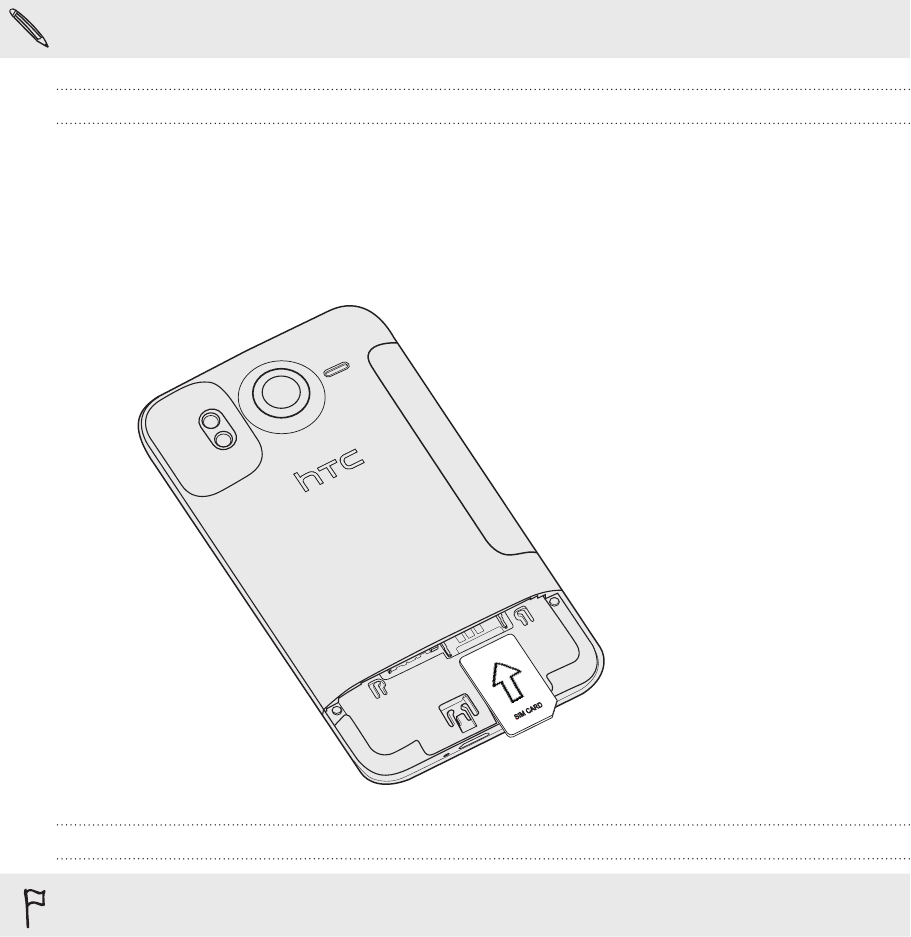
10 Basics
SIM card
The SIM card contains your phone number, service details, and phonebook/message
memory. Your phone supports both 1.8 V and 3 V SIM cards.
Some legacy SIM cards may not function with your phone. You should consult with your
mobile operator for a replacement SIM card. There may be fees for this service.
Inserting the SIM card
1. Take the bottom cover off.
See “Removing the bottom cover.”
2. With the SIM card’s gold contacts facing down and its cut-off corner facing out,
insert the SIM card halfway into the SIM card slot.
Removing the SIM card
Make sure to switch off your phone before removing your SIM card. Otherwise, the phone will
automatically turn off when you remove the SIM card.
1. Take the bottom cover off.
See “Removing the bottom cover.”
2. With your thumb, slide the SIM card out from the SIM card slot.
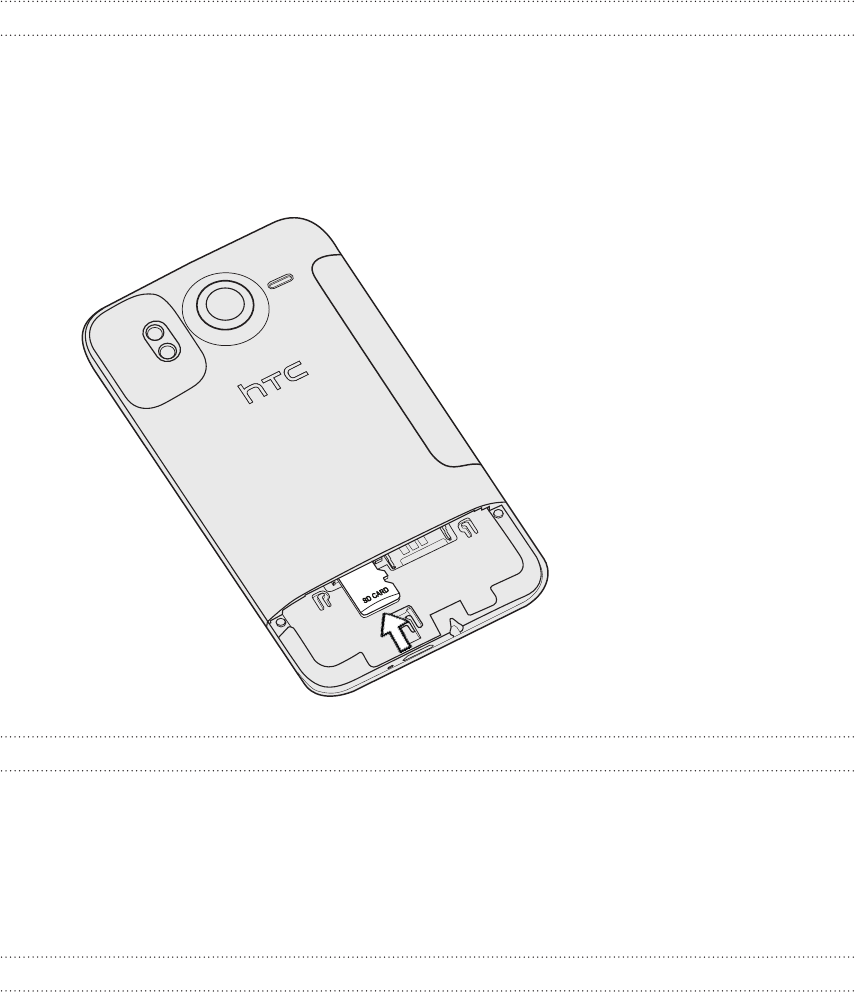
11 Basics
Storage card
Use the microSD card to store your photos, videos, and music. You’ll find the microSD
card already inserted in your phone.
Inserting the storage card
1. Take the bottom cover off.
See “Removing the bottom cover.”
2. Insert the microSD card into the storage card slot with its gold contacts facing
down and push it until it clicks into place.
Removing the storage card
1. Take the bottom cover off.
See “Removing the bottom cover.”
2. Push the storage card in to eject it from its slot.
3. Slide the storage card out from its slot.
Removing the storage card while the phone is on
When you need to remove the storage card while the phone is on, unmount the
storage card first to prevent corrupting or damaging the files in the storage card.
On the Home screen, press MENU, and then tap Settings.
Scroll down the screen, and then tap SD & phone storage.
Tap Unmount SD card.
Remove the storage card by following the steps in “Removing the storage card.”
1.
2.
3.
4.
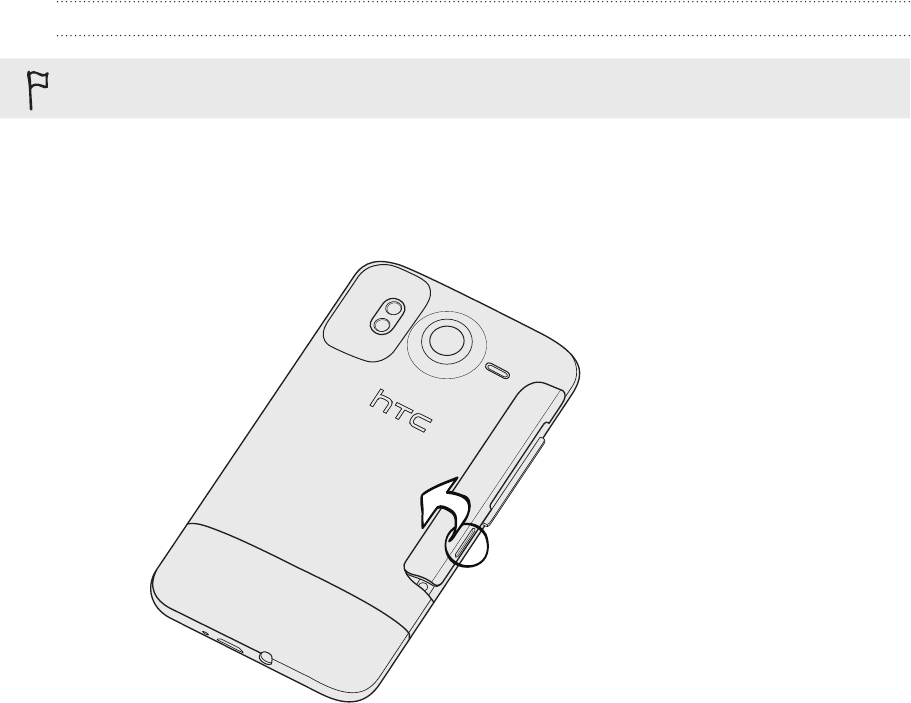
12 Basics
Battery
Your phone uses a rechargeable battery. Please use only original batteries and
accessories that came with your phone or replacements that we recommend.
How long the battery can last before it needs recharging depends on how you use
your phone. Among these are the phone features and accessories you use (for
example, leaving your Bluetooth connection always on uses more power). Long phone
calls and frequent web browsing use up much battery. Also, consider your location:
poor signal strength from your mobile network and extreme temperature make the
battery work harder.
Removing the battery
Right after you take your phone out from the box for the first time, don’t forget to remove the
thin film wrapped around the battery that’s inside your phone.
With the phone turned off, hold your phone securely with the front facing down.
With your thumb or finger, lift the battery compartment cover off from the small
opening on the left side of your phone.
3. Pull the battery out from the battery compartment.
1.
2.
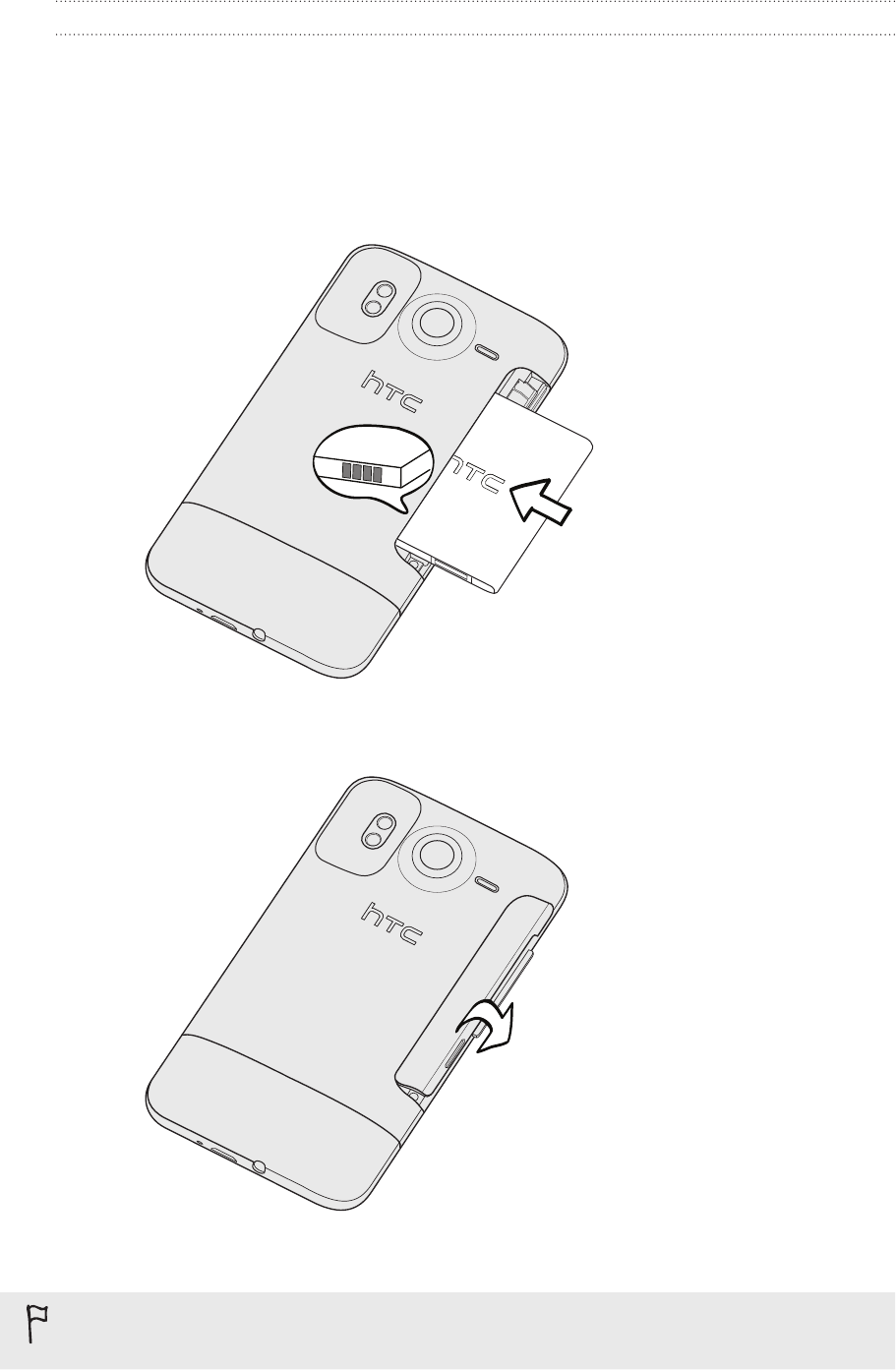
13 Basics
Inserting the battery
Hold your phone securely with the front facing down.
With your thumb or finger, lift the battery compartment cover off from the small
opening on the left side of your phone.
Insert the battery (with its exposed copper contacts first) into the battery
compartment.
4. Put back the battery compartment cover, pushing the battery all the way in.
5. Press down all sides of the cover to lock it in place.
Your phone’s Bluetooth and Wi-Fi antennas are placed underneath the battery compartment
cover. We recommend that you secure the battery compartment cover to the phone for
stronger Bluetooth or Wi-Fi connection.
1.
2.
3.
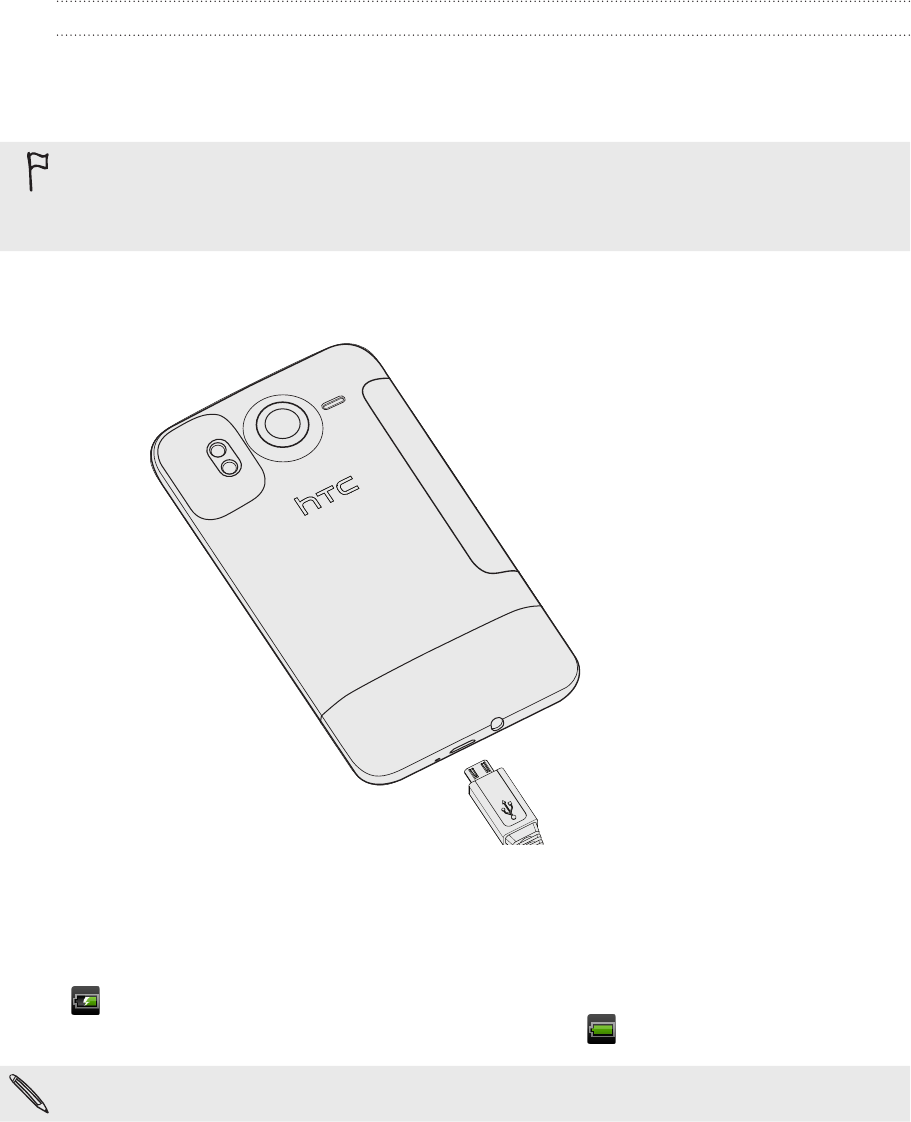
14 Basics
Charging the battery
The battery is partially charged when shipped. Before you turn on and start using your
phone, it is recommended that you charge the battery. Some batteries perform best
after several full charge/discharge cycles.
Only the power adapter and USB sync cable provided with your phone must be used to
charge the battery.
Do not remove the battery from the phone while you are charging it using the power or car
adapter.
1. Plug the power adapter into the USB connector of your phone.
2. Plug in the power adapter to an electrical outlet to start charging the battery.
As the battery is being charged, the notification LED shows a solid red light. The light
turns to solid green when the phone is fully charged.
When you charge the battery while the phone is on, the charging battery icon
( ) is displayed in your phone’s status bar. After the battery has been fully charged,
the charging battery icon turns to a full battery icon ( ).
As a safety precaution, the battery stops charging when it overheats.

15 Basics
Switching your phone on or off
Switching your phone on
Press the POWER button. Easy.
When you turn on the phone for the first time, you’ll need to set it up. See the Getting started
chapter for details.
Switching your phone off
1. If the display is off, press the POWER button to turn it back on, then unlock the
screen by sliding down the bar on the lock screen.
See “Unlocking the screen” in the Getting started chapter for details.
2. Press and hold the POWER button for a few seconds.
3. When the Power options menu appears, tap Power off.
Entering your PIN
Most SIM cards come with a PIN (personal identification number) set by your mobile
operator. If you’re asked for a PIN, enter it and then tap OK.
To find out how to enable, disable, or change the PIN, see “Protecting your SIM card
with a PIN” in the Security chapter.
If you enter the wrong PIN three times, your SIM card is blocked. No problem. Just contact
your mobile operator and ask for the PUK (PIN Unblocking Key).
Finger gestures
Tap When you want to type using the keyboard, select items onscreen such as
application and settings icons, or press onscreen buttons, simply tap them
with your finger.
Press and hold To open the available options for an item (for example, a contact or link in a
web page), simply press and hold the item.
Swipe or slide To swipe or slide means to quickly drag your finger vertically or horizontally
across the screen.
Drag Press and hold your finger with some pressure before you start to drag.
While dragging, do not release your finger until you have reached the
target position.
Flick Flicking the screen is similar to swiping, except that you need to swipe your
finger in light, quicker strokes. This finger gesture is always in a vertical
direction, such as when flicking the contacts or message list.
Rotate For most screens, you can automatically change the screen orientation
from portrait to landscape by turning the phone sideways. When entering
text, you can turn the phone sideways to bring up a bigger keyboard.
Pinch In some apps, like Gallery or the web browser, you can “pinch” the screen
using two fingers (for example, thumb and index finger) to zoom in or
zoom out when viewing a picture or a web page.
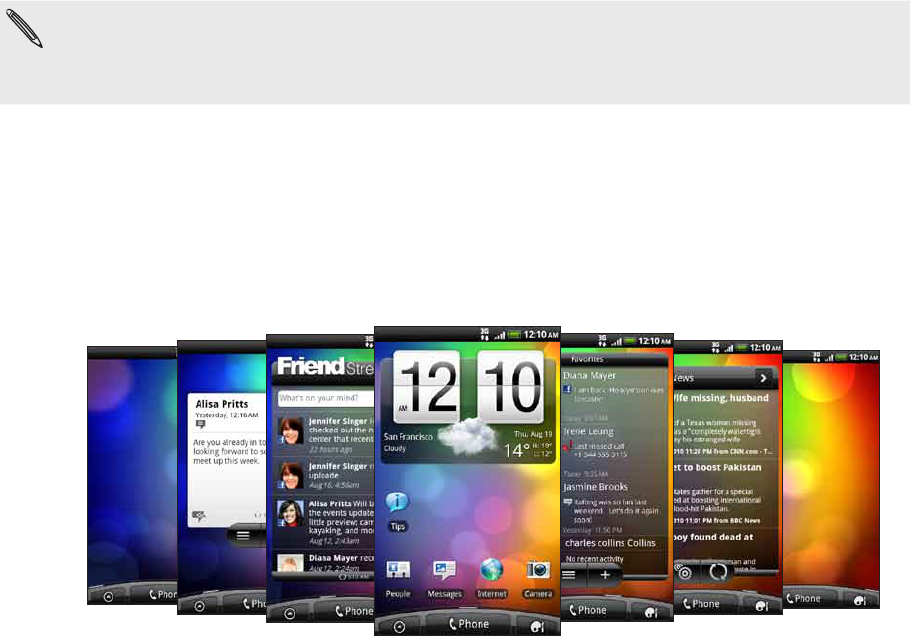
16 Getting started
Getting started
Setting up your phone for the first time
When you switch on your phone for the first time, you’ll be asked to set up your
phone. You can choose your language, how you want to connect to the Internet,
and whether you want your current location to be automatically detected. If you still
have personal contacts and calendar events stored on your old phone, you can easily
transfer them to your new phone through Bluetooth as well.
Be sure to sign in to your Google Account so you can use Google apps like
Gmail™/Google Mail. You can also set up your other email accounts, favorite social
networks like Facebook® and Twitter™, and more.
Just follow the onscreen instructions and you’ll be up and running with your phone in
no time.
Some features that need to connect to the Internet such as location-based services and
auto-sync of your online accounts may incur extra data fees from your mobile operator. Don’t
worry. You can enable or disable them in your phone’s settings as you go along later on. To
find out how, see the Settings chapter.
Home screen
Your Home screen is where you make your phone your own. It comes with a weather
clock widget that shows the time and weather in your current location. You can also
add your favorite apps, shortcuts, folders and widgets so they’re always just a tap
away.
To find out how, see the Personalizing chapter.
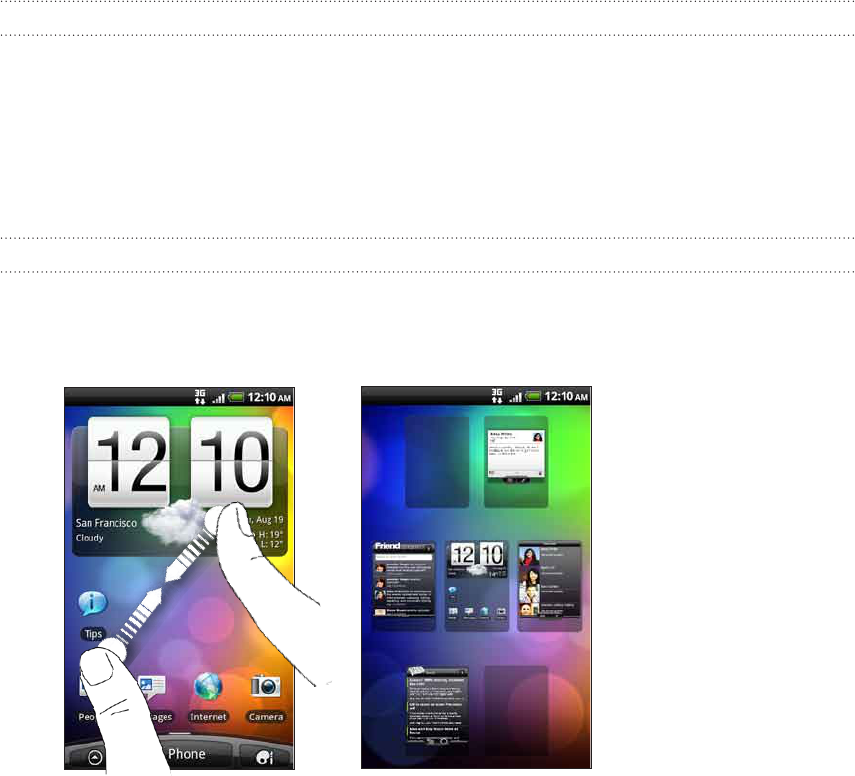
17 Getting started
Extended Home screen
As you start to do more things with your phone, you might find that one Home screen
is not enough. No problem. You can use up to six extra screens. It should be plenty.
Slide your finger horizontally to the left or right and you’ll discover more space for
adding icons, widgets, and more.
Press HOME to return to the main Home screen (that is, the center home screen).
Using Leap view
To jump straight to the screen that you want, press HOME while on the main Home
screen or pinch the screen to show the Leap view. It reveals all seven Home screens as
thumbnails.
Just tap the one you want and you’ll leap right there.
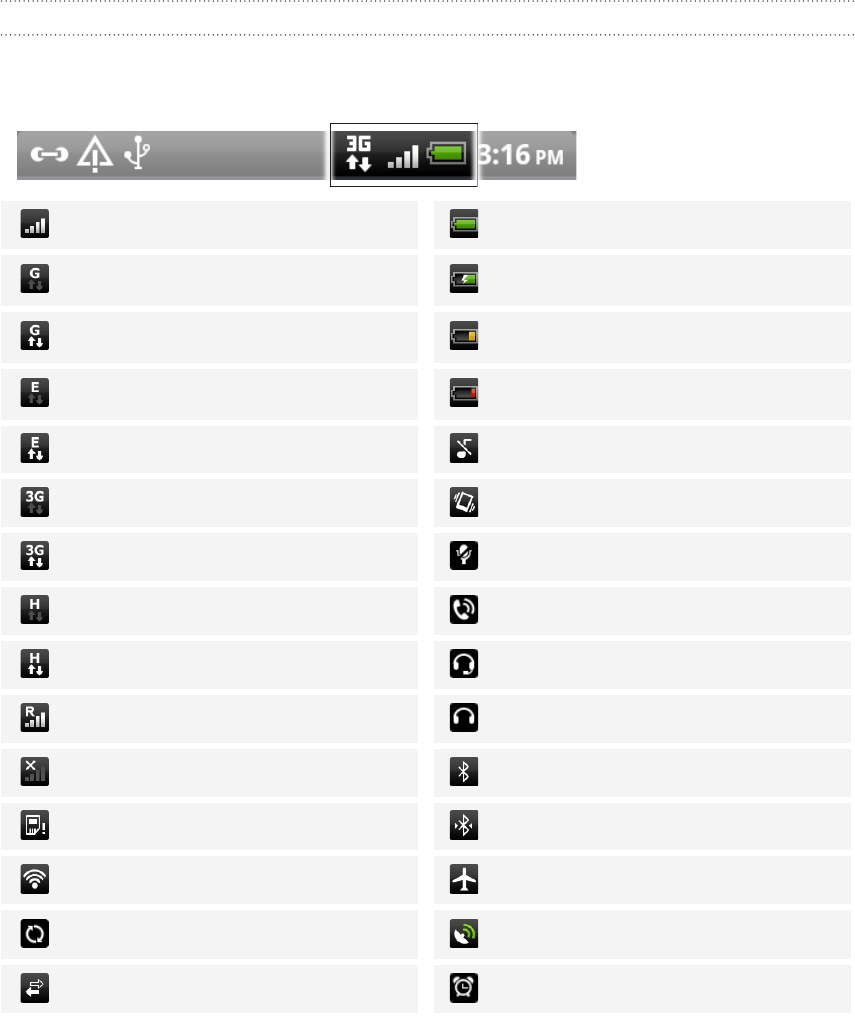
18 Getting started
Status and notifications
Status icons
You can tell a lot about your phone by checking the icons in its status bar. Here’s what
each one means:
Signal strength Battery is full
GPRS connected Battery is charging
GPRS in use Battery is low (20% remaining)
EDGE connected Battery is very low (10% remaining)
EDGE in use Silent mode
3G connected Vibrate mode
3G in use Phone microphone is mute
HSDPA connected Speakerphone on
HSDPA in use Wired microphone headset connected
Roaming Wired headset connected
No signal Bluetooth is on
No SIM card installed Connected to a Bluetooth device
Connected to a Wi-Fi network Airplane mode
Data synchronizing GPS is on
Network sharing is on Alarm is set
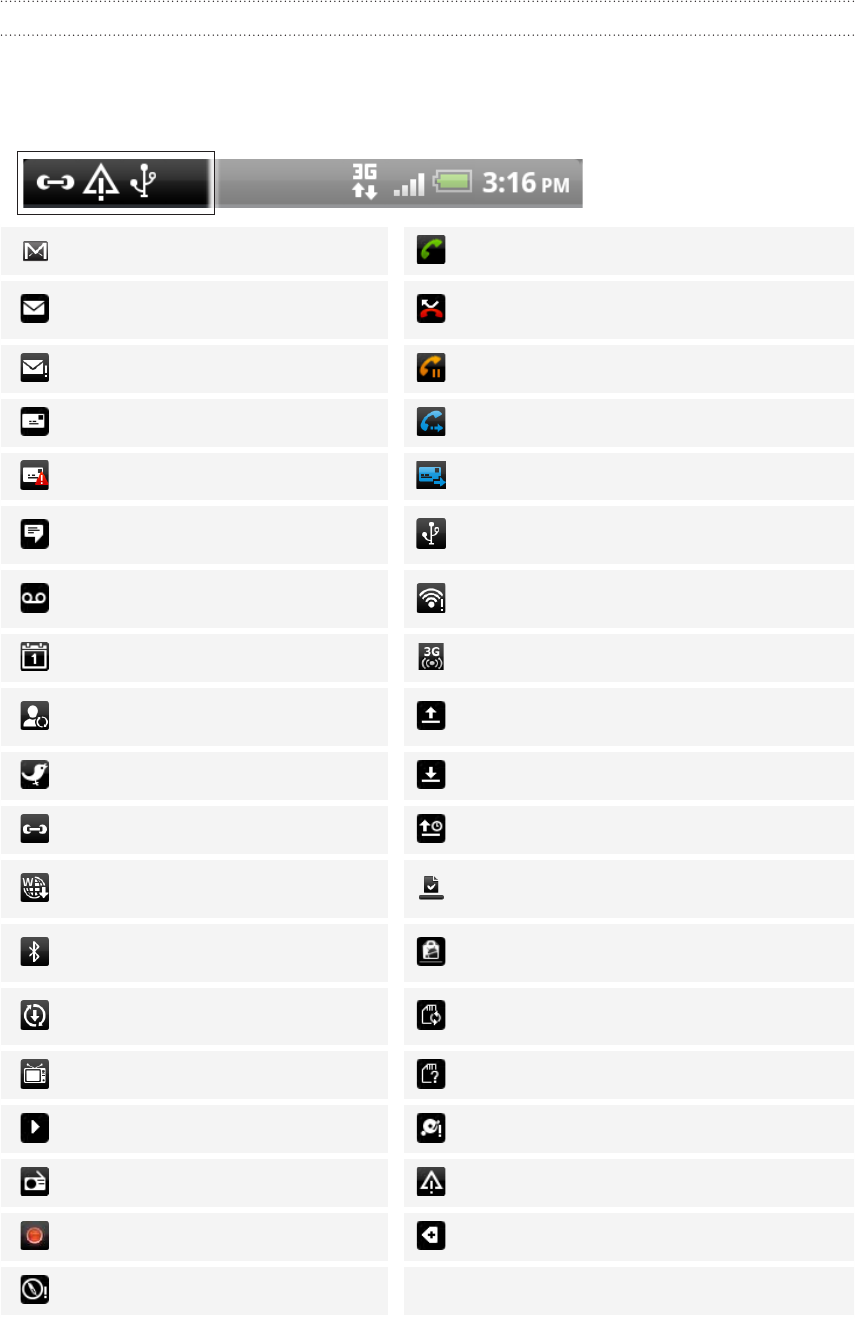
19 Getting started
Notification icons
A busy life means a busy phone. Notification icons on the status bar make it easy for
you to keep on top of your messages, calendar events and alarms. Here’s what each
one means:
New Gmail/Google Mail message Call in progress
New Microsoft Exchange
ActiveSync or POP3/IMAP email Missed call
Problem with email delivery Call on hold
New SMS/MMS Call forwarding on
Problem with SMS/MMS delivery Message forwarding on
New Google Talk instant message The phone is connected to a computer via
USB cable
New voicemail Wi-Fi is on and wireless networks are
available
Upcoming event Portable Wi-Fi Hotspot is on
New updates from your social
networks Uploading data (animated)
New tweet Downloading data (animated)
Matched contacts suggestion Waiting to upload
New push message Downloaded Android Market app installed
successfully
Bluetooth pairing request Update available for an app downloaded
from Android Market
Phone software update available Storage card is safe to remove or storage
card is being prepared
TV out No storage card installed on the phone
Song is playing Storage card is low on free space
FM Radio app in use General notification
Voice recording is on More (not displayed) notifications
Compass needs orientation
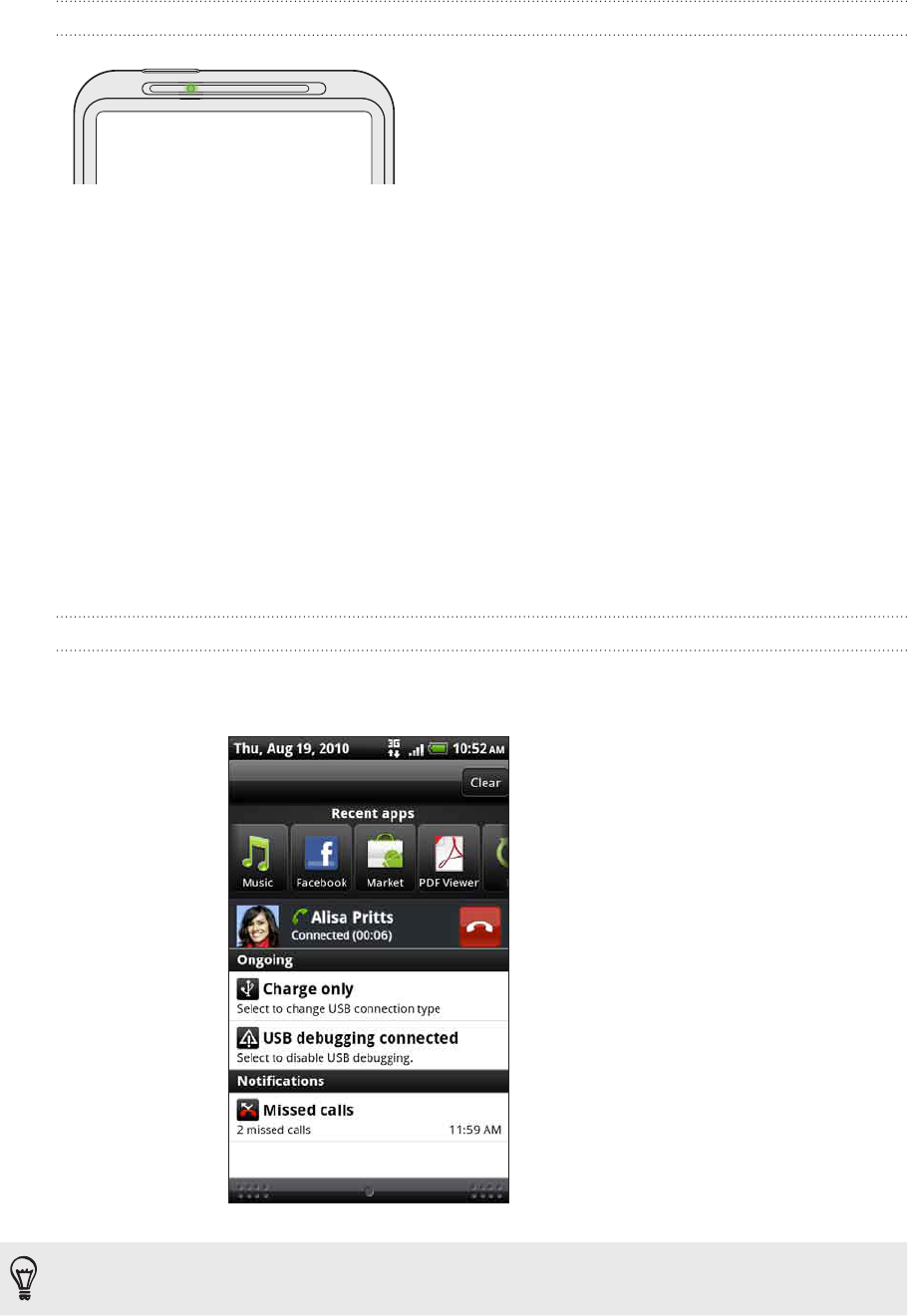
20 Getting started
Notification LED
The notification LED shows a:
Solid green light when the phone is connected to the power adapter or a
computer and the battery is fully charged.
Flashing green light when you have a pending notification.
Solid red light when the battery is being charged.
Flashing red light when the battery level reaches very low.
Notifications panel
When you get a new notification, you can open the Notifications panel to see the
message, reminder or event notification. The Notifications panel also lets you switch
between recently-opened apps as quickly as possible.
Opening the Notifications panel
Press and hold the status bar, then slide your finger downward to open the
Notifications panel.
If you have several notifications, you can scroll down the screen to see them all.
You can also open the Notifications panel on the Home screen by pressing MENU and then
tapping Notifications.
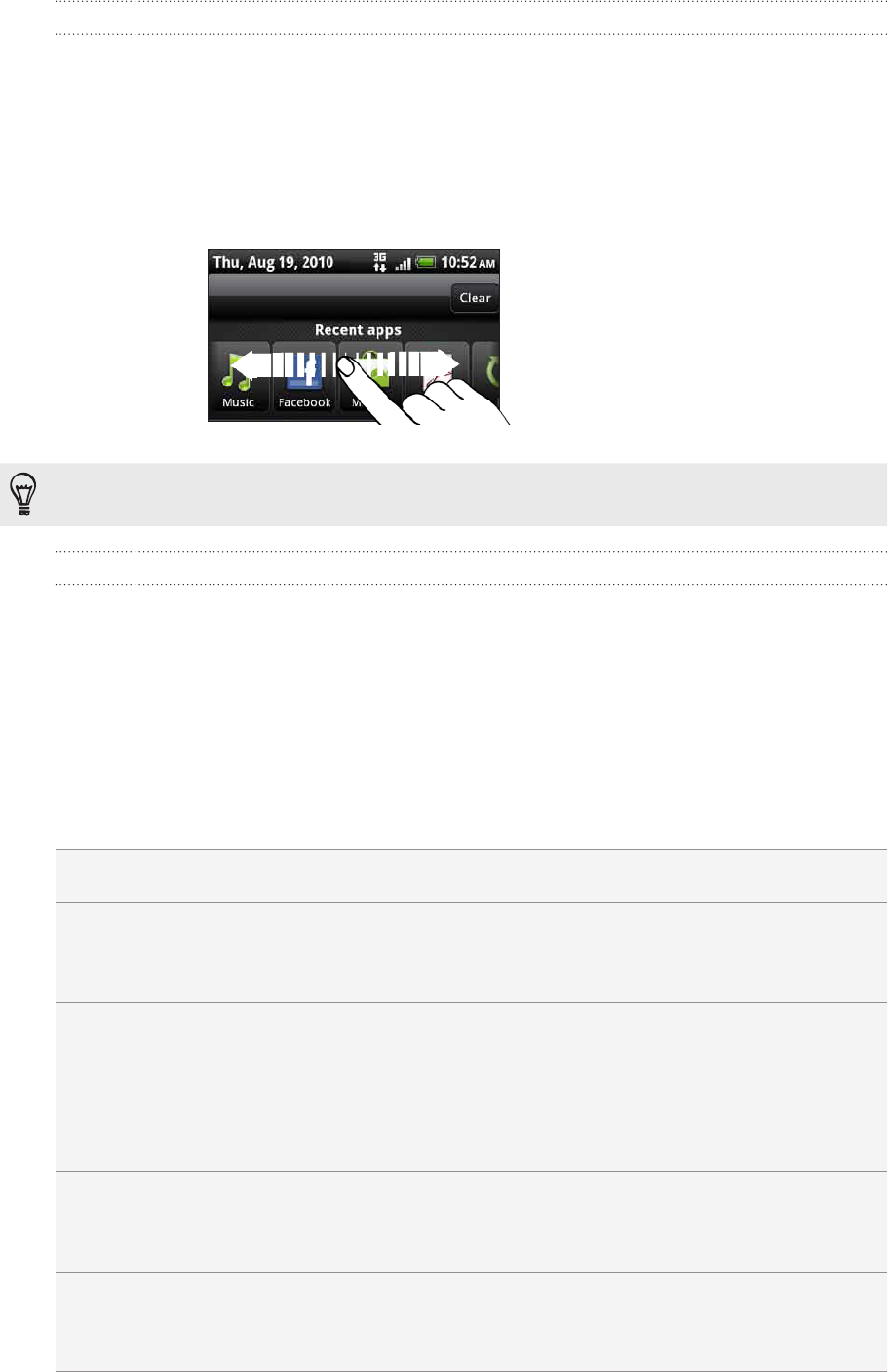
21 Getting started
Switching between recently-opened apps
On the Notifications panel, you can easily access up to eight apps you just recently
opened.
1. Press and hold the status bar, then slide your finger downward to open the
Notifications panel.
2. In the Recent apps section, slide your finger left or right to see recently-opened
apps.
3. Tap an app to open it.
You can also go to the Recent apps screen when you press and hold HOME.
Closing the Notifications panel
Press and hold the bottom bar of the Notifications panel, then slide your finger up the
screen. Or just press BACK.
Connecting your phone to a computer
Whenever you connect your phone to a computer using the USB cable, the Connect
to PC screen opens and lets you choose the type of USB connection. Select one of the
following choices, and then tap Done:
Charge only Select this option if you only want to charge the battery while your
phone is connected to your computer.
HTC Sync Select this option to synchronize contacts, calendar, and other
information between your computer and your phone. For more
information, see “Synchronizing with your computer” in the Accounts
and sync chapter.
Disk drive This mode is available only when there’s a microSD card on your
phone. Select this mode when you want to copy files between your
phone’s storage card and your computer. For more information, see
“Copying files to or from the storage card” in this chapter.
When Disk drive mode is enabled while your phone is connected
to the computer, you will not be able to use apps on your phone to
access the storage card.
USB tethering When you do not have Internet connection on your computer, you
can select this mode to share your phone’s mobile data connection
with your computer. For more information, see “Using your phone as a
modem (tethering)” in the Internet connections chapter.
Internet pass-through If you don’t have a data plan for your phone or you don’t have access
to a Wi-Fi network, you can select this mode to share your computer’s
Internet connection with your phone. For more information, see the
Internet connections chapter.

22 Getting started
You can also change the type of USB connection on-the-fly, without having to
disconnect and reconnect your phone. Slide open the Notifications panel, and then
tap the notification that says “Select to change USB connection type” to open the
Connect to PC screen again.
To change the default connection type or choose between showing and hiding the Connect to
PC screen, press MENU from the Home screen, and then tap Settings > Connect to PC.
Copying files to or from the storage card
You can copy your music, photos, and other files to your phone’s storage card.
1. Connect your phone to your computer using the supplied USB cable.
2. On your phone’s Connect to PC screen, tap Disk drive, and then tap Done.
On your computer, the connected phone is recognized as a removable disk.
3. Navigate to the removable disk and open it.
4. Do one of the following:
Copy the files from the computer to the phone’s storage card’s root folder.
Copy the files from the phone’s storage card to a folder in your computer.
5. After copying the files, unmount the removable disk (that is, the connected
phone) as required by your computer’s operating system to safely remove your
phone.
6. Do one of the following:
Disconnect the phone from the computer.
If you want to keep the phone connected to the computer but want the
phone to be able to access the storage card, open the Notifications panel,
tap Disk drive, select an option except Disk drive, and then tap Done.
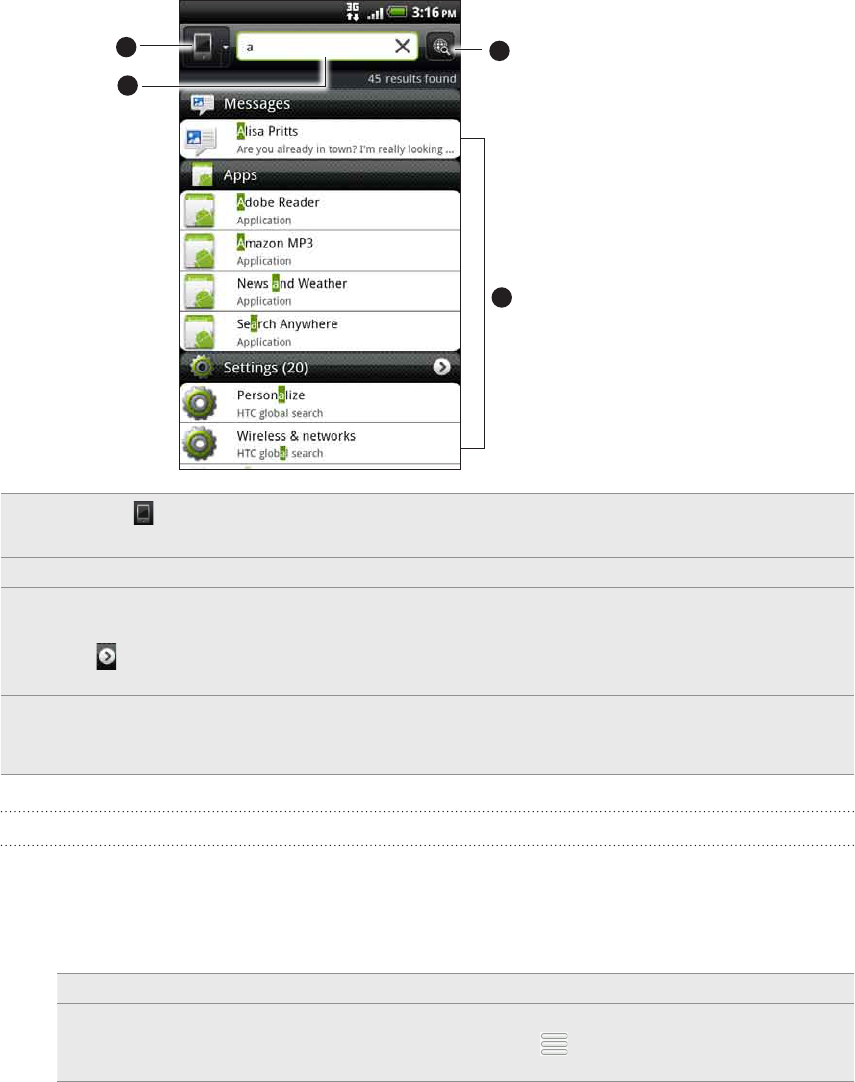
23 Getting started
Searching your phone and the Web
Find all types of information on your phone and the Web. Search Anywhere sifts
through different files, information, and apps on your phone. You can also choose to
search the Web using your favorite web search service.
Simply press SEARCH from the Home screen. Then enter the first few letters of what
you want to search for. Matching items will be shown as you type.
3
4
1
2
1 This icon ( ) indicates that your phone will search for all types of information.
Tap it if you want to choose and search only for one type of item, for example, Mail.
2 Type in what you want to search for.
3 Matching search suggestions and results. You can:
Scroll down to see more search results.
Tap to see more results for a particular category.
Tap a search result item to open its app.
4 After entering a word or phrase in the search box, tap to search the Web using your
favorite search service. To find out how to select a search service to use, see “Setting your
phone’s search options”.
Setting your phone’s search options
From the Home screen, press SEARCH.
When the search box appears, press MENU, and then tap Settings.
Tap any of the following:
Web search engine Choose a web search service you want to use.
Select areas to search Choose the types of items or apps to include in the search.
You can also press and hold and arrange items according
to search priority.
1.
2.
3.
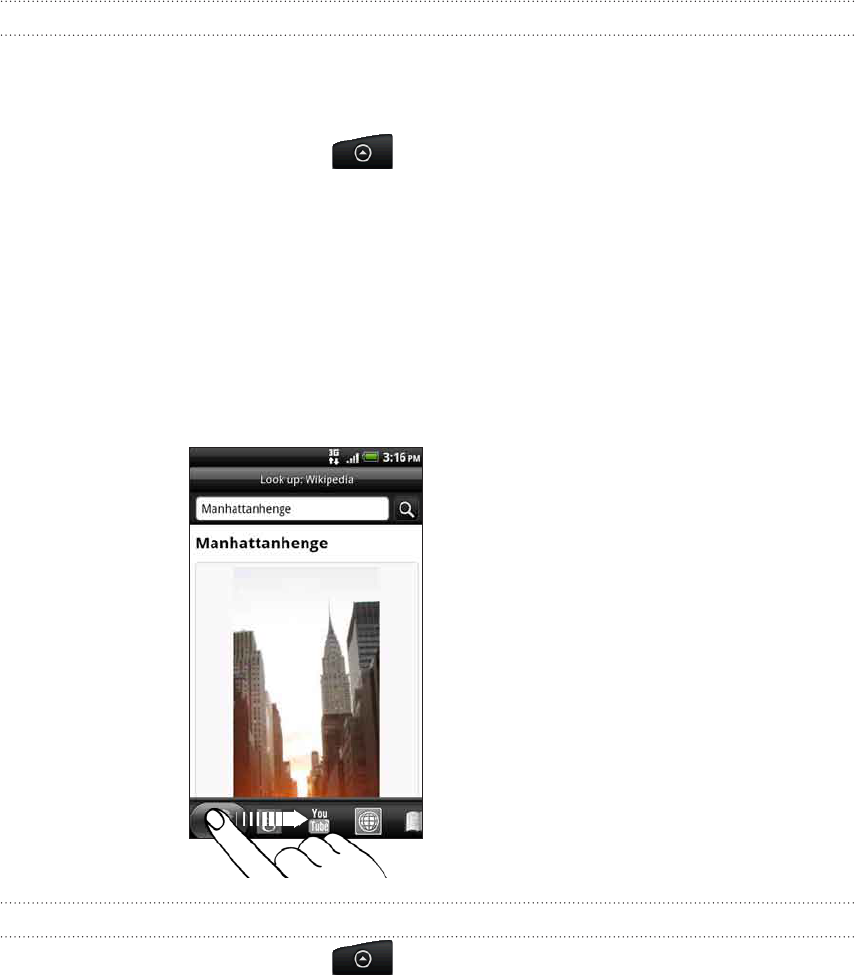
24 Getting started
Quickly looking up information on the Web
Quick Lookup helps you learn about something right on the spot. When you enter a
new word or phrase, you can readily look it up in popular websites or search services
such as Wikipedia, Google Search, YouTube, Google Translate, and Google Dictionary.
1. From the Home screen, tap > Quick Lookup.
2. If the onscreen keyboard is open, press BACK to close it first so you’ll see the
bottom tabs.
3. Slide across the tabs to pick where you want to look up information. Then in the
search box, enter what you want to search for.
If, for example, you’ve found the information you were looking for in one tab such as
Wikipedia, you can switch to the other tabs to automatically search the same item in
Google Search on the Web, watch related videos in YouTube, or look up translations
and meanings in Google Translate and Google Dictionary.
Translating words to other languages
1. From the Home screen, tap > Quick Lookup.
2. Press BACK to hide the onscreen keyboard first, then slide to the Google
Translate tab.
3. Under From language, choose the original language, then enter the word or
phrase you want to translate.
4. Under To language, choose from the languages available for translation.
5. Tap Translate.

25 Getting started
Adjusting the volume
Adjusting the ringer volume changes the volume level of the phone ringtone, while
adjusting the media volume changes the volume level of sound notifications and music
or video playback.
Adjusting the ringer volume
Press the VOLUME UP or VOLUME DOWN button on the left panel of the
phone to adjust the ringer volume to your desired level. The Ringer volume
window appears on the screen to display the volume levels.
While in the lowest ringer volume level (Silent mode), press VOLUME DOWN
once to set your phone to Vibrate mode. The phone vibrates and the vibrate
mode icon ( ) appears in the status bar.
While in Vibrate mode, press VOLUME UP once to switch to silent mode. The
speaker mute icon ( ) displays in the status bar.
Adjusting the media volume
When playing music or watching video, press the VOLUME UP or VOLUME DOWN
button on the left panel of the phone to adjust the media volume. The Media volume
window appears on the screen to display the volume level.
Adjusting the earpiece volume for phone calls
During a phone call, press the VOLUME UP or VOLUME DOWN button.
Adjusting the volume via settings
1. From the Home screen, press MENU, and then tap Settings > Sound > Volume.
2. Drag the volume sliders to the left or right to adjust the volume levels of your
phone’s ringtone, media playback, alarms, and notifications.
Your phone briefly plays a sample tone with the volume being adjusted as you
drag a slider.
3. If you want the same volume for your ringtone and notifications, select Use
incoming call volume for notifications.
4. When you’re done, tap OK.
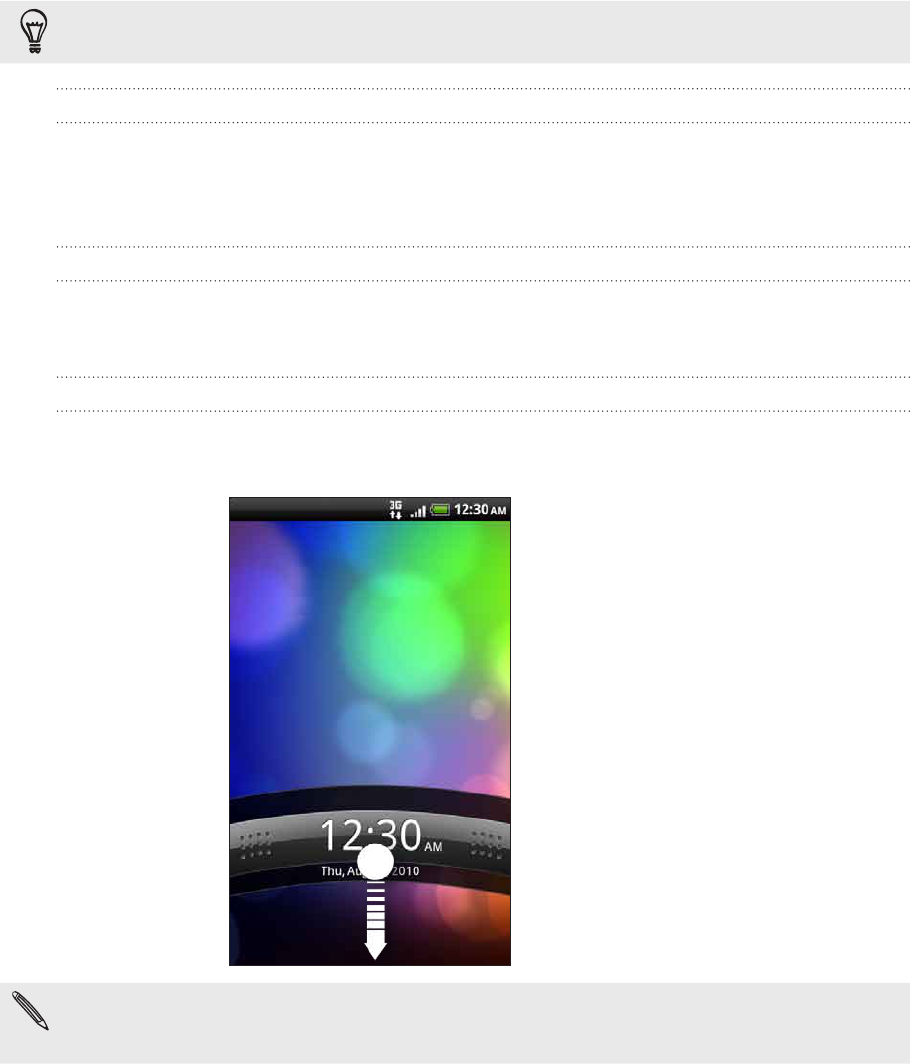
26 Getting started
Sleep mode
Sleep mode saves battery power by putting your phone into a low power state while
the display is off. It also stops accidental button presses when the phone’s in your bag
or pocket. You’ll still receive messages and calls though.
To change the delay before your screen turns off, see “Adjusting the time before the screen
turns off” in the Settings chapter.
Switching to Sleep mode
Quickly press the POWER button to turn off the display and switch your phone to
Sleep mode. Your phone also automatically goes into Sleep mode when it’s idle for a
while.
Waking up from Sleep mode
Your phone automatically wakes up when you have an incoming call. To wake it up
manually, press the POWER button. You’ll need to unlock the screen.
Unlocking the screen
Press the bar on the lock screen and then slide your finger down to unlock the screen
or answer an incoming call.
If you have set up a screen unlock pattern, pin, or password, you will be asked to draw the
pattern on the screen or enter the PIN or password before it unlocks. See “Protecting your
phone with a screen lock” in the Security chapter for details.
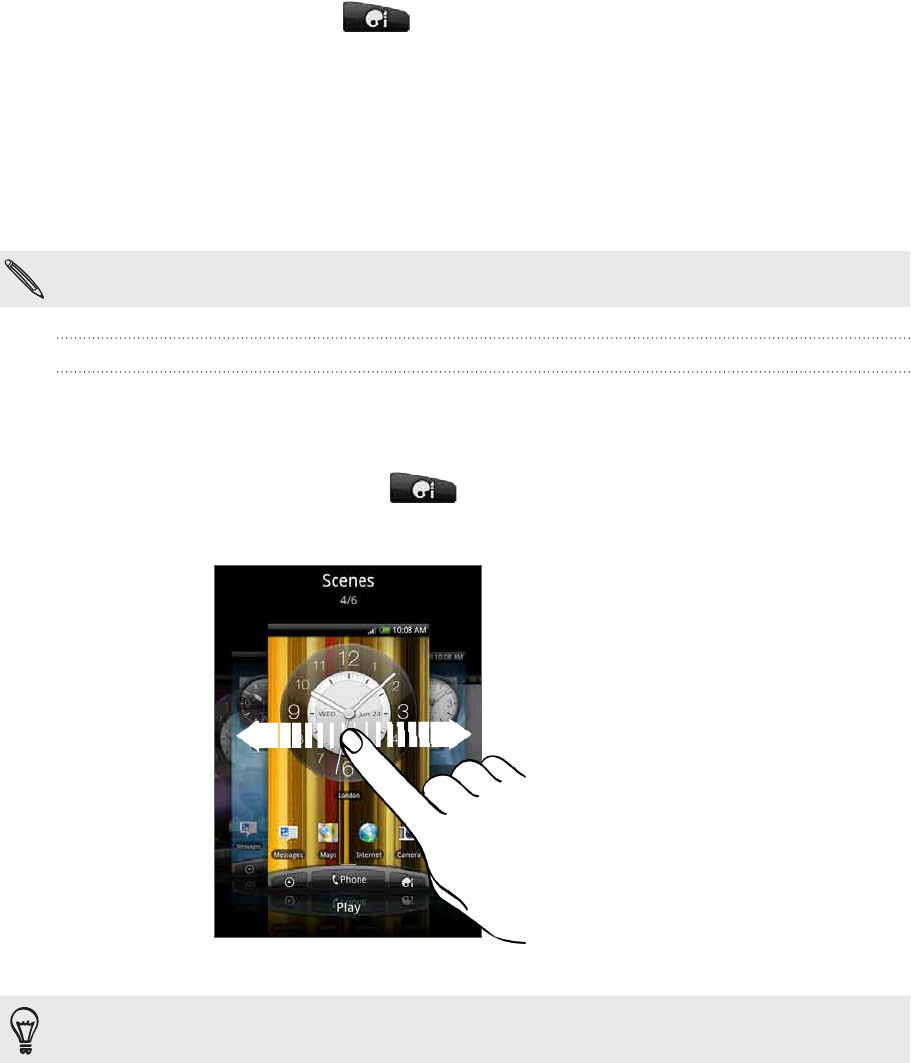
27 Personalizing
Personalizing
Making your phone truly yours
Make your phone look and sound just the way you want it. Personalize your phone
with a different wallpaper, skin, ringtone, and notification sound for events such as
incoming text, email, and calendar reminders.
Tap the Personalize button ( ) right on the Home screen to get started.
Personalizing your phone with scenes
Your phone becomes multiple phones in one when you use scenes. Scenes are
personalized Home screen layouts that you can quickly apply to your phone. By
switching between scenes, you instantly turn your phone into your perfect weekend
phone, travel phone, work phone, or pure play phone.
Everytime you add or modify something on the Home screen, your phone automatically saves
your changes to the current scene selected.
Using a preset scene
Your phone features preset scenes, each preconfigured with a different wallpaper and
collection of widgets that reflect different moments in your life. You can choose a
scene that is suitable for work, play, travel, or your social life.
From the Home screen, tap > Scene.
Slide your finger on the screen from right to left to select the scene you want.
3. Tap Apply.
To download more scenes, tap Get more. To know more about downloading from HTC Hub,
see the HTCSense.com chapter.
1.
2.
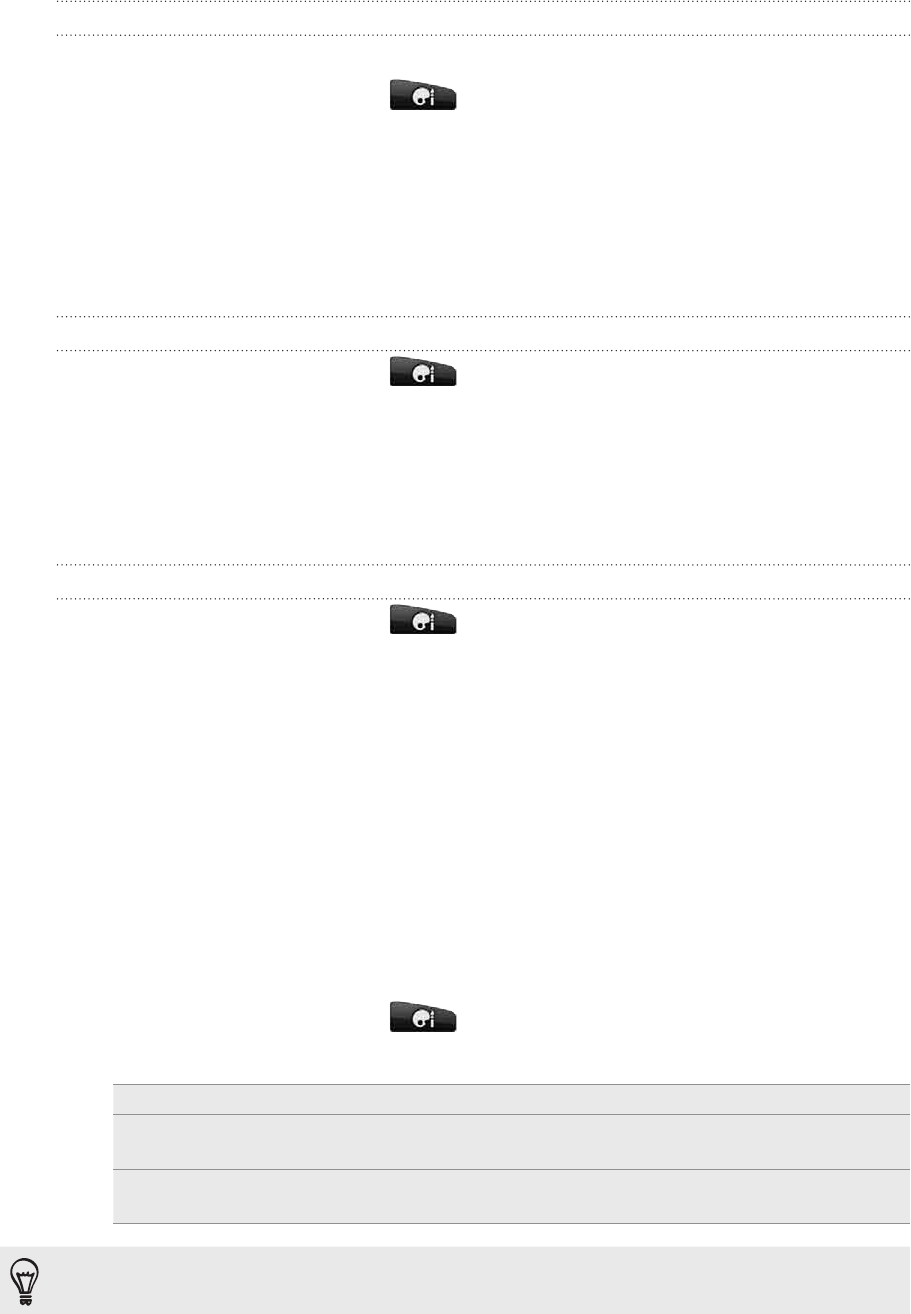
28 Personalizing
Creating a new scene
You’ll start with an empty Home screen when you create a new scene.
From the Home screen, tap > Scene.
Press MENU, then tap New.
Enter a new scene name, then tap Done.
Personalize the scene by adding widgets and other elements, arranging the
Home screen layout, and changing the skin or wallpaper. All of your changes will
be automatically saved to this scene.
Renaming a scene
From the Home screen, tap > Scene.
Slide your finger on the screen from right to left to select the scene you want to
rename.
Press and hold a scene thumbnail, then tap Rename.
Enter a new scene name, then tap Done.
Deleting scenes
From the Home screen, tap > Scene.
Press MENU, then tap Delete.
Slide your finger on the screen from right to left to browse through scenes, then
tap one or more scenes you want to delete.
Tap Delete.
Changing your wallpaper
Personalizing your wallpaper with your favorite photo is a quick and easy way to
change the feel of your phone and give it a fresh look. Browse the collection of
wallpapers included in your phone or choose from photos that you have taken with
the camera. You can also change your Home screen to use an animated wallpaper.
From the Home screen, tap > Wallpaper.
2. Tap one of the following:
HTC wallpapers Choose a preset wallpaper, then tap Preview > Apply.
Live wallpapers Choose from preset animated wallpapers. Tap Preview to view
the animation, and then tap Apply.
Gallery Choose a photo that you have taken using the camera or
copied to your storage card. Crop the photo and then tap Save.
To download more wallpapers, tap Wallpaper > HTC wallpapers > Get more. To know more
about downloading from HTC Hub, see the HTCSense.com chapter.
1.
2.
3.
4.
1.
2.
3.
4.
1.
2.
3.
4.
1.
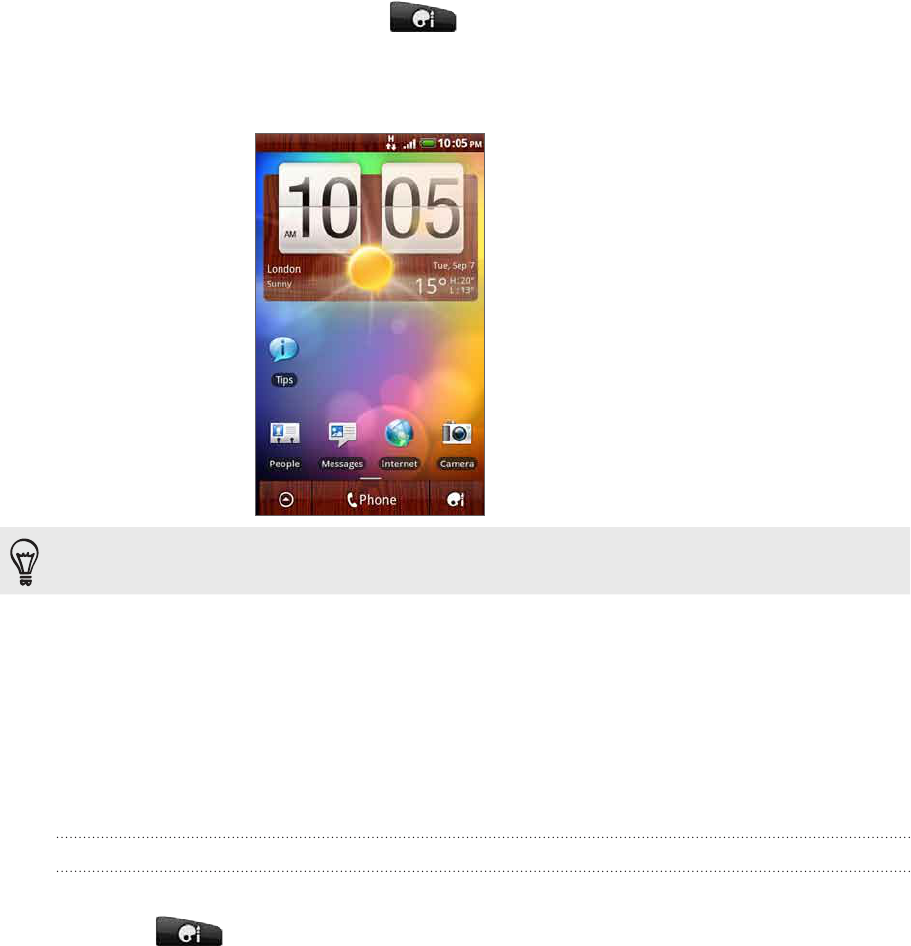
29 Personalizing
Applying a new skin
Personalize beyond the Home screen by applying a new skin. Skins are set to give a
different look and feel to most of your phone’s onscreen buttons, application screens,
option menus, and other items.
From the Home screen, tap > Skin.
Slide your finger on the screen from right to left to select the skin you want.
3. Tap Apply.
To download more skins, tap Get more. To know more about downloading from HTC Hub, see
the HTCSense.com chapter.
Personalizing your Home screen with widgets
Widgets put at-a-glance important information and media content up front on
your Home screen. Some widgets are already added to your Home screen for your
convenience. You can add more from the available selections of widgets, or download
more widgets.
Adding a widget
Go to a part of the Home screen where there’s space to add a new widget.
Tap > Widget.
Select a widget that you want.
Most HTC widgets are available in a variety of designs and sizes to suit your
needs. Slide your finger on the screen from right to left to view the different
styles, and then tap Select to choose one.
1.
2.
1.
2.
3.
4.
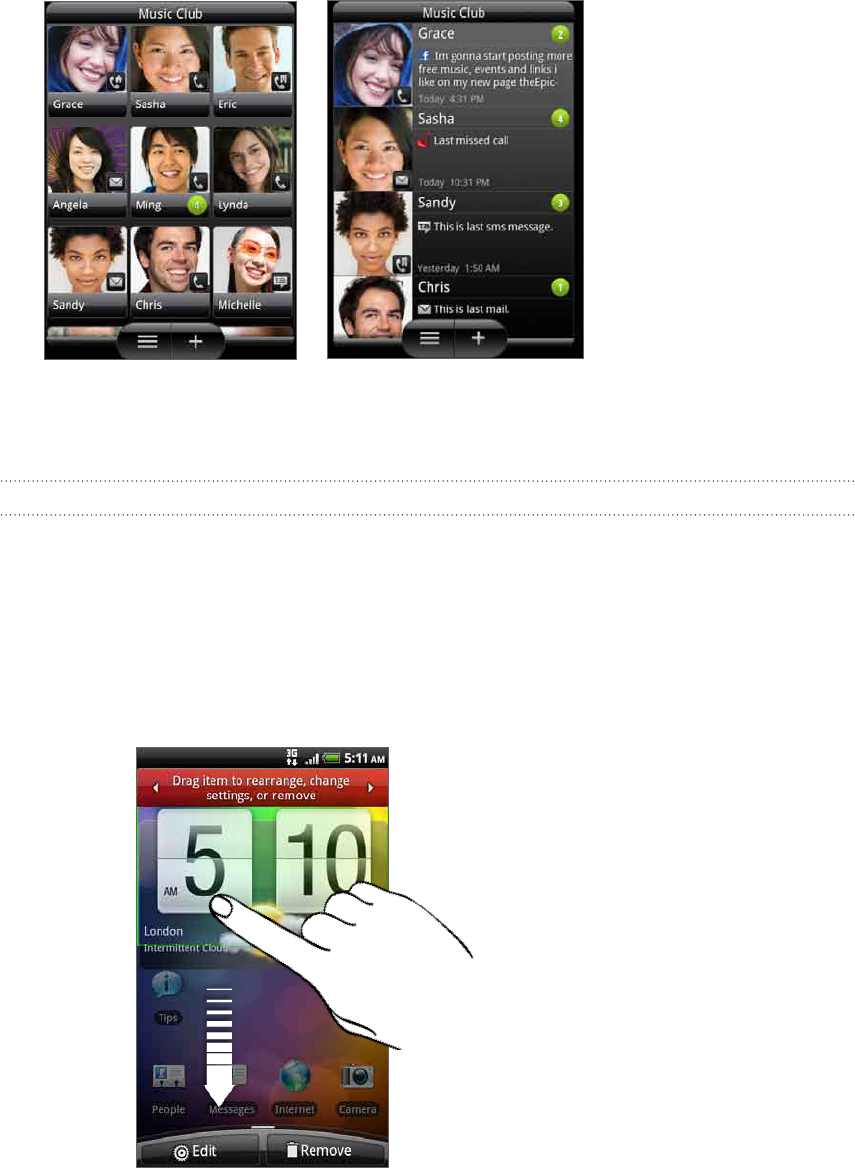
30 Personalizing
You can also add widgets that allow you to quickly switch on or off certain settings
of your phone, such as Wi-Fi, Mobile Network, Bluetooth, and more. Scroll down the
widgets list, tap Settings, and then tap the widget that you want.
Changing the settings of a widget
Basic settings of some widgets (for example, the People and Mail widgets) can be
modified from the Home screen.
1. Press and hold a widget on the Home screen.
The phone vibrates and you’ll see a colored box around the widget. Don’t lift
your finger just yet.
2. Drag the widget to the Edit button (if it’s enabled).
The relevant screen where you can change some settings for this widget then
opens.
3. Customize the widget settings.
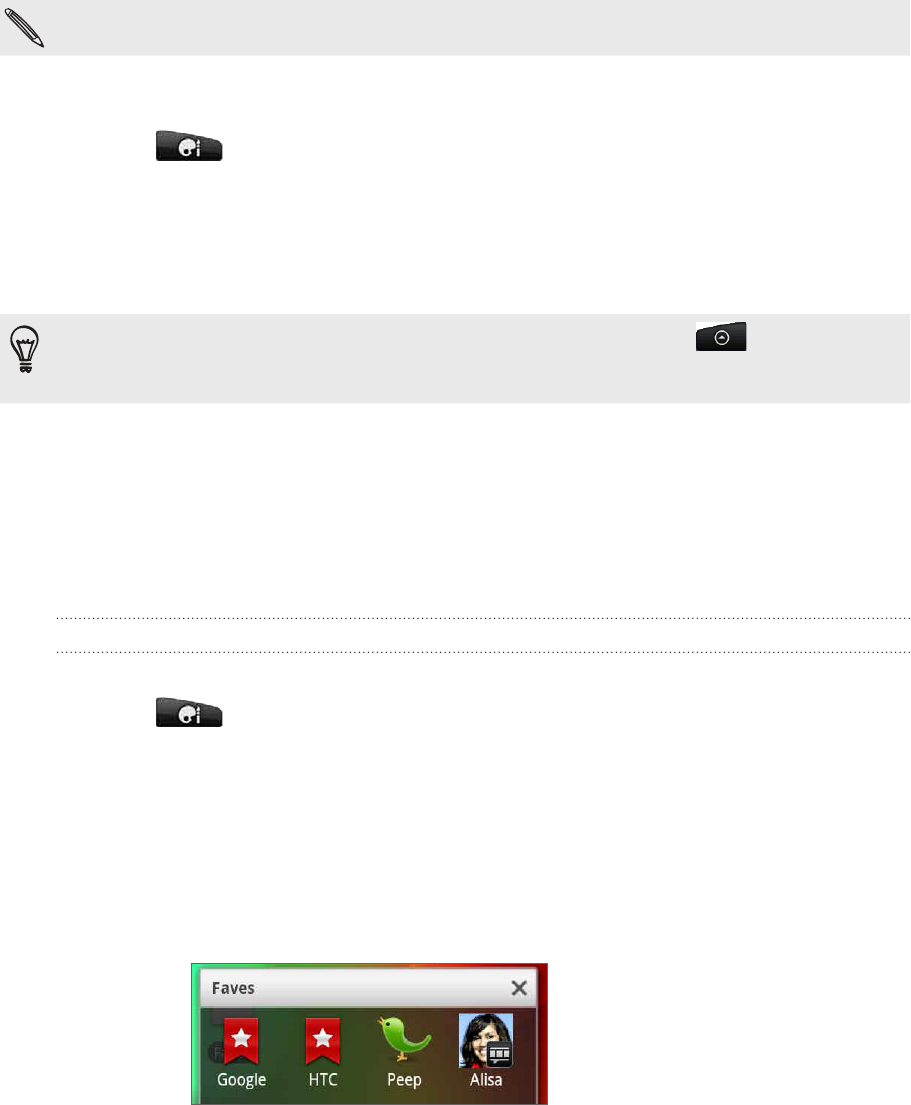
31 Personalizing
Adding icons and other shortcuts on your
Home screen
Place app icons on your Home screen to open apps quicker. You can also add
shortcuts to settings and specific information such as a bookmarked webpage,
someone’s phone number, a music playlist, route directions, and many other items, to
your Home screen.
The shortcuts available depend on the apps that are installed on your phone.
Go to a part of the Home screen where there’s space to add a new icon or
shortcut.
Tap , then do one of the following:
To add an app icon, tap App and then select one from the Add app shortcut
list.
To add a shortcut to a setting or information, tap Shortcut and then select
the type of information or setting.
To add an app icon on the Home screen, you can also press HOME, tap , and then press
and hold an app icon. Without lifting your finger, drag the icon to an empty area on the Home
screen, and then release it.
Adding folders on your Home screen
Use folders to group related apps and other shortcuts to keep your Home screen tidy
and organized. You can also add information folders that show up-to-date information
such as Bluetooth received files, your Facebook phonebook, and more.
Creating a new folder and adding items to it
Go to a part of the Home screen where there’s space to add a new folder.
Tap > Folder.
Tap New Folder.
Press and hold an app icon or a shortcut that you want to move to the folder.
The phone then vibrates. Don’t lift your finger just yet.
Drag the app icon or shortcut and drop it on top of the folder.
Simply tap the folder to open it so you can access the apps and shortcuts inside the
folder.
1.
2.
1.
2.
3.
4.
5.
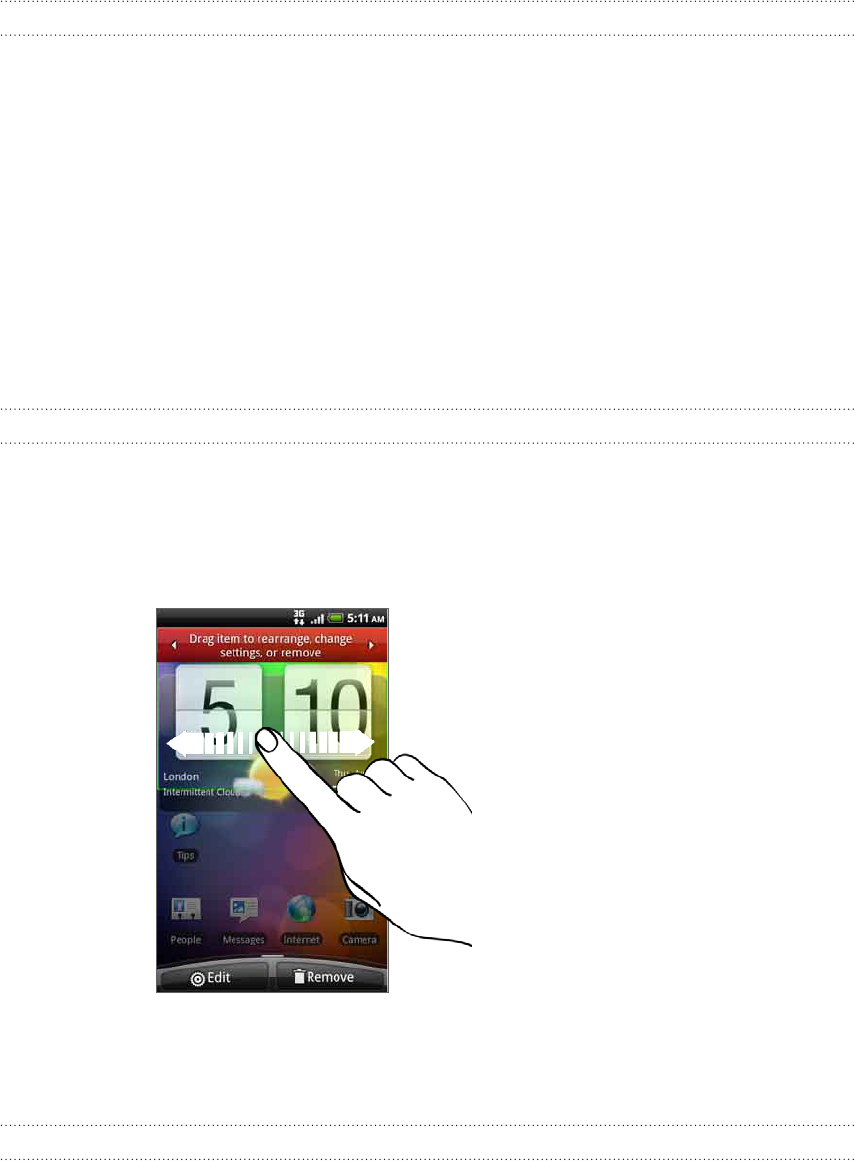
32 Personalizing
Renaming a folder
Tap the folder to open it.
Press and hold the folder window’s title bar.
Enter a new folder name and then tap OK.
Rearranging or removing widgets and icons on
your Home screen
Rearrange the widgets and icons on your Home screen to give room for adding more
items to the Home screen. You can also remove widgets and icons that you don’t
frequently use.
Moving a widget or icon
1. Press and hold the widget or icon you want to move.
The phone vibrates and you’ll see a colored box around the widget or icon. Don’t
lift your finger just yet.
2. Drag the widget or icon to a new location on the screen.
You can pause at the left or right edge of the screen to drag the widget or icon
onto another Home screen panel.
3. When the widget or icon is where you want it, lift your finger.
Removing a widget or icon
1. Press and hold the widget or icon you want to remove.
The phone vibrates and you’ll see a colored box around the widget or icon. Don’t
lift your finger just yet.
2. Drag the widget or icon to the Remove button.
3. When the widget or icon also turns red, lift your finger.
1.
2.
3.
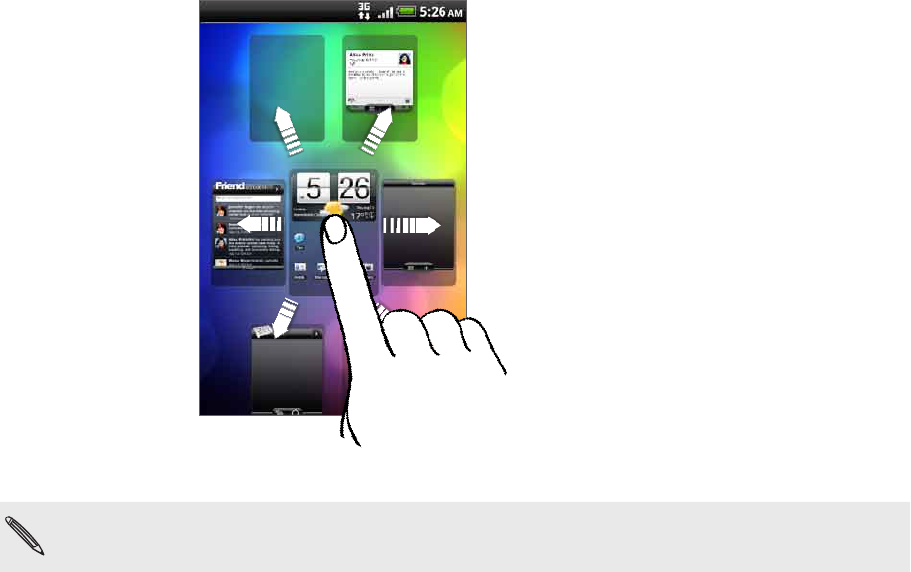
33 Personalizing
Rearranging the Home screen
Reorder your Home screen panels in any way that fits how you use the Home screen.
For example, move the panels with frequently-used widgets, shortcuts, and folders
closer to the main Home screen.
1. Pinch the Home screen to show the Leap view.
2. Press and hold the thumbnail of the home screen you want to move.
The phone then vibrates. Don’t lift your finger just yet.
3. Drag the thumbnail to its new position, and then lift your finger.
The center thumbnail in Leap view is always the main Home screen.
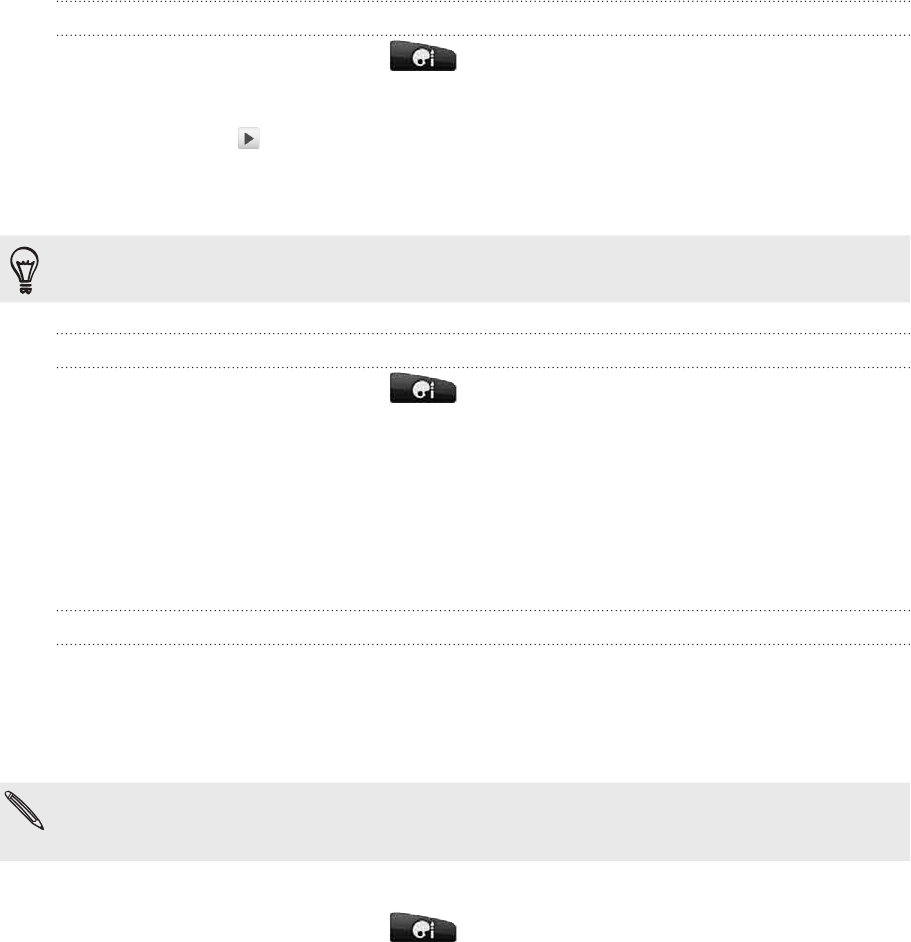
34 Personalizing
Changing your ringtones and alarms
Select, create, and download sound sets (different collections of ringtone, notification
sounds, and alarm) so that you can instantly change from subtle ringtone and
notification sounds while you’re in the office into something fun when you’re out with
friends.
Choosing a preset sound set
From the Home screen, tap > Sound set.
On the Sound sets screen, tap a sound set name.
3. You can tap to hear sample tones of the assigned ringtone, notification
sounds, and alarm for that sound set.
4. Tap Apply.
To download more sound sets, tap Get more. To know more about downloading from
HTC Hub, see the HTCSense.com chapter.
Creating a sound set
From the Home screen, tap > Sound set.
On the Sound sets screen, tap New sound set.
Enter a new sound set name, then tap Done.
The newly created sound set is then added to your phone’s list of sound sets.
To find out how to assign different tones to the sound set, see “Customizing a
sound set”.
Customizing a sound set
You can customize a sound set by applying your personal choice of ringtone,
notification sounds, and alarms that may be from your phone’s preset selection or
your storage card (except for notification sounds).
To find out how to copy files to your storage card, see the Getting started chapter.
Be sure to choose the correct sound set before changing the ringtone, notification sounds,
and alarm since your phone automatically saves your changes to the current sound set
selected.
Changing the ringtone
From the Home screen, tap > Ringtone.
2. Scroll through the available ringtones and tap the ringtone you want to use.
The ringtone briefly plays when selected.
3. If the audio file is on your storage card, tap New ringtone, select the item you
want to import to the Ringtones list, then tap OK.
4. Tap Apply.
1.
2.
1.
2.
3.
1.
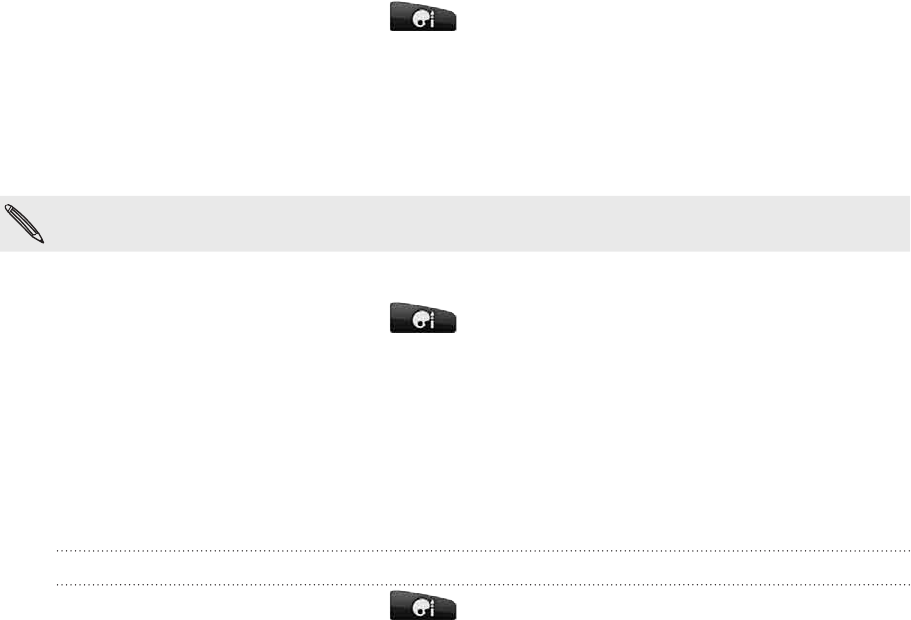
35 Personalizing
Changing the notification sounds
From the Home screen, tap > Notification sound.
2. Choose the type of notification that you want to change.
3. Scroll through the available tones and tap the item you want to use.
A sample tone briefly plays when selected.
4. Tap Apply.
Although you won’t be able to import notification sounds from your storage card, you can tap
Get more to download more audio files from HTC Hub.
Changing the alarm sound
From the Home screen, tap > Alarm.
2. Scroll through the available tones and tap the item you want to use.
A sample tone briefly plays when selected.
3. If the audio file is on your storage card, tap New alarm, select the item you want
to import to the Alarms list, then tap OK.
4. Tap Apply.
Deleting sound sets
From the Home screen, tap > Sound set.
Press MENU, and then tap Delete.
Tap one or more sound sets you want to delete.
Tap Delete.
1.
1.
1.
2.
3.
4.
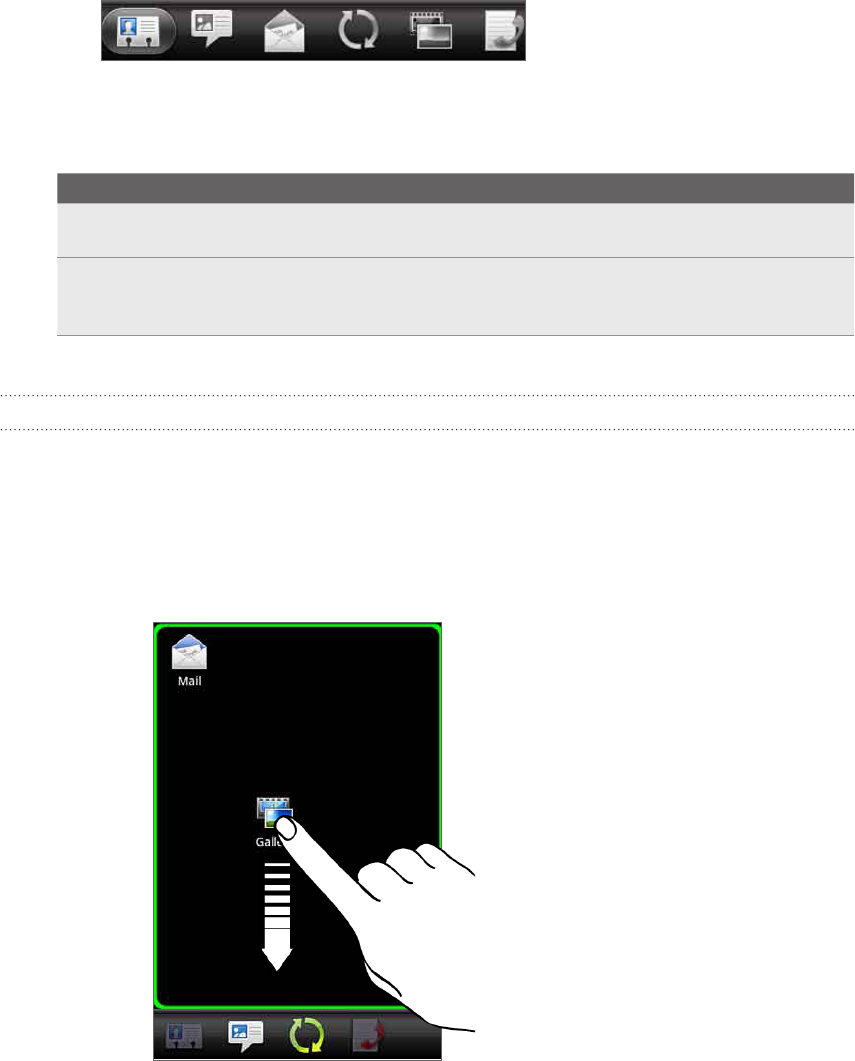
36 Personalizing
Rearranging or hiding application tabs
You can rearrange the tabs at the bottom of some of your phone’s apps to prioritize
the types of information you frequently use or remove the tabs you don’t really need.
1. Open an app that has the usual tabs at the bottom of its screen (for example,
the contact details screen in People).
2. Press and hold a tab. When the screen changes and shows you an empty area,
lift your finger.
3. Do any of the following:
To Do this
Move a tab Press and hold the tab you want to move, and then drag it to its new
position.
Remove a tab Press and hold a tab you want to hide, then drag it up. When you see a
colored box, lift your finger.
You cannot hide the tab if it’s grayed out.
4. When you’re done, press BACK.
Putting back the tabs you’ve removed
1. Open the app that you’ve previously removed some of its tabs.
2. Press and hold a tab. When the screen changes and shows you some of your
hidden tabs, lift your finger.
3. Press and hold the tab you want to show, then drag it down to where you want
to position it again.
4. When you’re done, press BACK.
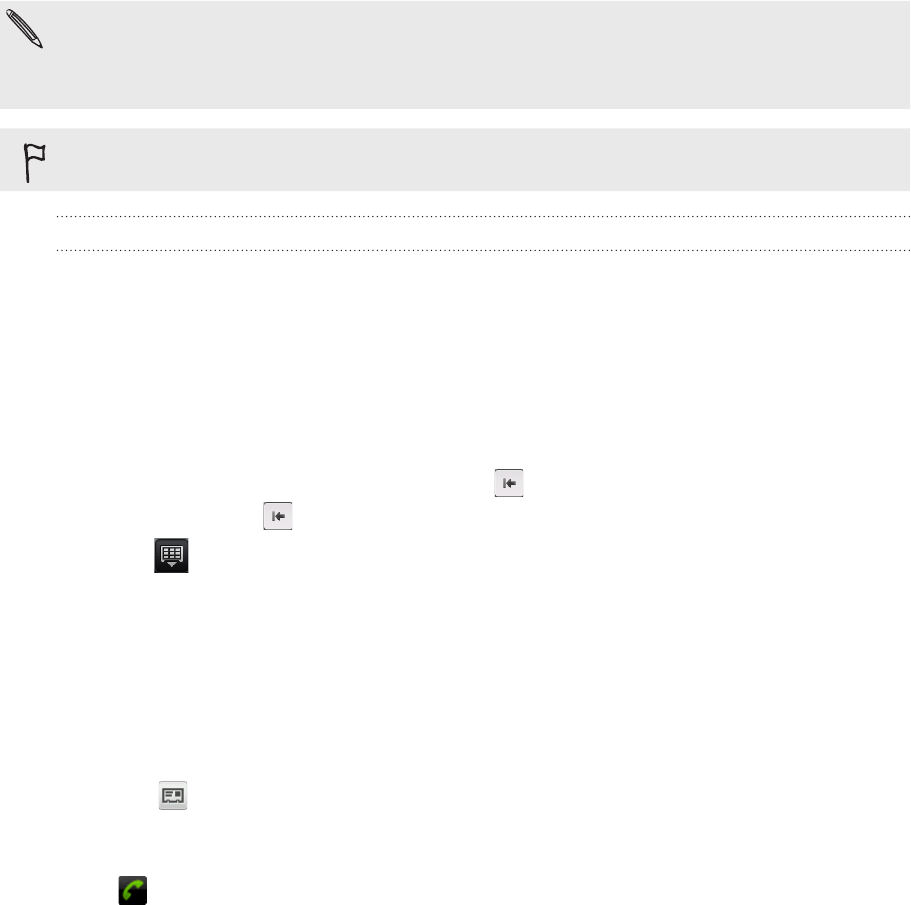
37 Phone calls
Phone calls
Making calls
Most SIM cards come with a PIN (personal identification number) set by your mobile operator.
If you’re asked for a PIN, enter it and then tap OK.
If you enter the wrong PIN three times, your SIM card is blocked. To unlock your SIM card, see
“Restoring a SIM card that has been locked out” in the Security chapter.
Your phone’s antenna is placed underneath the bottom cover. We recommend that you secure
the bottom cover to the phone’s back panel to get the best radio reception for your phone.
Making a call on the Phone dialer screen
You can either dial a number directly, or use the Smart dial feature to search and call a
stored contact or a number from your call history.
1. On the Home screen, tap Phone.
2. Begin entering the first few digits of a phone number or characters of a contact
name on the phone keypad.
The Phone dialer screen then displays a list of matching numbers and names.
If you enter a wrong digit or letter, tap to delete it. To erase the entire entry,
press and hold .
3. Tap to close the phone keypad and to see if there are more matching
numbers or contacts. To browse through the filtered list, flick through the list or
slide your finger up or down the list slowly.
4. To place a call, do one of the following:
Tap a phone number or contact from the list.
After entering a complete number, tap Call.
To call a different phone number associated with the contact, you can tap
at the right side of the contact name. On the contact details screen, tap
the number you want to call.
While dialing or when the call is in progress, the status bar displays the Call in progress
icon ( ) and its color changes to pulsing green.
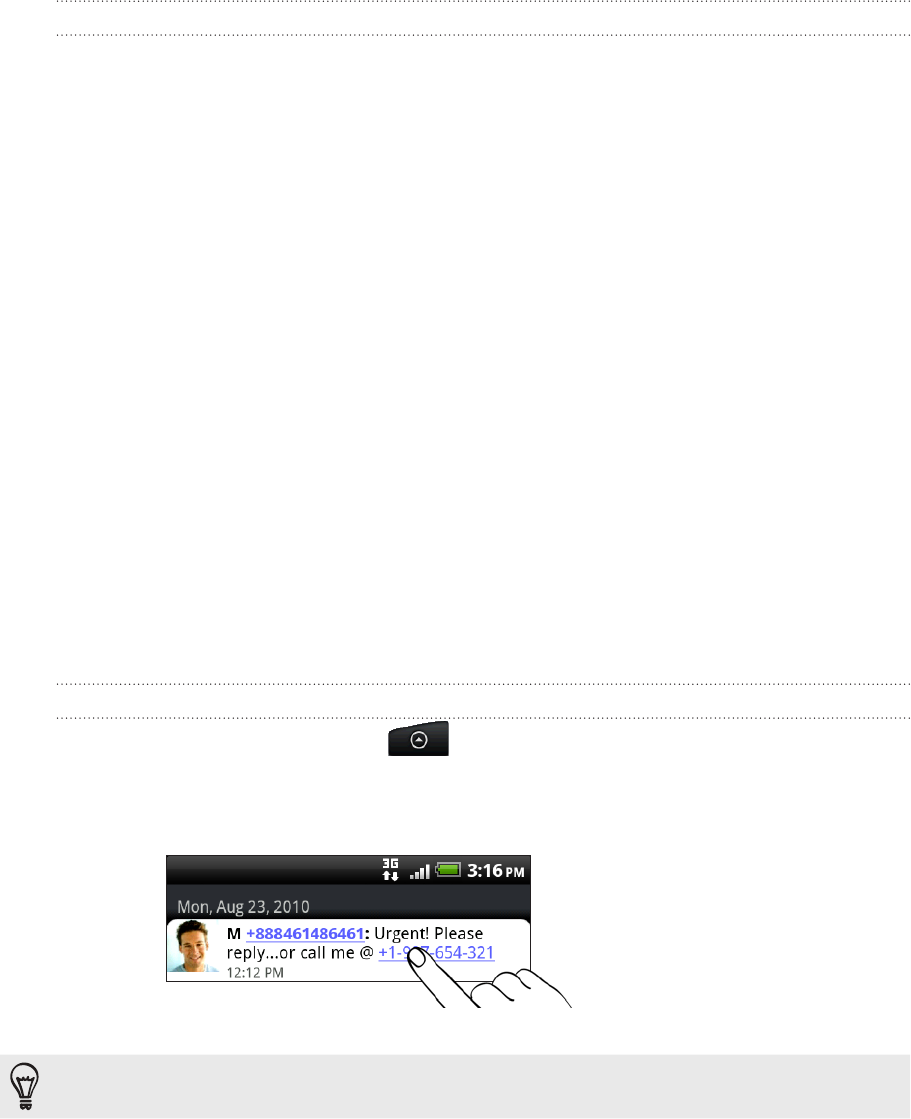
38 Phone calls
What is Smart dial?
The phone dialer’s Smart Dial feature makes it quick and easy for you to place a call.
Simply enter the phone number or first few letters of the person’s name you want
to call. Smart Dial automatically searches and filters your contacts list (stored on
your phone, SIM card, and online accounts such as Google Account and Exchange
ActiveSync) and the phone numbers from the call history.
Using Speed dial
Use Speed dial to call a phone number with a single tap. For example, if you assign a
contact’s number to the number 2 key, you can simply press and hold this key on the
Phone dialer keypad to dial that number.
Assigning a speed dial key
On the Home screen, tap Phone.
Press MENU, and then tap Speed dial > Add new.
Enter the name of the contact you want to add. When the name comes up in the
list, tap the name.
On the Speed dial screen, choose the phone number of the contact to use, and a
speed dial key to assign.
Tap Save.
Calling a speed dial number
On the Home screen, tap Phone.
On the phone keypad:
The number 1 key is generally reserved for your voicemail. Press and hold
this key to call voicemail and retrieve your voicemail messages.
Press and hold the key that is associated with the contact you want to call.
Calling a phone number in a text message
From the Home screen, tap > Messages.
Tap the number or name of the person who sent you the text message.
Tap the phone number within the message.
4. Edit the phone number if needed, and then tap Call.
To call the message sender, press and hold the sender or the received message, and then tap
Call on the options menu.
To find out more about text messaging, see the Messages chapter.
1.
2.
3.
4.
5.
1.
2.
1.
2.
3.

39 Phone calls
Calling a phone number in an email
From the Home screen, tap > Mail.
In your email account’s inbox, tap the email that contains the phone number to
call.
In the email body, tap the phone number. A selection menu then pops up and
the phone number is highlighted.
The phone will recognize a number as a phone number if the number has a
minimum of 5 digits and have at least one of the following:
Numbers starting with a plus sign (+). For example, +1-987-654-321 or
+1987654321.
Numbers starting with an area or country code enclosed in a parenthesis.
For example, (02)987654321 or (02)987-654-321.
Numbers separated by dashes. For example, (02)-987-654-321 or
0987-654-321.
4. Tap Call.
5. When the phone dialer screen opens with the phone number already entered,
tap Call.
To find out more about using email on your phone, see the Email chapter.
Making an emergency call
You can make emergency calls from your phone even if you don’t have a SIM card
installed or your SIM card has been blocked.
From the Home screen, tap Phone.
Dial the international emergency number for your locale (for example, 000),
and then tap Call.
Additional emergency numbers may be included in your SIM card. Contact your mobile
operator for details.
If you’ve enabled but forgotten your lock screen password, lock pattern, and/or the
SIM lock, you can still make emergency calls by tapping Emergency call on the screen.
1.
2.
3.
1.
2.
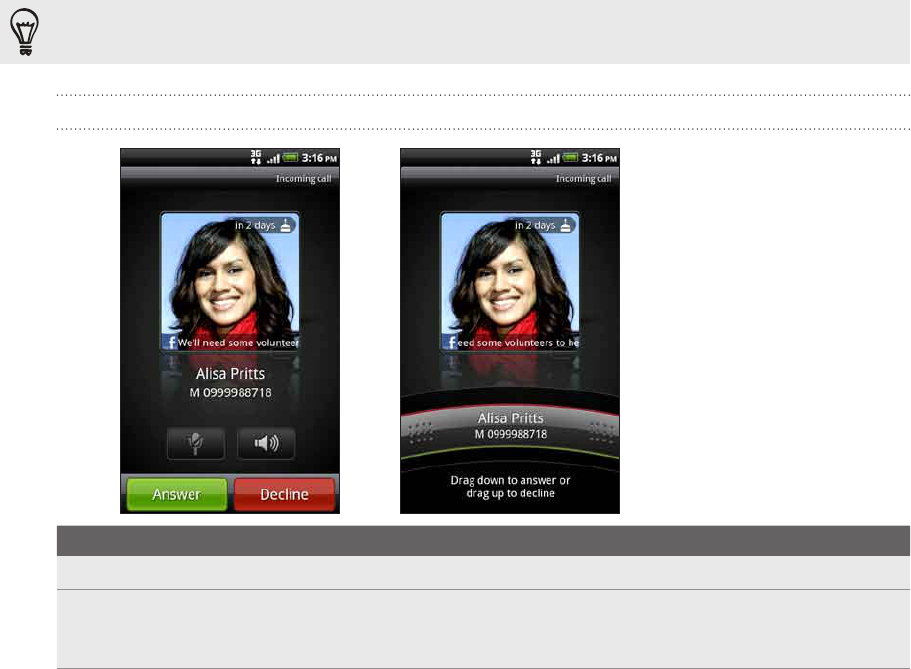
40 Phone calls
Receiving calls
When you receive a phone call from a contact, the Incoming call screen appears and
displays the caller ID icon, name, and phone number of the calling party.
When you receive a phone call from someone who is not stored in People, only the
default caller ID icon and phone number appear on the Incoming call screen.
You can use your phone’s polite ringer and pocket mode features for receiving calls. To find
out how, see “Turning on or off automatic ring volume adjustment” in the Settings chapter.
Answering or rejecting an incoming call
If To answer the call To reject the call
Display is on Tap Answer. Tap Decline.
Display is off When the Lock screen appears, drag the
bar that shows the caller name or number
downward.
Drag the bar upward.
Or, press MENU and then tap
Decline.
You can also do one of the following to reject an incoming call:
Press the POWER button twice.
To reject the call and send a text message, press MENU, and then tap Send
message.
Changing the text message to send out for rejected calls
On the Phone dialer screen, press MENU.
Tap Settings > Edit default message.
Enter the new message, and then tap OK.
1.
2.
3.

41 Phone calls
Muting the ringing sound without rejecting the call
Do one of the following:
Press the VOLUME DOWN or VOLUME UP button.
Press the POWER button.
Place the phone face down on a leveled surface.
If the phone is already facing down, the phone will still ring when there are subsequent
incoming calls.
HTC Caller ID
Everytime you make a call or your friend gives you a ring, you get to see your friend’s
latest status update from social networks like Facebook or Twitter right on the call
screen.
You also won’t miss people’s birthdays. You’ll see a birthday reminder, if your friend’s
birthday will occur sometime within the next seven days.
Using in-call options
When a call is in progress, use the buttons onscreen to mute or unmute the
microphone or to turn on or off the speakerphone. You can also press MENU and
choose whether to add a call, place the call on hold, mute the microphone, and more.
Putting a call on hold
Press MENU and then tap Hold to put the call on hold. When you put a call on hold,
the status bar displays the Hold call icon ( ) and its color changes to pulsing red.
Press MENU, and then tap Unhold to resume the call.
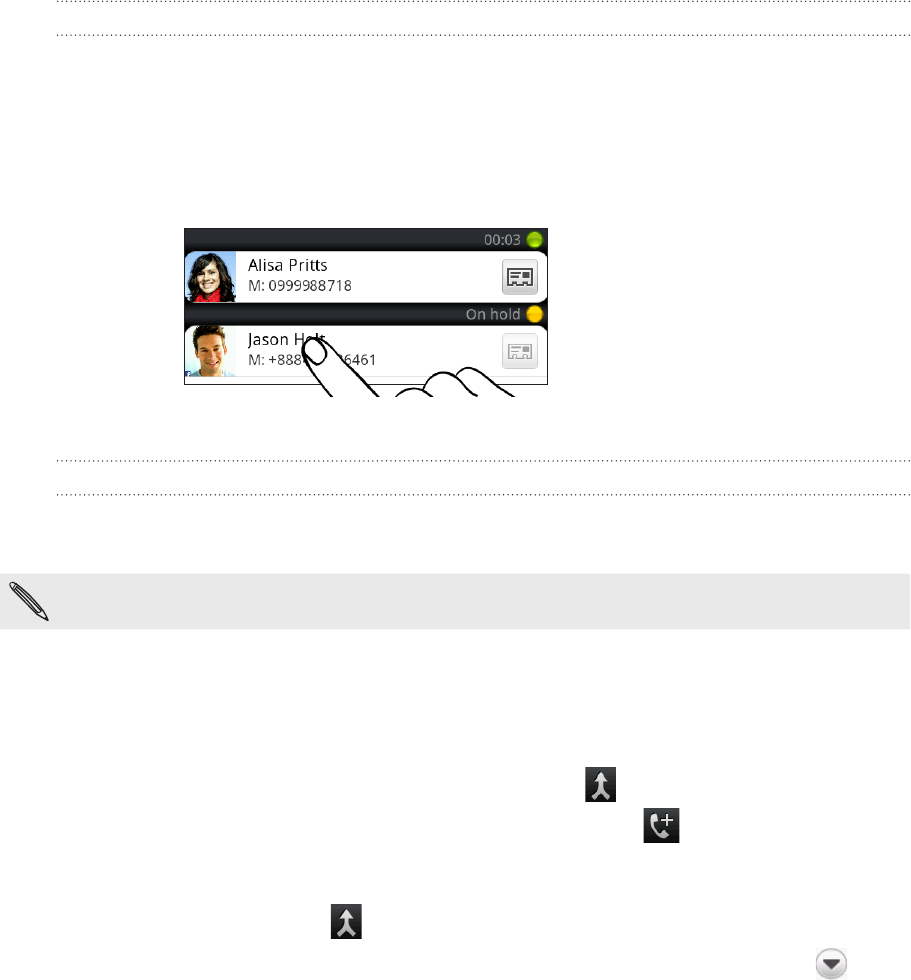
42 Phone calls
Switching between calls
If you’re already on a call and accept another call, you can choose to switch between
the two calls.
1. When you receive another call, tap Answer to accept the second call, and to put
the first call on hold.
2. To switch between the calls, tap the person you want to talk to on the screen.
3. To end the current call and return to the other call, tap End call.
Setting up a conference call
Conference calling with your friends, family, or co-workers is easy. Make the first call
(or accept a call), and then simply dial each subsequent call to add to the conference.
Make sure your SIM card is enabled with conference calling service. Contact your mobile
operator for details.
Make a call to the first conference call participant.
When connected, press MENU, tap Add call, and then dial the number of the
second participant. The first participant is put on hold when you dial the second
participant.
When connected to the second participant, tap (merge).
To add another participant to the conference call, tap on the conference
call screen, and then dial the number of the contact you want to invite to the
conference call.
5. When connected, tap to add the participant to the conference call.
When you want to talk to a person in the conference call in private, tap , and
then select Private call on the options menu.
6. When finished, tap End call.
1.
2.
3.
4.
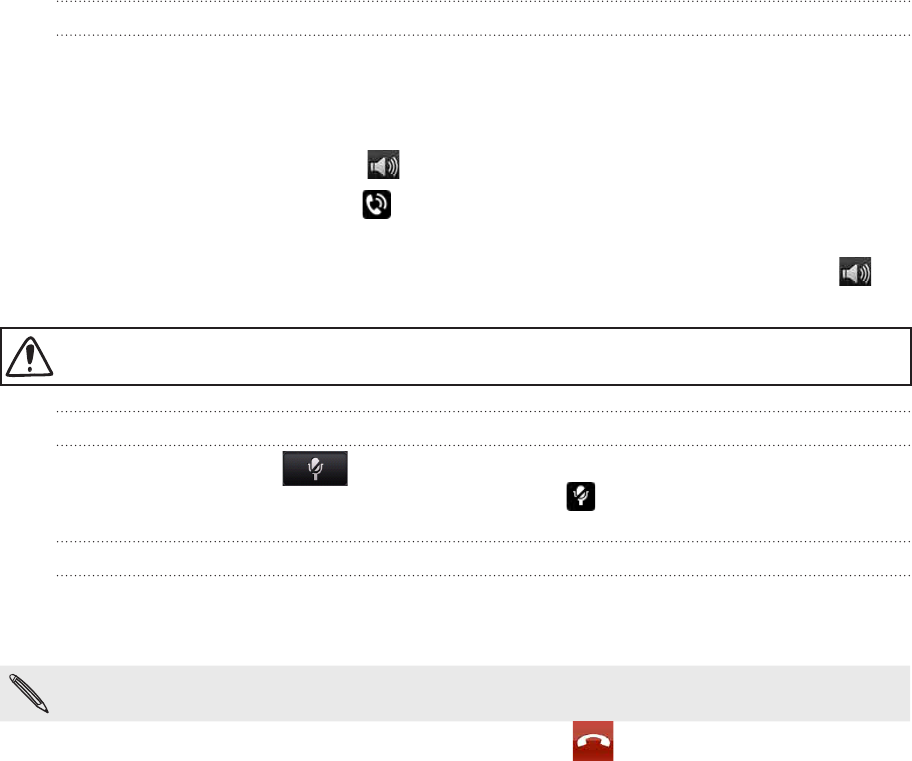
43 Phone calls
Turning the speakerphone on or off during a call
To turn the speakerphone on, you can do any of the following:
Flip your phone over during a call (be sure that Flip for speaker is selected in
HOME > MENU > Settings > Sound).
On the call screen, tap .
The speakerphone icon ( ) appears in the status bar when the speakerphone
is on.
To turn the speakerphone off, just flip the phone over again, facing it up. Or tap
again.
To decrease potential damage to your hearing, do not hold your phone against your ear when
the speakerphone is on.
Muting the microphone during a call
On the call screen, tap to toggle between turning the microphone on or off.
When the microphone is turned off, the Mute icon ( ) appears in the status bar.
Ending a call
Do one of the following to end the call:
On the call screen, tap End call.
If the phone display is off, press POWER to turn on the screen so you can tap End call.
Slide open the Notifications panel, then tap .
If you are using the provided wired headset, press the button to end the call.
If the phone number of the person who called is not in your contacts list, you can
choose to save the number to your contacts list after you hang up.
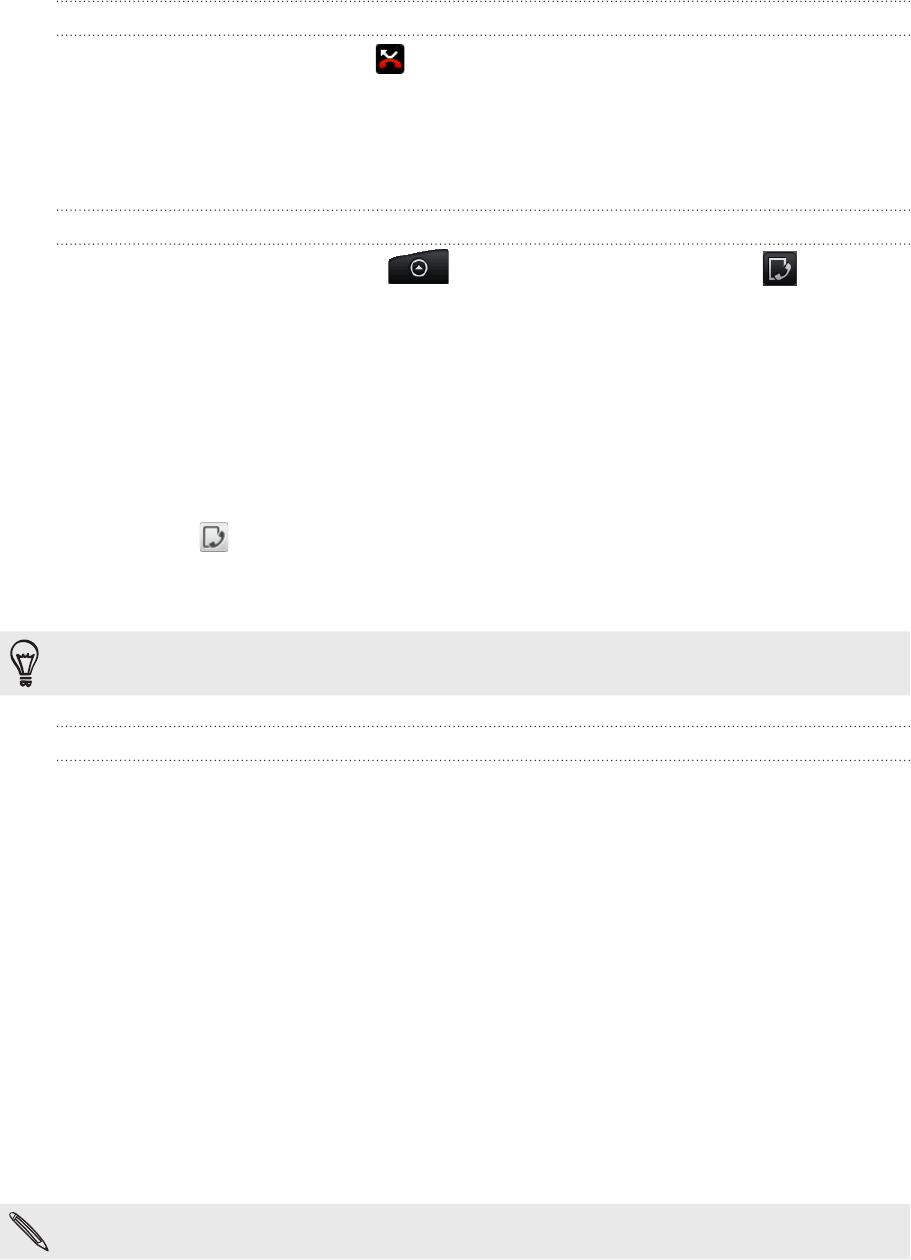
44 Phone calls
Using Call history
Use the Call history to check missed calls, your dialed numbers and received calls.
Checking a missed call
You will see the missed call icon in the status bar when you miss a call.
1. Slide open the Notifications panel to check who the caller is.
2. To return the call, tap the missed call notification. Then tap the caller’s name or
number on the Call history screen.
Checking calls in the call history
From the Home screen, tap > Call history. You can also tap on the
Phone dialer screen.
On the Call history screen, you can:
Tap a name or number in the list to call.
Press and hold a name or number in the list to display the options menu
where you can select to check the call history details, view contact
information (if the number is stored in your contacts list), send a text
message, delete from call history, or block the caller.
Tap to check only the call history of a particular contact.
Press MENU, then tap View to display just a particular type of calls such as
Missed calls or Outgoing calls.
You can also access Call history from the People app. For details, see the People chapter.
Adding a new phone number to your contacts from call history
On the Call history screen, press and hold a phone number that you want to save
to your contacts, and then tap Save to People.
2. Choose whether to create a new contact or to save the number to an existing
contact on your phone.
3. Do any of the following:
When creating a new contact, enter the contact name, contact type, and
other information in the blank contact record that appears. The phone
number is automatically added to the Mobile field in the Phone section.
To store it as another type of number, for example a home number, tap the
Mobile button.
When saving the number to an existing contact, tap a contact stored on your
phone, and then select the number type.
4. Tap Save.
To find out how to add new contacts or edit the contact information, see the People chapter.
1.
2.
1.
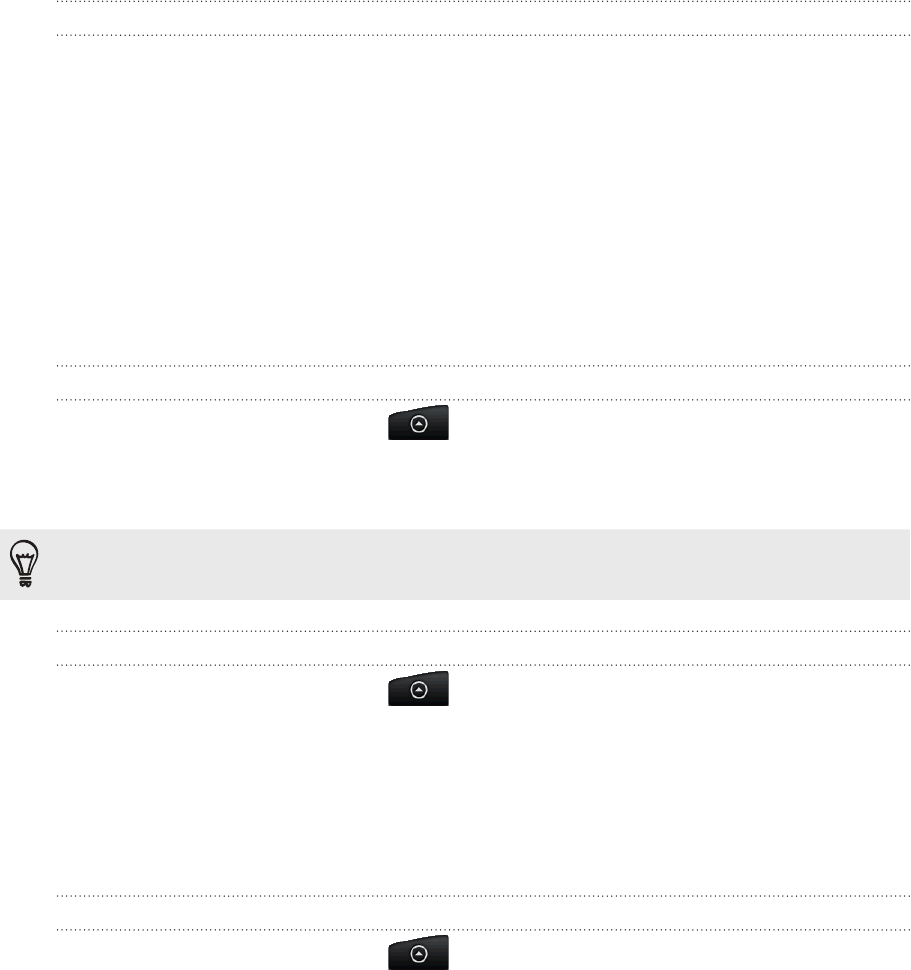
45 Phone calls
Clearing the call history list
On the Call history screen, you can do the following:
To remove one name or number from the list, press and hold the name or
number, and then tap Delete from call history.
To clear the entire list, press MENU, and then tap Delete all.
Blocking callers
When you block a phone number or a contact from calling you, all blocked calls go
directly to your voicemail.
Blocking one or more contacts from calling
From the Home screen, tap > Blocked Callers.
On the All tab, tap Add caller.
Select the contacts you want to block, then tap Save.
You can also press and hold the name or phone number in People or Call history, then tap
Block caller.
Checking your blocked call history
From the Home screen, tap > Blocked Callers.
2. Slide to the Blocked call history tab.
3. Press and hold a name or number in the list to display the options menu where
you can select to check the call history details, view the contact information (if
the number is stored in your contacts list), send a text message, or delete from
call history.
Unblocking callers
From the Home screen, tap > Blocked Callers.
2. On the All tab, press MENU, then tap Remove callers.
3. Select one or more contacts, then tap Delete.
4. When prompted, tap OK.
1.
2.
3.
1.
1.

46 Phone calls
Call services
Your phone can directly link to the mobile phone network, and enable you to access
and change the settings of various phone services for your phone. Call services
may include call forwarding, call waiting, voicemail, and more. Contact your mobile
operator to find out about the availability of call services for your phone.
To open call services, press MENU from the Home screen, and then tap Settings > Call.
Fixed Dialing Numbers Restrict outgoing calls to a fixed set of numbers. To enable this
feature, you must know your SIM card’s PIN2 code.
Voicemail service Shows the current voicemail service being used.
Voicemail settings Specify another voicemail number aside from the voice mail number
on your SIM card.
Clear voicemail
notification
If you have a notification of a new voicemail, you can clear the
notification with this option.
Phone settings Edit the call reject message, choose whether to open the message
editor when you reject a call with a message, and choose whether to
allow automatic saving of an unknown contact number when a call
with that number ends.
Cell broadcast Enable or disable receipt of cell broadcast messages from your
service provider.
Cell broadcast settings Configure channels and language for cell broadcast messages.
Call forwarding Select how you want your phone to handle busy, unanswered, and
unreachable calls. You can also set the call forwarding option for all
incoming calls.
Call barring settings Choose whether to block various categories of incoming and
outgoing call.
Additional call settings Enable or disable operator services such as caller ID and call waiting.
Turning Airplane mode on or off
In many countries, you are required by law to turn off the phone while on board an
aircraft. A way to turn off the phone function is to switch your phone to Airplane
mode. When you enable Airplane mode, all wireless radios on your phone are turned
off, including the call function, data services, Bluetooth, and Wi-Fi.
To turn Airplane mode on or off, you can:
Press and hold POWER, and then tap Airplane mode.
From the Home screen, press MENU. Tap Settings > Wireless & networks, and
then select or clear the Airplane mode check box.
When enabled, the Airplane mode icon ( ) is displayed in the status bar.
When you disable Airplane mode, the call function is turned back on and the previous state of
Bluetooth and Wi-Fi is restored.
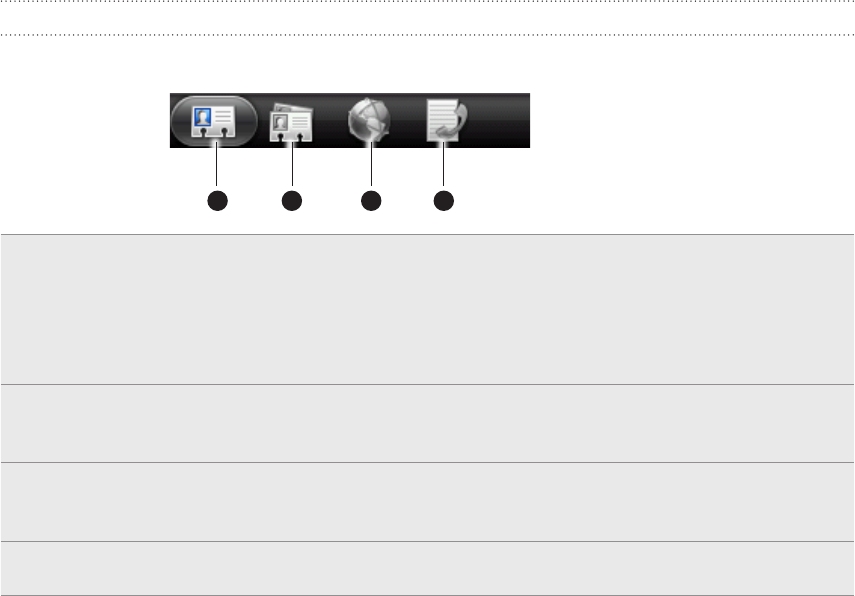
47 People
People
About People
With the People app, you can sync your phone with contacts from your Google
Account, computer, and Facebook. You can also sync with work contacts from the
Exchange ActiveSync Server in your workplace. To find out how, see “Ways of getting
contacts into your phone.”
Per contact, link the person’s information from all these different sources as one so
you won’t have duplicated entries in your contacts list. To find out how to link, see
“Merging contact information.”
And that’s not all. You can manage your communications with your contacts via
phone, messaging, and email without the need to jump from one app to another. After
you’ve linked contacts to their social network accounts like Facebook, Twitter, and
Flickr, you’ll also see their updates and events from these accounts all in one place.
People screen
The People screen has the following tabs:
2 3 4
1
1 All tab Gives you access to all contacts on your phone, including Google
contacts, Exchange ActiveSync contacts, Phone contacts,
contacts stored on your SIM card, and Facebook contacts.
You can also use this tab to open or update My contact card.
For more information, see “Setting up My contact card” in this
chapter.
2 Groups tab Lets you assign contacts to groups so you can easily send
an SMS, MMS, or email message to a whole group. For more
information, see “Contact groups” in this chapter.
3 Online directories tab View your friends list in your social network accounts. You can
also search for contacts in your Exchange ActiveSync account to
copy to your phone.
4 Call history tab Lists all your dialed numbers and received and missed calls. See
“Using Call history” in the Phone calls chapter.
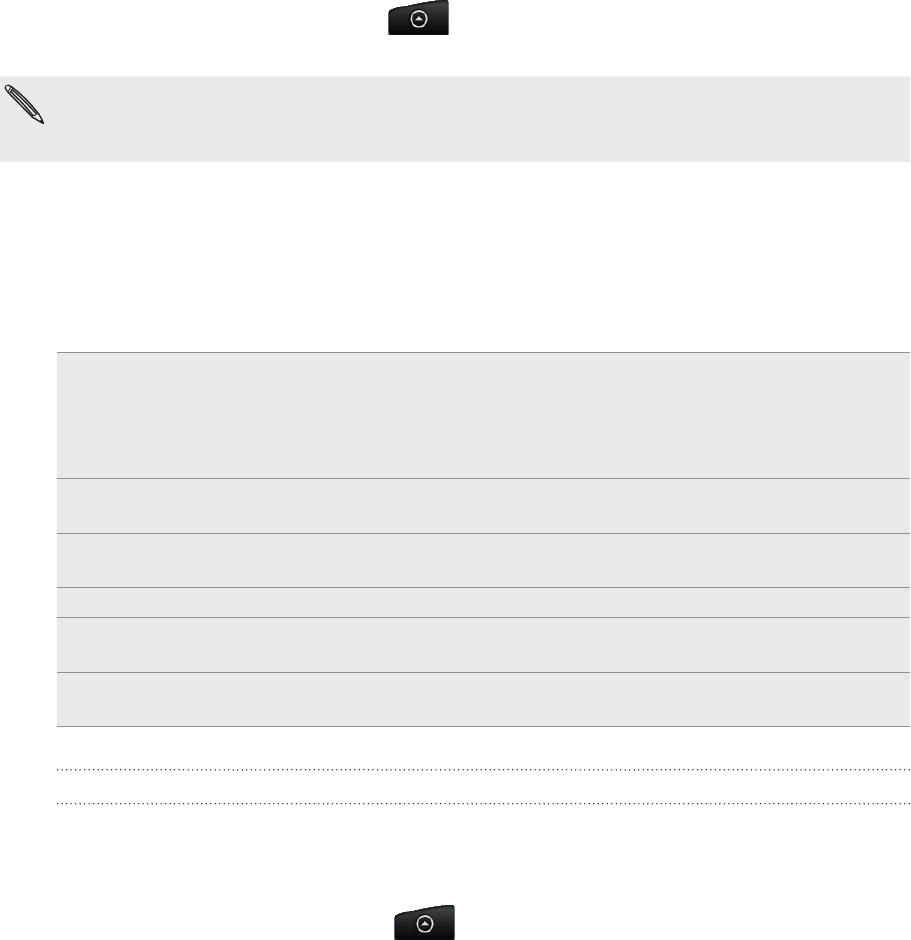
48 People
Setting up My contact card
My contact card provides a convenient way to store your personal contact information
so that you can easily send it via SMS, MMS, email, or Bluetooth.
From the Home screen, tap > People.
On the All tab of the People screen, tap Me.
If you are logged in to your Facebook account through Facebook for HTC Sense, instead of
Me, you will see the name you use in Facebook. Tap your name. Then press MENU and tap
Edit.
3. Enter your name and contact details.
4. Tap Save.
Ways of getting contacts into your phone
Gmail/Google Mail Google contacts are imported to your phone after you sign in to
your Google Account.
You can also create more Google contacts right from your
phone. To find out how, see “Adding a new contact“ in this
chapter.
Facebook See “Adding a social network account” in the Accounts and sync
chapter for details.
Phone contacts See “Transferring contacts from your old phone” and “Adding a
new contact“ in this chapter.
SIM card See “Importing contacts from your SIM card” in this chapter.
Exchange ActiveSync
Server
See “Adding a Microsoft Exchange ActiveSync account” in the
Email chapter.
Contacts on your computer See “Synchronizing with your computer” in the Accounts and
sync chapter.
Transferring contacts from your old phone
Easily transfer contacts from your old phone to your new HTC phone through
Bluetooth. Depending on your old phone’s model, you may also transfer other types of
data such as calendar events and text messages to your phone.
From the Home screen, tap > Transfer Data.
Tap Next to begin.
To check whether your old phone is supported, select a manufacturer name and
phone model.
If supported, turn your old phone’s Bluetooth on and set it to discoverable mode,
then tap Next to continue.
Your new HTC phone automatically turns Bluetooth on and searches for
Bluetooth devices.
5. From the device list, select your old phone and then tap Next.
1.
2.
1.
2.
3.
4.
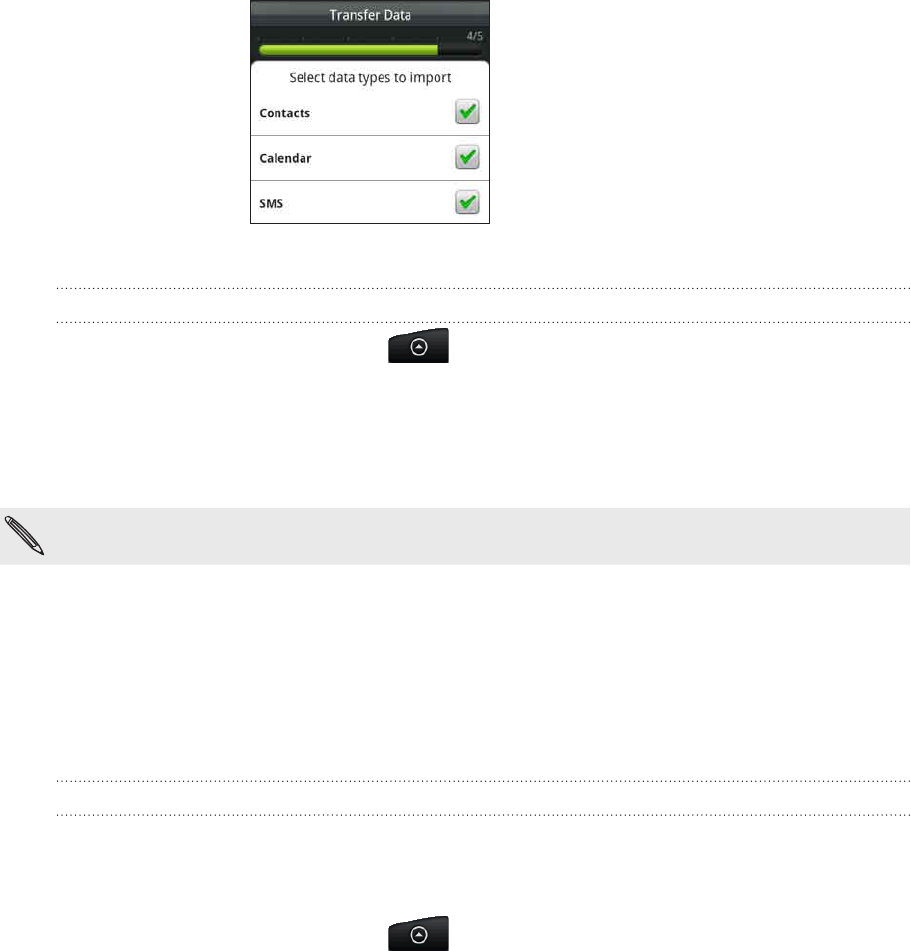
49 People
Your new HTC phone then tries to pair with your old phone. You’ll then see a
security passkey on the Transfer Data screen.
6. On your old phone, enter this passkey or simply confirm it.
7. Select the Contacts check box (and other supported types of data you want
to import), and then tap Next.
8. When your new HTC phone finishes importing data, tap Done.
Adding a new contact
From the Home screen, tap > People.
On the All tab, tap Add contact.
3. Select the Contact type, for example Google or Microsoft Exchange ActiveSync.
This determines which account the contact will sync with. For more information,
see “Ways of getting contacts into your phone” in this chapter.
Some fields may not be supported when you’re adding contacts to your SIM card.
4. In the Name field, enter the first and last name of the contact, then tap OK.
5. Enter the contact information in the fields provided.
Press BACK if you want to close the onscreen keyboard first and easily scroll
through the other fields.
6. Tap Save.
Importing contacts from your SIM card
You can copy all your SIM contacts to your phone. You can import them as Phone
contacts, Google contacts, or Exchange ActiveSync contacts, if you have set up the
relevant accounts.
From the Home screen, tap > People.
On the All tab, press MENU, and then tap Import/Export > Import from SIM card.
If you have Google or Exchange ActiveSync accounts set up on your phone, tap
the type for the imported contacts.
Do one of the following:
To import all contacts, press MENU, and then tap Select all.
To import a contact, tap the contact.
5. Tap Save.
1.
2.
1.
2.
3.
4.
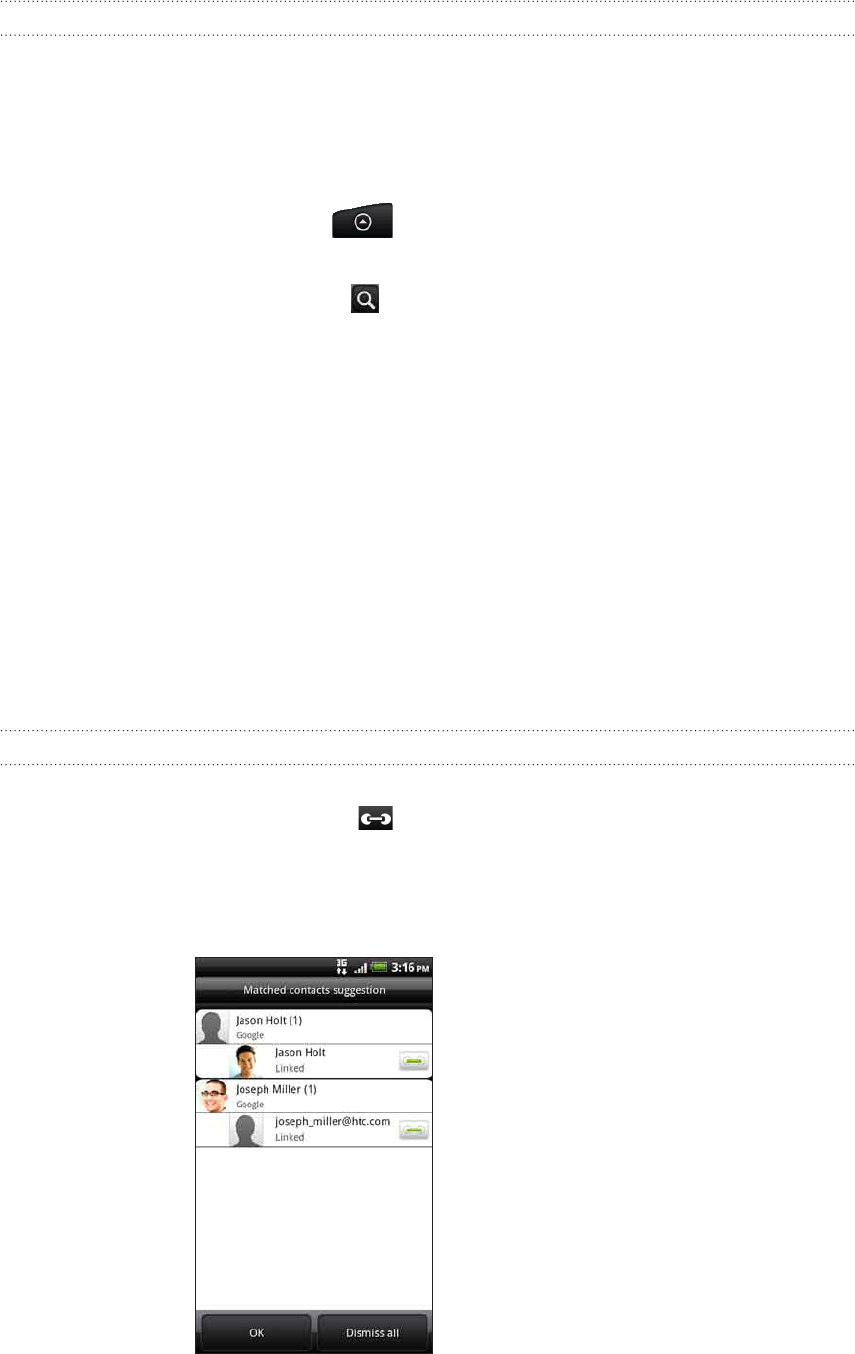
50 People
Importing a contact from an Exchange ActiveSync account
You can search for a work contact from your Exchange ActiveSync account, and then
copy it to your phone.
You need to have your Exchange ActiveSync account set up on your phone first. To
find out how, see “Adding a Microsoft Exchange ActiveSync account“ in the Email
chapter.
From the Home screen, tap > People.
On the Online directories tab, tap Company directory.
Enter the name, and then tap .
In the list, tap the name of the contact you want to copy to your phone.
Tap Save to People.
Merging contact information
If you have stored contacts with the similar contact information such as name, email
address, or mobile number in your phone and online accounts, your phone will try to
link them as one automatically or create a list of matched contact suggestions. If it
doesn’t, you can manually link them so that you won’t have duplicated entries in your
contacts list.
Also link your contacts with other social network accounts such as Twitter and Flickr.
You’ll then see their updates and events from these accounts all in one place.
Accepting matched contacts suggestions
When your phone finds contact information that can be merged, you’ll see the
Matched contact suggestions icon ( ) in the notification area of the status bar.
Slide down the Notifications panel, and then tap Matched contacts suggestion.
Your phone displays all suggested contacts that you can merge.
Review the suggested links.
1.
2.
3.
4.
5.
1.
2.
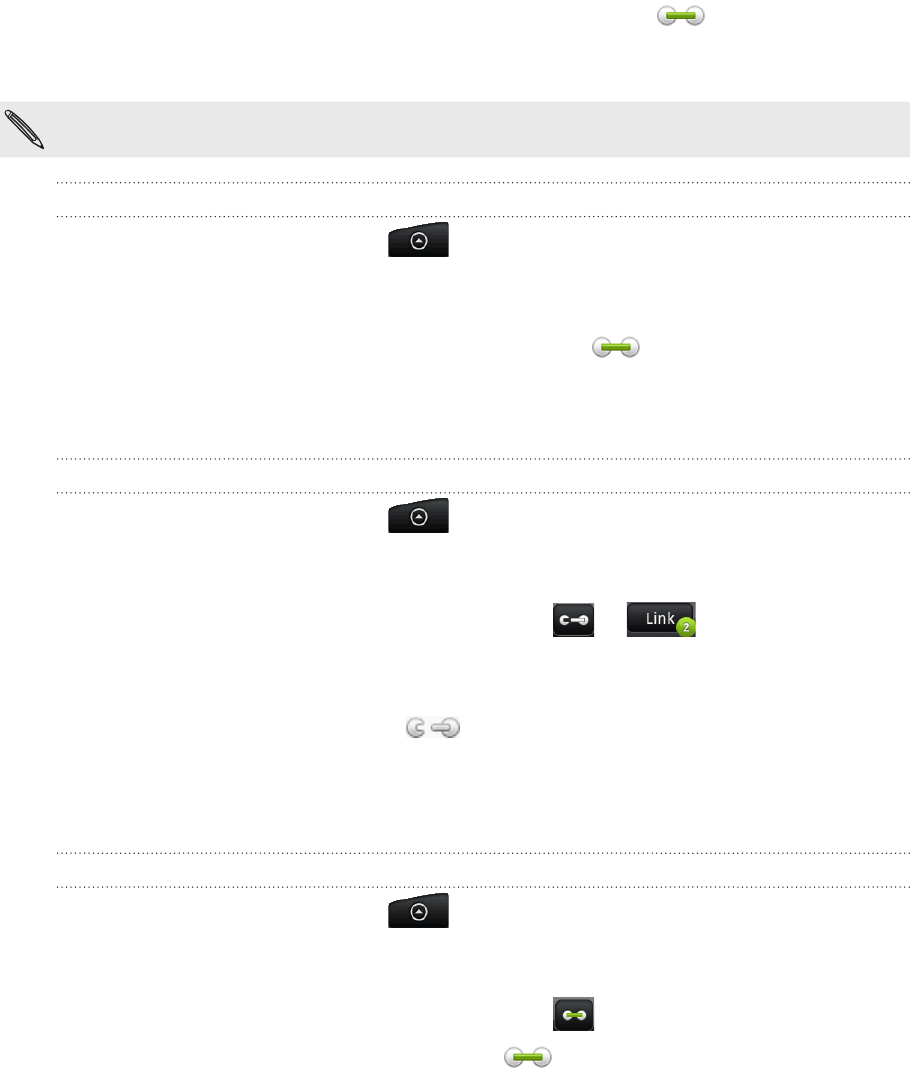
51 People
3. When there are contacts you don’t want to merge, tap to break the
contact information link.
4. Tap OK.
If you don’t want to merge any of your contacts, tap Dismiss all.
Viewing a list of all your linked contacts
From the Home screen, tap > People.
On the All tab, press MENU, then tap More > Linked contacts.
The All linked contacts list then opens where you can check the account types
and information merged. You can choose to tap beside an account type to
break the link.
3. When you’re done, tap OK.
Manually merging contact information
From the Home screen, tap > People.
On the All tab, tap the name of the contact (not the icon or photo) you want to
link.
On the upper-right corner of the screen, tap or (if there are
suggested links).
4. On the screen, you can:
Under Suggest links, tap to link the contact to an account.
Under Add contact, tap one of the options to link to another contact.
5. Tap Done.
Breaking the contact information link between contacts
From the Home screen, tap > People.
On the All tab, tap the name of the contact (not the icon or photo) whose
contact information link you want to break.
On the upper-right corner of the screen, tap .
Under the Linked contacts section, tap beside an account type to break
the link.
Tap Done.
1.
2.
1.
2.
3.
1.
2.
3.
4.
5.
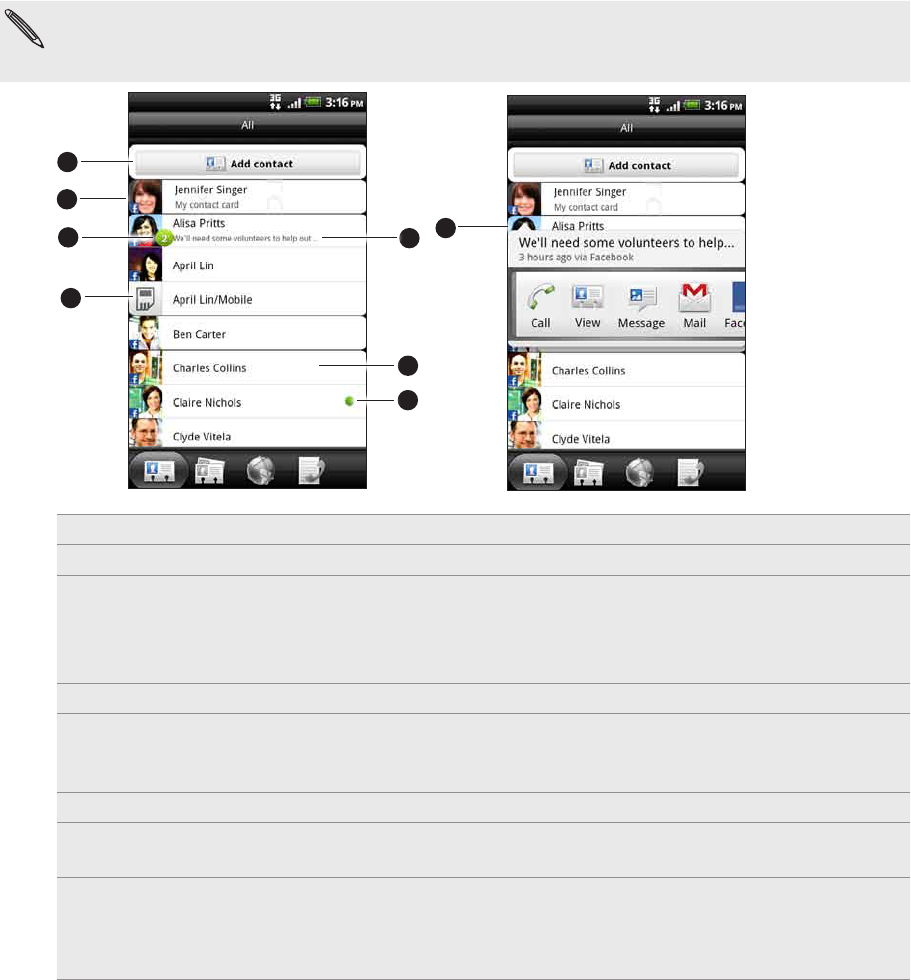
52 People
Your contacts list
The All tab of the People screen shows all your contacts, including Google contacts,
Exchange ActiveSync contacts, Phone contacts, contacts stored on your SIM card, and
Facebook contacts.
If you signed in to your Google Account and Facebook account when you first set up the
phone, your contacts from those accounts will appear in the contacts list when you open
People.
7
2
3
4
5
6
1
8
1 Create a new contact.
2 Tap to edit your My contact card.
3 This icon appears when the contact:
Has sent you a new text or email message, or tried to call you but you missed the call.
Has updated his or her Facebook profile or has added photos on Flickr or Facebook.
Has upcoming Facebook events or birthday.
4 SIM card contact
5 Online status of a contact whom you are friends with in Google Talk. Online status icons
are displayed if you’re signed in to Google Talk using your Google Account. For details, see
“Chatting in Google Talk” in the Social chapter.
6 Tap to open the contact details screen for that contact.
7 Instant status update appears when you’ve linked the contact to his or her social network
account.
8 Tap the photo or icon to open a menu where you can quickly choose how to communicate
with the contact. Depending on the contact information stored, you can call, send a
message or email, see the contact’s Facebook profile, and map his/her address in Google
Maps.
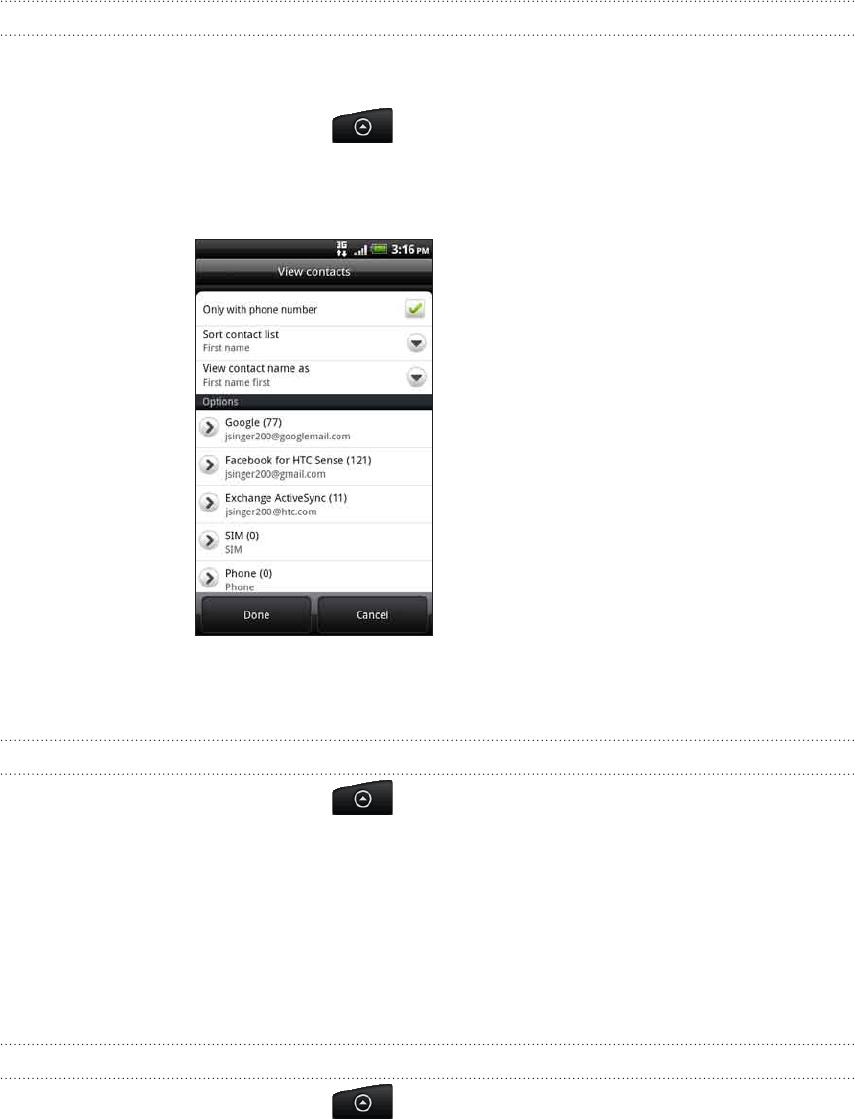
53 People
Filtering your contacts list
You can choose to display contacts of a particular type only, for example Google
contacts or Facebook contacts.
From the Home screen, tap > People.
On the All tab, press MENU, then tap View.
Select the types of contacts you want to show in your contacts list.
You can also choose how you want to display and sort your contacts.
4. Tap Done.
Searching for a contact
From the Home screen, tap > People.
Press SEARCH, then enter the first few letters of a contact’s first or last name,
email, or company name.
You can also type in the first few digits of your contact’s phone number.
Matching contacts are displayed.
3. Tap the contact to open his or her contact details screen. See “Contact
information and conversations” in this chapter for details.
Backing up your contacts to the storage card
From the Home screen, tap > People.
Press MENU, and then tap Import/Export > Export to SD card.
Select an account or type of contacts to export, then tap OK.
1.
2.
3.
1.
2.
1.
2.
3.
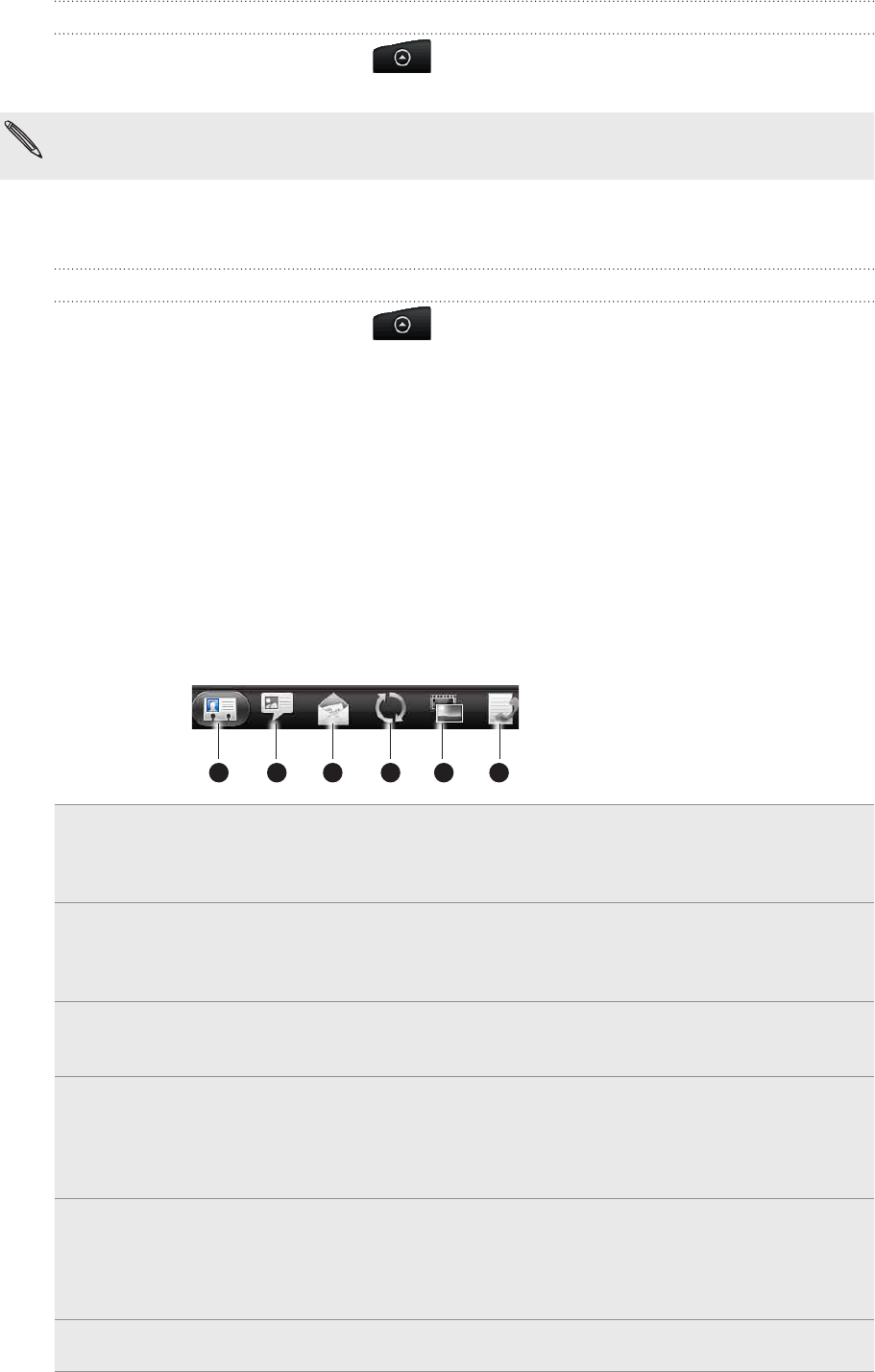
54 People
Importing contacts from the storage card
From the Home screen, tap > People.
Press MENU, and then tap Import/Export > Import from SD card.
You can only import contacts that were exported to the storage card using the Export to SD
card feature on the phone. See “Backing up your contacts to the storage card.”
3. If you have Google or Exchange ActiveSync accounts set up on your phone, tap
the type for the imported contacts.
Deleting contacts
From the Home screen, tap > People.
On the All tab, press MENU, and then tap Delete.
Select the contacts you want to delete, and then tap Delete.
When prompted, tap OK.
Contact information and conversations
When you tap a contact on the People screen, the contact details screen opens,
showing you the information stored for that contact, exchanged messages and phone
calls with that contact, updates and events from social networks, and more.
The contact details screen has the following tabs:
2 3 45 61
1 Details tab Shows the information you have stored for the contact, and allows you
to get in touch with the contact directly by tapping any of the displayed
methods. For example, if the contact has a stored work phone number,
tap Call work to call that number.
2 Messages tab Shows your exchanged SMS messages with the contact. You can reply
to the contact’s message directly from this tab. To send a new message,
press MENU, and then tap New message. See the Messages chapter for
details.
3 Mail tab Shows all the email you have received from the contact. Tap an email
to view it. To send a new email, tap New mail. To find out more about
sending email, see the Email chapter.
4 Updates and
events tab
Shows the contact’s updates and events from social network accounts
like Facebook, Twitter, and Flickr.
You’ll be able to see updates such as posted status messages, uploads,
and profile changes from all these accounts. To find out more about
Facebook for HTC Sense, see the Social chapter.
5 Gallery tab Shows the contact’s Facebook and Flickr photo albums. Tap an album to
look at the photos in the album.
You need to be logged in to the same social networks on your phone to
see the updates and events. If you are not logged in, tap the relevant link
on the screen to sign in.
6 Call history tab Call history tab Lists all your incoming, outgoing, and missed calls to and from the
contact. Tap a list item to call the contact using the displayed number.
1.
2.
1.
2.
3.
4.
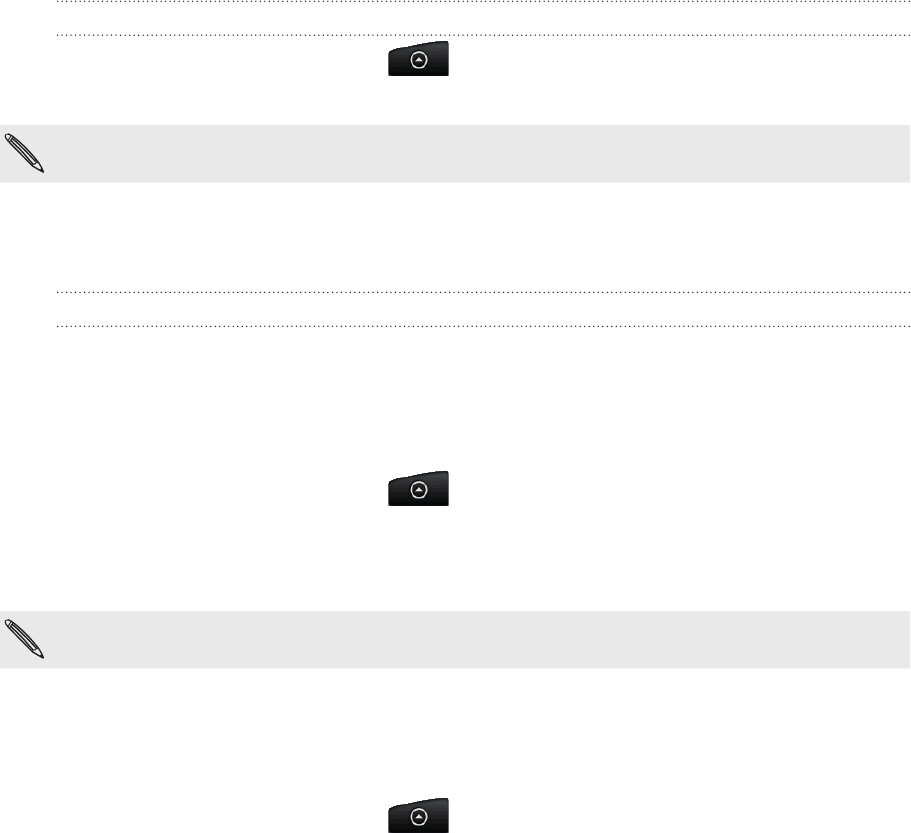
55 People
Editing a contact’s information
From the Home screen, tap > People.
On the All tab, press and hold the contact, and then tap Edit contact.
You cannot edit the contact information of a Facebook friend.
3. Enter the new information for the contact.
4. Tap Save.
Sending contact information as a vCard
Share the contact information on your phone in different ways such as a text or
multimedia message, email, and Bluetooth. To find out about how to send through
Bluetooth, see the Bluetooth chapter.
Sending someone’s contact information
From the Home screen, tap > People.
On the All tab, press and hold the name of the contact (not the icon or photo)
whose contact information you want to send, and then tap Send contact as
vCard.
You cannot send contact information that’s from your Facebook account.
3. Choose how you want to send it.
4. Select the contact details you want to share, and then tap Send.
Sending your contact information
From the Home screen, tap > People.
On the All tab, tap [Your name] My contact card.
Press MENU, then tap Send my contact info.
Choose how you want to send it.
5. Select the contact details you want to share, and then tap Send.
1.
2.
1.
2.
1.
2.
3.
4.
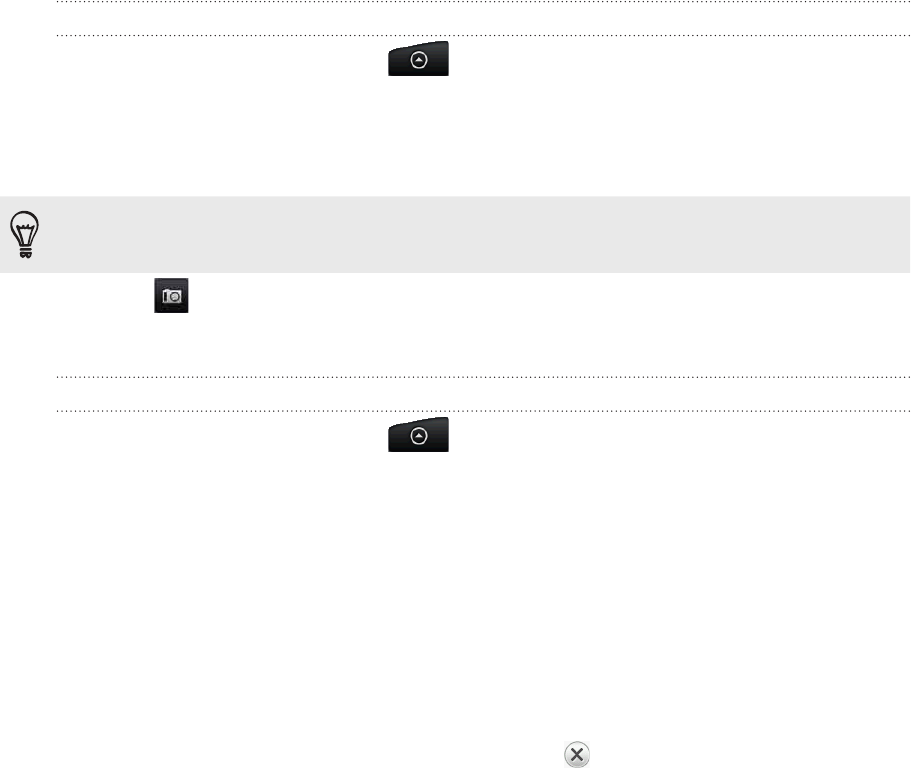
56 People
Contact groups
Assign contacts to groups so you can easily send a message or email to a whole
group. You can also sync groups on your phone with the groups in your Google
account, accessible via your computer’s web browser.
We’ve also added the Frequent group as a special group type that automatically adds
the contacts you frequently dial or get calls from as its members.
Creating a group
From the Home screen, tap > People.
On the Groups tab, tap Add group.
Enter a name for the group, and then tap Add contact to group.
Select the contacts you want to add to the group, and then tap Save.
If your contacts list is long, you can use the search bar to search for contacts quickly, or press
BACK to hide the onscreen keyboard and scroll through the list.
5. Tap to select a photo for the group.
6. Tap Save.
Editing a contact group
From the Home screen, tap > People.
On the Groups tab, press and hold the group, and then tap Edit group.
You can:
Tap the group name to change the name. You can only change the name for
groups that you have created.
Tap the icon to the left of the group name to change or remove the group
photo.
To add contacts to the group, tap Add contact to group, select the contacts
you want to add, and then tap Save.
To remove a contact from the group, tap at the right side of the contact
name.
4. Tap Save.
1.
2.
3.
4.
1.
2.
3.
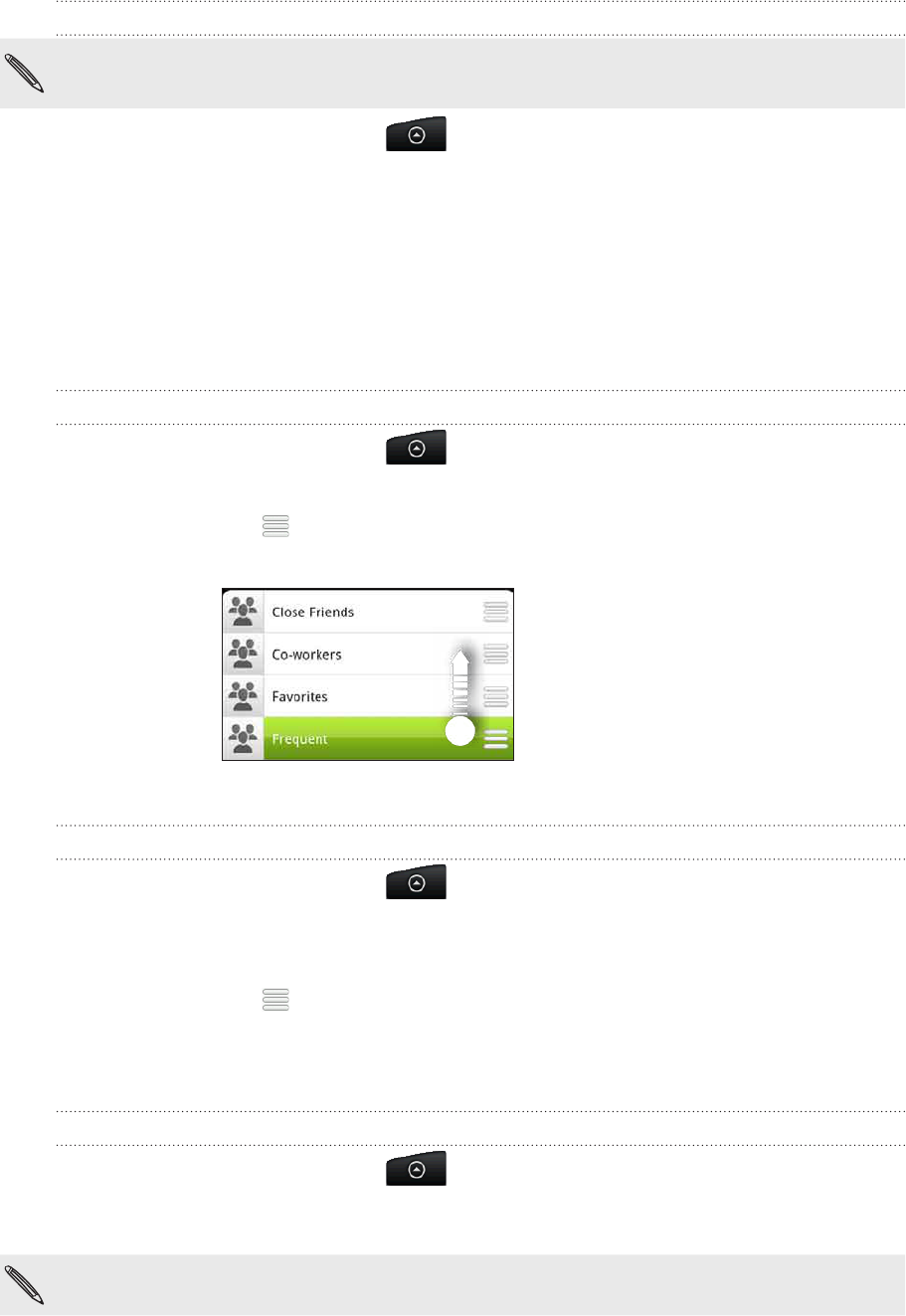
57 People
Sending a message or email to a group
You will be charged by your mobile provider for each message sent. For example, if you send a
message to a group of five people, you will be charged for five messages.
From the Home screen, tap > People.
On the Groups tab, tap the group you want to send a message or email to.
3. Go to the Group action tab, and then do one of the following:
Tap Send group message to send a message to the group. For information
about composing and sending messages, see the Messages chapter.
Tap Send group mail to send an email to the group. For information on
composing and sending email, see the Email chapter.
Rearranging your contact groups
From the Home screen, tap > People.
On the Groups tab, press MENU, and then tap Rearrange.
Press and hold at the end of the group name you want to move. When the
row is highlighted, drag it to its new position.
4. Tap Save.
Rearranging the members of a contact group
From the Home screen, tap > People.
On the Groups tab, tap the group to see its members.
Press MENU, and then tap Rearrange.
Press and hold at the end of the contact’s name you want to move. When the
row is highlighted, drag it to its new position.
Tap Save.
Deleting a group
From the Home screen, tap > People.
On the Groups tab, press and hold the group you want to delete, and then tap
Delete group.
You can only delete groups that you have created.
1.
2.
1.
2.
3.
1.
2.
3.
4.
5.
1.
2.

58 People
People widget
Put the group of people you contact most right on the Home screen of your phone by
adding them as the People widget. Using the People widget, you can instantly place a
call, send a message, or view details of a favorite contact with a single tap.
Adding People widgets
Stay in touch with different circles of friends or colleagues in your life. You can add
several People widgets on the Home screen, with a different group of contacts on
each widget.
From the Home screen, tap > Widget > People.
Choose the widget style, and then tap Select.
Select the group you want to add as a widget.
Drag the widget to a blank space on a Home screen. When the widget is where
you want it, lift your finger.
5. Repeat the above steps to add another People widget.
Setting the default communication method
On the Home screen, go to the People widget.
Tap a contact on the widget.
On the Select default action screen, tap the communication method you want
for the contact.
Changing the default communication method
On the Home screen, go to the People widget.
Tap the name of a contact on the widget to open the person’s contact card.
Press MENU, and then tap More > Set widget action.
On the Select default action screen, tap the communication method you want
for the contact.
Getting in touch with a contact
On the Home screen, go to the People widget.
Tap a contact (photo not the name) on the widget. The default communication
method will be performed.
If you have not set a default communication method, you need to choose one
first. See “Setting the default communication method.”
Tap the name of the contact to open the contact details screen for that contact.
1.
2.
3.
4.
1.
2.
3.
1.
2.
3.
4.
1.
2.
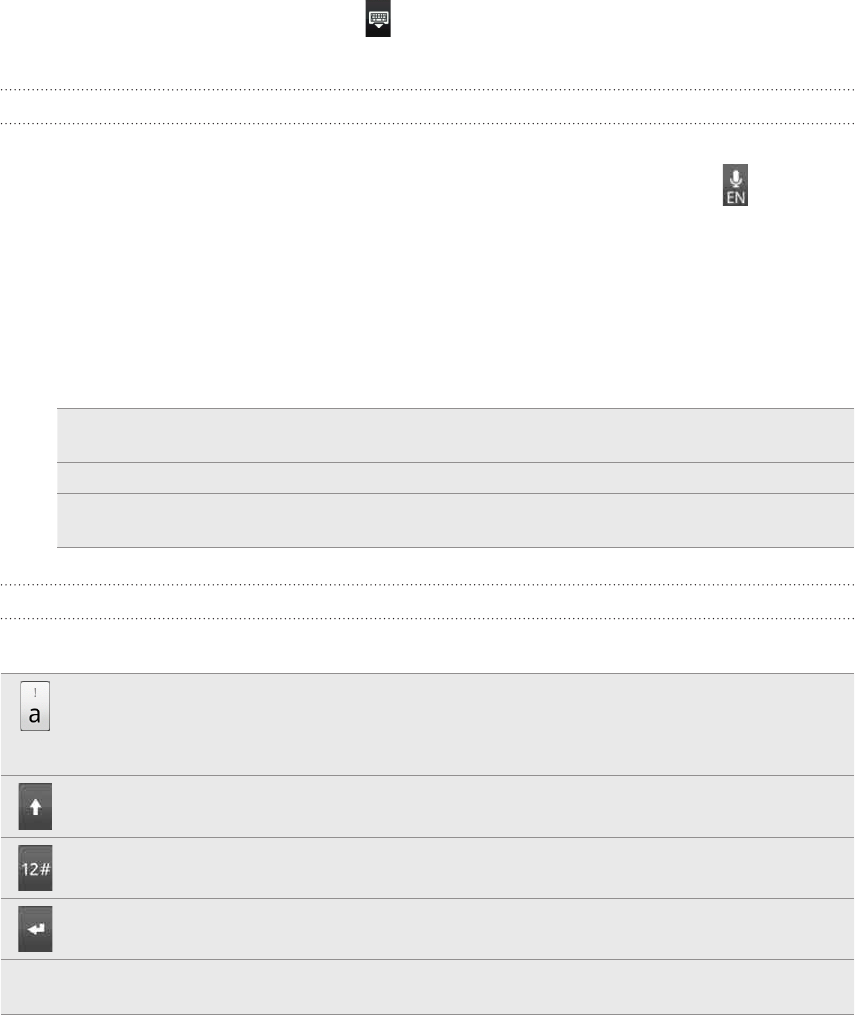
59 Keyboard
Keyboard
Using the onscreen keyboard
When you start an app or select a field that requires text or numbers, the onscreen
keyboard becomes available.
After entering your text, you can tap or press BACK to close the onscreen
keyboard.
Selecting a keyboard layout
You can choose from three different keyboard layouts to suit your typing style.
1. On the onscreen keyboard, tap the Language key (for example, tap if you’re
currently using the English onscreen keyboard). Then on the International
keyboard options menu, tap Settings.
If tapping the Language key doesn’t display the International keyboard menu,
press HOME > MENU, and tap Settings > Language & keyboard > Touch Input.
2. Tap Keyboard types, and then select the keyboard layout that you want to use.
Choose one from the following:
QWERTY This layout is similar to a desktop computer keyboard. This is
the default keyboard layout.
Phone Keypad This layout resembles the traditional mobile phone keypad.
Compact QWERTY This layout features two letters on each key. The key size is
slightly bigger than on the full QWERTY layout.
Entering text
Use the following keys while entering text using the onscreen keyboard:
Press and hold keys with gray characters at the top to enter numbers, symbols, or
accented letters. The gray character displayed on the key is the character that will be
inserted when you press and hold that key. Some keys have multiple characters or
accents associated with them.
Shift key. Tap to enter an uppercase letter. Tap twice to turn on caps lock.
Tap to switch to the numeric and symbol keyboard.
Enter key. Tap to create a new line.
Tap the Up, Down, Left, or Right key to move the text cursor in the direction that you want
while you are entering or editing text.
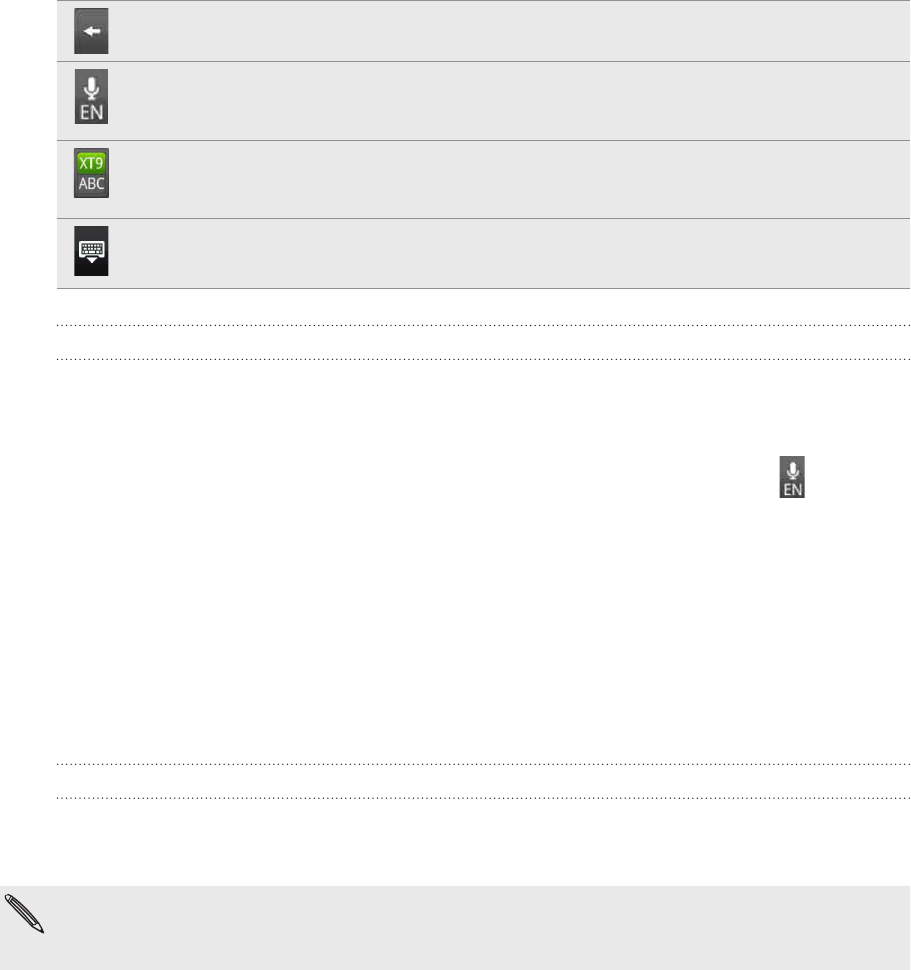
60 Keyboard
Backspace key. Tap to delete the previous character.
Language key. The key you see depends on the keyboard language you are currently
using. Tap to switch to another keyboard language (see “Enabling multiple keyboard
languages”). You can also access onscreen keyboard settings.
Tap to toggle between Multitap and XT9 predictive modes when using the Compact
QWERTY or Phone keypad layout. For more information, see “Entering words with
predictive text.”
Tap to hide the onscreen keyboard.
Enabling multiple keyboard languages
If there are multiple keyboard languages available on your phone, you can choose
which languages to enable in the onscreen keyboard so that you can switch to these
languages and use them to enter text.
1. On the onscreen keyboard, tap the Language key (for example, tap if you’re
currently using the English onscreen keyboard). Then on the International
keyboard options menu, tap Settings.
If tapping the Language key doesn’t display the International keyboard menu,
press HOME > MENU, and tap Settings > Language & keyboard > Touch Input.
2. Tap International keyboard.
3. Choose the languages that you want.
Available languages depend on the region where you purchased the phone.
Changing to the landscape onscreen keyboard
When entering text, you can choose to use the landscape orientation of the onscreen
keyboard. Turn your phone sideways to use a larger keyboard for easy typing.
The Auto-rotate screen check box in HOME > MENU > Settings > Display needs to be
selected for the screen orientation to automatically change.
The landscape orientation keyboard is not supported in all apps.
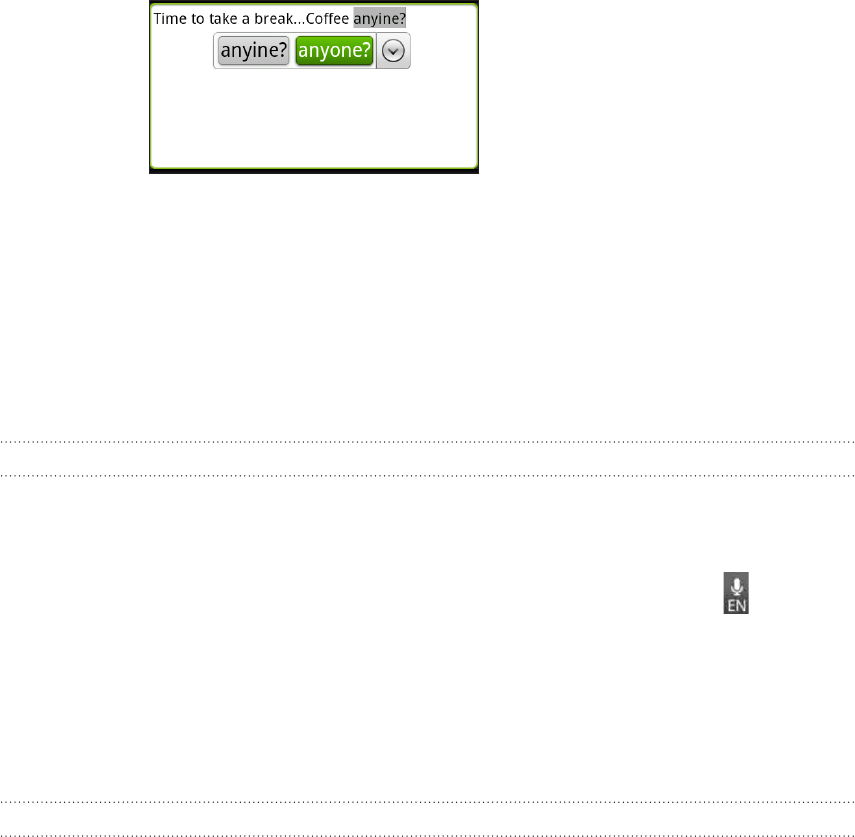
61 Keyboard
Entering words with predictive text
The onscreen keyboard has predictive text to help you type quickly and accurately.
Predictive text input is enabled by default, and word suggestions are displayed as you
type.
To enter a word in predictive mode, do any of the following:
If you see the word you want highlighted in green or orange, you can simply
tap the space bar to insert the word into your text.
If you see the word you want shown in the suggestions before you have
finished typing the entire word, tap the word to insert it into your text.
If an arrow is shown to the right of the suggestion list, tap the arrow to see
more suggestions.
Setting a second language for the keyboard
Aside from the keyboard language you are currently using, you can set the predictive
text to be bilingual. As you type, you’ll get word suggestions in two languages that
you’ve selected.
1. On the onscreen keyboard, tap the Language key (for example, tap if you’re
currently using the English onscreen keyboard). Then on the International
keyboard options menu, tap Settings.
If tapping the Language key doesn’t display the International keyboard menu,
press HOME > MENU, and tap Settings > Language & keyboard > Touch Input.
2. Tap Bilingual prediction, and then choose the language you want.
Adding a word to the predictive text dictionary
Your phone comes with a list of words that it references for predictive text
suggestions. Sometimes you may need to add a word to the predictive text dictionary,
for example a name or a specialized technical word.
While entering text using the QWERTY keyboard layout, if you tap any word on the
suggestion list, it is automatically added to the predictive text dictionary if it was not
in the dictionary already.
You can also add a word to the list manually:
From the Home screen, press MENU, and then tap Settings > Language &
keyboard > Touch Input.
Tap Personal dictionary > Edit personal dictionary > Add new.
Enter the word to add, and then tap OK.
1.
2.
3.

62 Keyboard
Editing or deleting a word in the predictive text dictionary
You can edit or remove words that you previously added to the predictive text
dictionary.
From the Home screen, press MENU, and then tap Settings > Language &
keyboard > Touch Input.
Tap Personal dictionary > Edit personal dictionary.
To edit a word, tap the word itself.
To delete words from the dictionary, press MENU and tap Delete. Then
choose the words to remove and tap OK.
Backing up your personal dictionary to your storage card
You can use your storage card to back up the new words you’ve added to the
predictive text dictionary.
From the Home screen, press MENU, and then tap Settings > Language &
keyboard > Touch Input.
Tap Personal dictionary > Sync personal dictionary > Copy to storage card.
When prompted, tap OK.
Importing your personal dictionary from your storage card
From the Home screen, press MENU, and then tap Settings > Language &
keyboard > Touch Input.
Tap Personal dictionary > Sync personal dictionary > Restore from storage card.
When prompted, tap OK.
Entering text by speaking
No time to type? Try speaking the words to enter it in most text fields that let you use
the onscreen keyboard.
Simply press and hold the Language key. When your phone cues you to “Speak now”,
tell your phone what you want to be typed in.
First make sure to select the language you’ll be using in the Voice input & output settings.
See “Setting the voice input language”.
Since your phone uses Google’s speech-recognition service, you need to be connected to
the Internet to enter text by speaking.
Setting the voice input language
1. From the Home screen, press MENU, then tap Settings > Voice input & output >
Voice recognizer settings.
2. Tap Language, then choose the language you want.
Available languages depend on the voice input languages supported by Google.
1.
2.
1.
2.
3.
1.
2.
3.
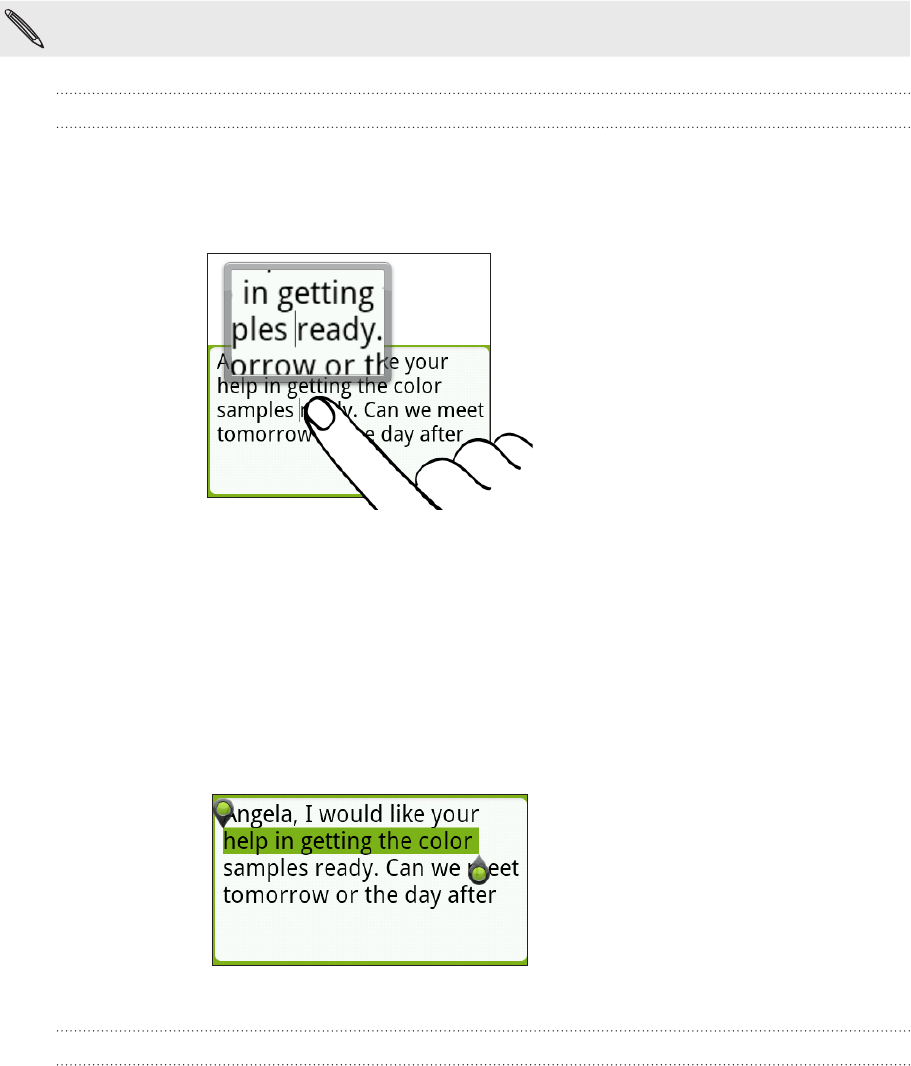
63 Keyboard
Editing text
You can select, copy, or cut the text you enter using the onscreen keyboard, then
paste it in another text field within or across apps.
Some apps may offer their own way of selecting or copying text.
Selecting text
Highlight a portion of a text or select all that you want to copy or cut.
Press and hold the text field that contains the text to select. Don’t lift your finger
just yet to display the magnifier.
2. Drag your finger to move the text cursor to a letter within the text that you want
to select. It should be easy since the magnifier gives you a bigger view of the
text.
3. After positioning the text cursor, lift your finger. The text selection menu then
pops up.
4. Do one of the following:
Tap Select text. When the word where you’ve placed the text cursor is
highlighted, drag the start and end markers to select the text you want.
Tap Select all to select everything in the text field.
Copying and pasting text
1. After you have selected the text you want to copy, tap Copy or Cut.
The selected text is then copied to the clipboard.
2. Within the same or another app, press and hold a text field where you want to
paste the text. Don’t lift your finger just yet to display the magnifier.
1.

64 Keyboard
3. Drag your finger to move the text cursor to where you want to paste the text.
4. After positioning the text cursor, lift your finger. The text selection menu then
pops up.
5. Tap Paste.
Adjusting touch input settings
Open the Touch Input settings by doing one of the following:
On the onscreen keyboard, tap the Language key (for example, tap
if you’re currently using the English onscreen keyboard). Then on the
International keyboard options menu, tap Settings.
From the Home screen, press MENU and then tap Settings > Language &
keyboard > Touch Input.
Touch Input settings
Keyboard types Select the keyboard layout to use. You can choose from QWERTY,
Phone Keypad, or Compact QWERTY.
International keyboard Add or remove languages from the onscreen keyboard language
list.
Bilingual prediction Select a secondary keyboard language to use. See “Setting a
second language for the keyboard”.
Text input Set text input options when entering text, calibrate the keyboard,
and set a sound and/or vibration feedback whenever you tap a
key. See “Text input” for details.
Tutorial Learn how to use the onscreen keyboard with this interactive
tutorial.
Personal dictionary Add, edit or remove words in the predictive text dictionary. See
“Entering words with predictive text.”
Text input
QWERTY
Prediction Select to enable the word prediction feature which provides a list
of possible words that reflect the characters of the keys you have
tapped as well as characters of nearby keys.
Spell correction Select to correct typographical errors by selecting from a list of
possible words that reflect the characters of the keys you have
tapped as well as characters of nearby keys.
Phone keypad & compact QWERTY
Spell correction Select to correct typographical errors by selecting from a list of
possible words that reflect the characters of the keys you have
tapped as well as characters of nearby keys.
Word completion When using the Compact QWERTY or Phone keypad, lets you
select from a list of possible combinations based on the characters
that appear on the keys that you tapped.

65 Keyboard
Other settings
Sound feedback Select to hear a clicking sound whenever you tap a key on the
keyboard.
Vibrate when typing Select to enable vibration feedback whenever you tap a key on
the keyboard.
Finger touch precision
Calibration tool Tap to re-calibrate the keyboard touch accuracy. Re-calibrate the
keyboard if you feel that the keyboard keys are not responding
accurately to your taps.
Reset calibration Tap to reset the calibration back to factory default.

66 Messages
Messages
About Messages
Keep in touch with important people in your life. Use the Messages app to compose
and send text (SMS) and multimedia messages (MMS).
From the Home screen, tap > Messages.
On the All messages screen, all your sent and received messages are neatly grouped
into conversations, by contact name or phone number. You can:
Scroll up or down the list of conversations by swiping your finger on the
screen.
Tap a contact name or number to view the exchange of messages.
Tap the photo or icon to open a menu where you can quickly choose how to
communicate with the contact.
You can also view your messages on the Home screen with the Messages widget. If
this widget is not there already, you can add it by following the steps in “Personalizing
your Home screen with widgets” in the Personalizing chapter.
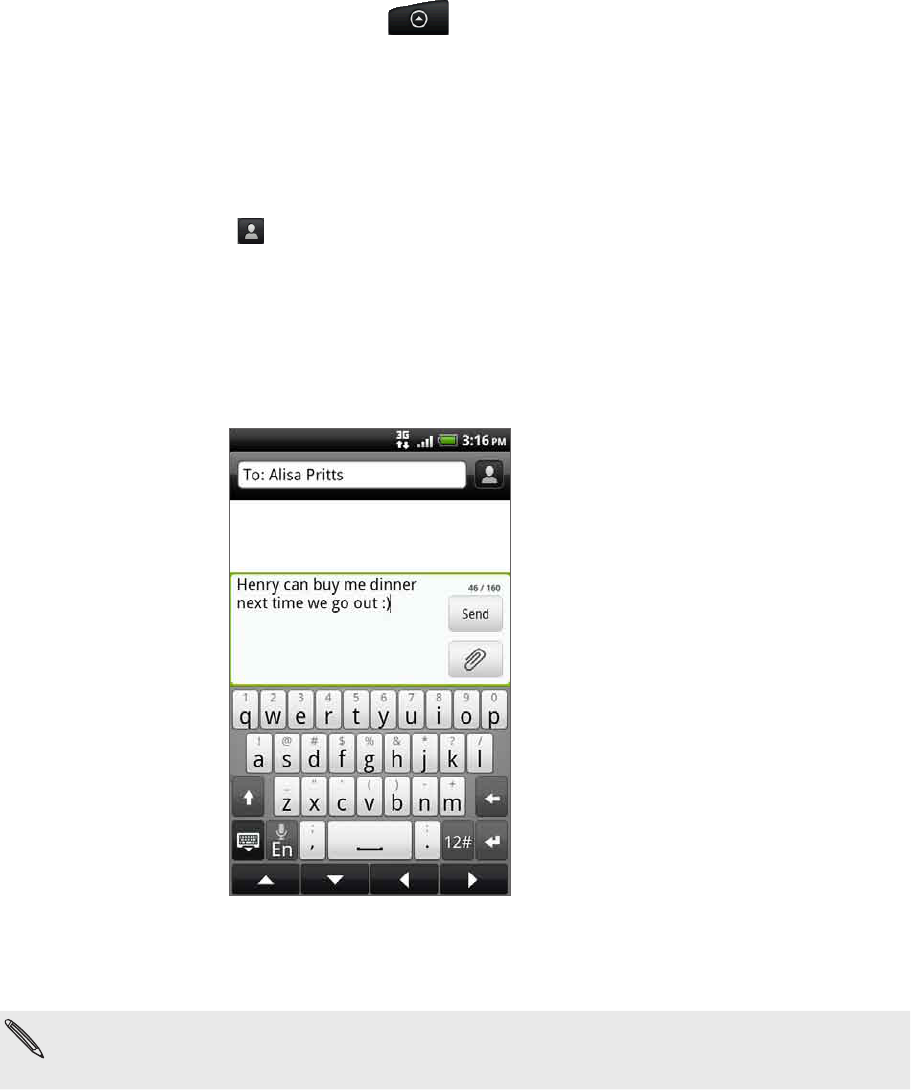
67 Messages
Sending a text message (SMS)
If you exceed the limit on the number of characters for a single text message, your text
message will be delivered as one but will be billed as more than one message.
From the Home screen, tap > Messages.
On the All messages screen, tap Compose message.
3. Fill in one or more recipients. You can:
Enter the first few letters of a contact name or starting digits of a mobile
number. As you type, matching names with phone numbers from your
stored contacts are displayed. Tap a name or one of the contact’s number.
Tap the icon, and then select the phone numbers of the contacts to
whom you want to send the message. You can also select contact groups as
recipients.
When you have selected all the message recipients, tap OK.
Enter the complete phone numbers directly in the To field.
4. Tap the box that says “Tap to add text”, and then enter your message.
5. Tap Send.
Or press BACK to save it as a draft. To open and edit a draft message, see
“Resuming a draft message.”
Your text message automatically becomes a multimedia message when you enter an email
address as the recipient, add a message subject, attach an item, or compose a very long
message.
1.
2.
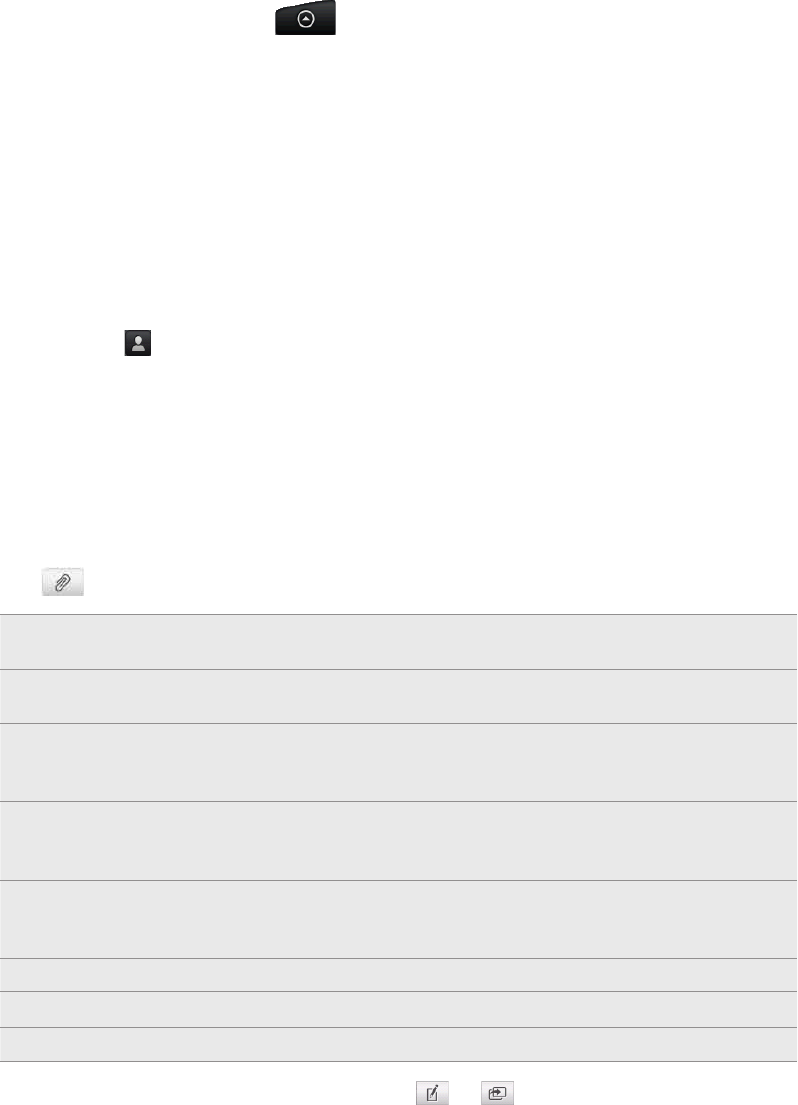
68 Messages
Sending a multimedia message (MMS)
To compose a multimedia message, start by creating a new text message. Then
choose the type of attachment to include in your message.
From the Home screen, tap > Messages.
On the All messages screen, tap Compose message.
3. Fill in one or more recipients. You can:
Enter the first few letters of a contact name or starting digits of a mobile
number. As you type, matching names with phone numbers and email
addresses from your stored contacts are displayed. Tap a contact’s number
or email address.
Email addresses will be displayed when Show email address is selected
in Recipient list settings. To find out more about message settings, see
“Setting message options”.
Tap the icon, and then select the phone numbers of the contacts to
whom you want to send the message. You can also select contact groups as
recipients.
When you have selected all the message recipients, tap OK.
Enter the complete phone numbers or email address directly in the To field.
4. To add a subject line, press MENU and then tap More > Add subject.
5. Tap the box that says “Tap to add text”, and then enter your message.
6. Tap and then choose the type of attachment.
Picture Select Camera to take a photo and attach it, or Gallery to
attach a photo from your storage card.
Video Select Camcorder to capture a video and attach it, or
Videos to attach a video from your storage card.
Audio Select Voice Recorder to make a voice recording and
attach it, or Music & sounds to attach a music file or voice
recording from your storage card.
App recommendation Choose an app you’ve installed from Android Market that
you want to share with others. The URL from which the
app can be downloaded will be inserted to your message.
Location Add your current location (requires GPS to be turned on),
or a location you pick on a map to your message. See the
Maps and location chapter for more details.
Contact (vCard) Select a contact, and then select the information to attach.
Appointment (vCalendar) Select the calendar event you want to attach.
Slideshow See “Creating a slideshow” for details.
7. To make changes to your attachment, tap or (depending on the type of
file you’ve attached).
You can also press MENU, then tap Remove to start over.
8. Tap Send.
Or press BACK to save it as a draft. To open and edit a draft message, see
“Resuming a draft message.”
1.
2.
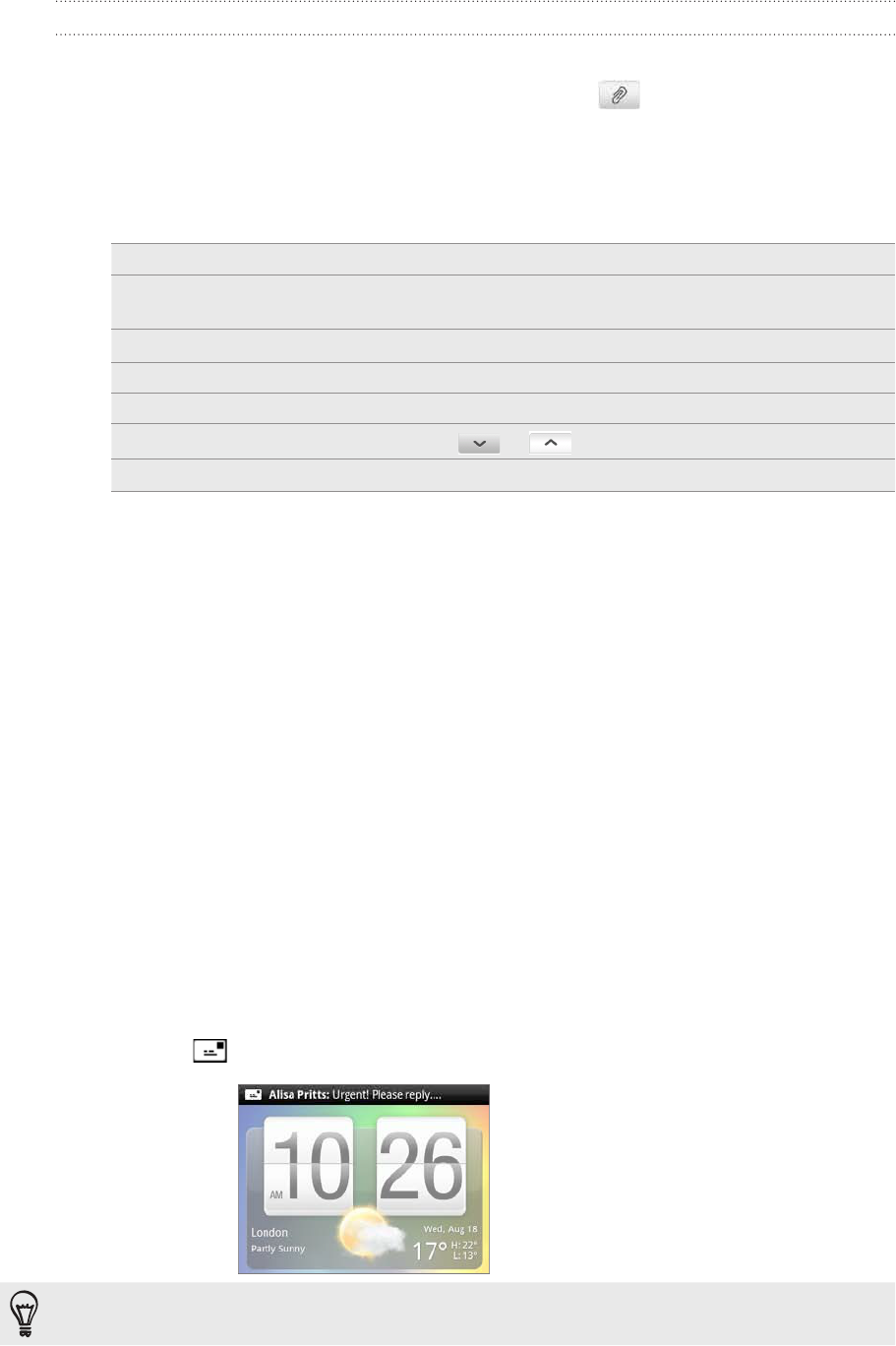
69 Messages
Creating a slideshow
In a multimedia message, you can add slides, each containing a photo, video, or audio.
In the multimedia message you’re composing, tap > Slideshow.
On the Edit slideshow screen, tap Add slide.
Tap Slide 1.
To compose your slideshow, do any of the following:
Add a picture Tap Insert picture.
Add a video Press MENU, and then tap Add video (you cannot
add both a picture and a video on the same slide).
Add music or a voice recording Press MENU, and then tap Add audio.
Add a caption Tap the box that says “Tap to add text”.
Add a new slide Tap Add slide.
View the next or previous slide Tap or .
Preview your slideshow Press MENU, and then tap Preview.
For more options, press MENU, and then tap More.
5. When finished, tap Done to attach the slideshow to your message.
6. Tap Send.
Or press BACK to save it as a draft. To open and edit a draft message, see
“Resuming a draft message.”
Resuming a draft message
On the All messages screen, press MENU, and then tap Drafts.
Tap the message to resume editing it.
When you finish editing the message, tap Send.
Viewing and replying to a message
Depending on your notification settings, the phone plays a ringtone, vibrates, or
displays the message briefly in the status bar when you receive a new message. A new
message icon is also displayed in the status bar.
You can change the notification for new messages. See “Setting message options.”
1.
2.
3.
4.
1.
2.
3.
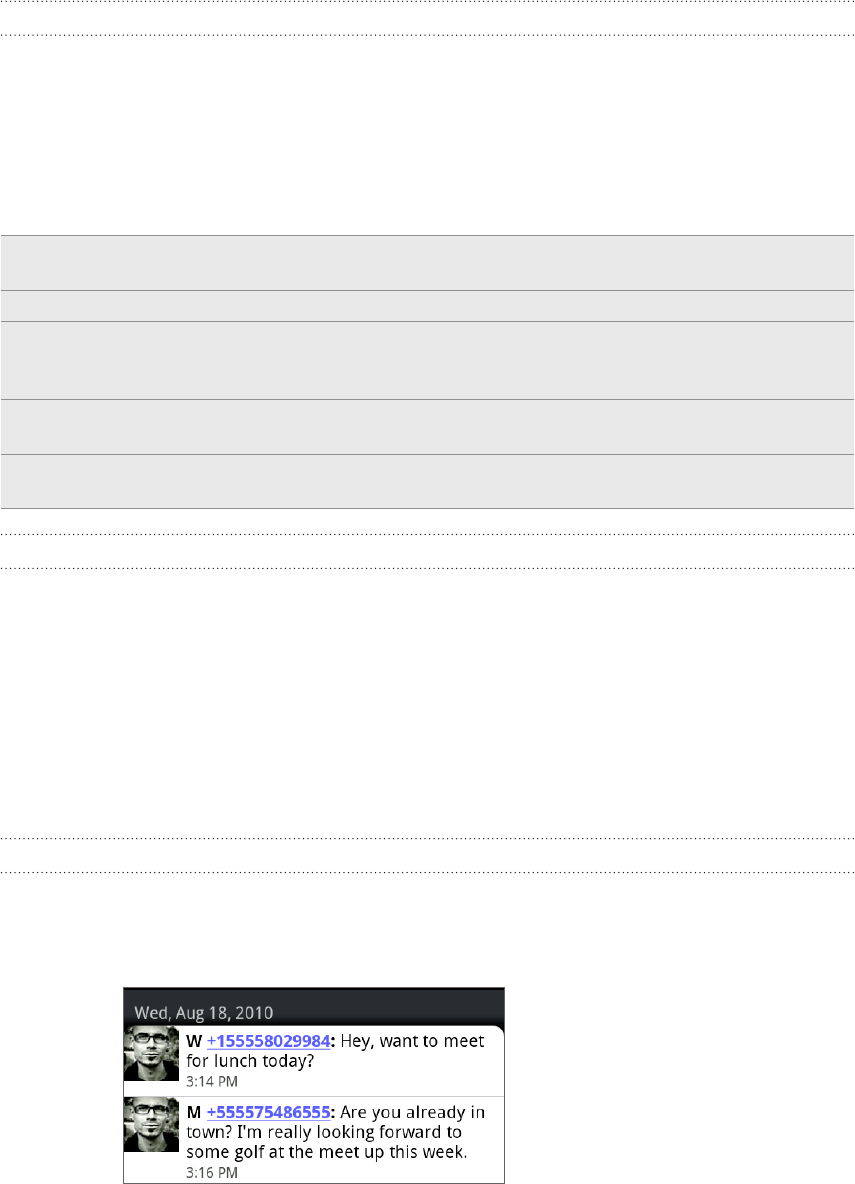
70 Messages
Viewing a message
To open and read your received messages, you can:
Press and hold the status bar, and then slide your finger down to open the
Notifications panel. Then tap the new message notification.
Open the Messages app to access and read the message.
While reading the message, you can:
Call or save a phone number
contained in the message
Tap the phone number. Then choose whether to dial the
number or add it to your contacts.
Open a link in the message Tap the link to open it in the web browser.
Send to or save an email address
contained in the message
Tap the email address. Then choose whether to send
an email, send a multimedia message, or save the email
address to your contacts.
Forward a message Press and hold the message to open the options menu,
and then tap Forward.
Check message details Press and hold the message to open the options menu,
and then tap View message details.
Replying to a message
1. On the All messages screen, tap a contact (or phone number) to display the
exchange of messages with that contact.
2. To reply to the message, tap the text box at the bottom of the screen, then enter
your reply message.
You can also reply with a multimedia message. See “Sending a multimedia
message (MMS)” for details.
3. Tap Send.
Replying to another phone number of the contact
When a contact has multiple phone numbers stored on your phone, you’ll see the
particular phone number used within the message. There’s also a bold letter before the
phone number to indicate the number type (for example, M stands for Mobile).
Keep in mind that your response will be sent to the phone number of the latest
message you’ve received from this contact.
If you want to change the phone number before you send out your reply, press MENU,
then tap More > Recipient phone number. Select another phone number of this
contact, and then tap OK.
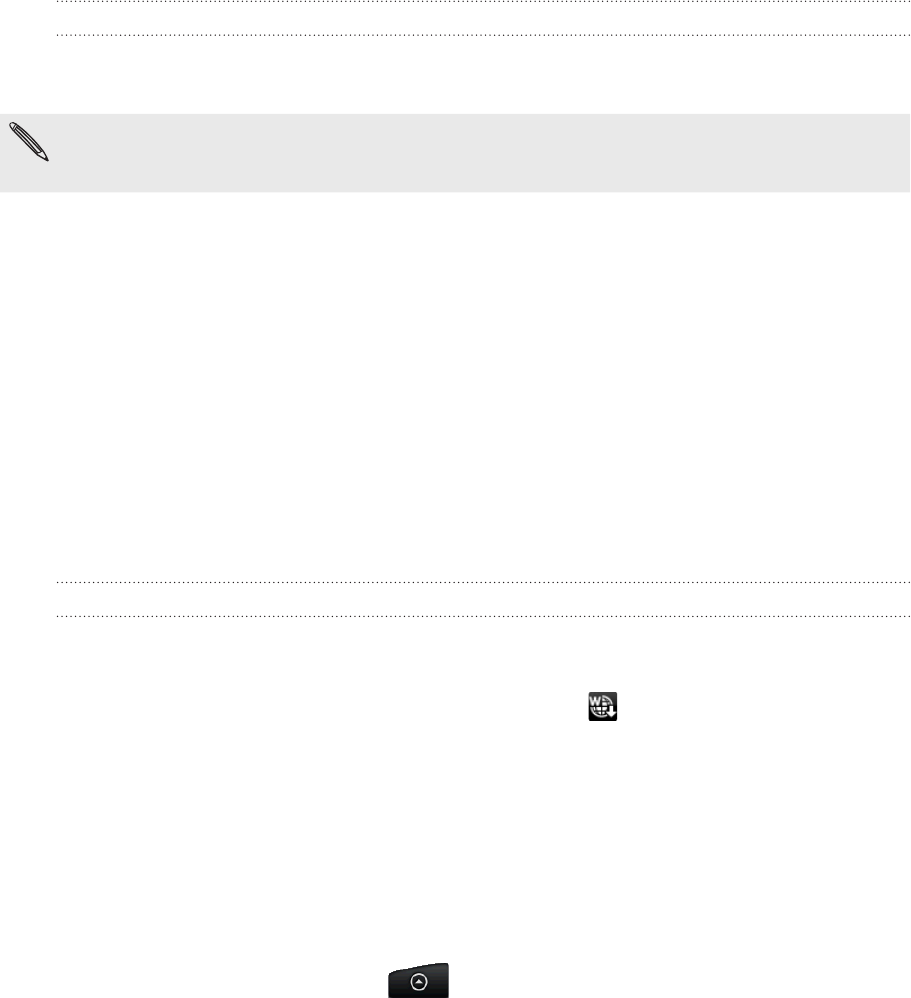
71 Messages
Viewing and saving an attachment from a multimedia message
If you are concerned about the size of your data downloads, check the multimedia
message size first before you download it.
When Auto-retrieve in MMS settings is disabled, only the message header is downloaded. To
download the entire message, tap the Download button at the right side of the message. To
find out more about message settings, see “Setting message options.”
If there’s a media attachment such as a photo or video in a received message,
tap it to view the content.
If the attachment is a contact (vCard), tap it to view the contact information,
then tap Save to add to your contacts.
Open the People app to view the contact. See the People chapter.
If the attachment is an appointment or event (vCalendar), tap it and then
choose the calendar where to save it. Tap Import.
Open the Calendar app to view the appointment or event. See the Calendar
chapter.
To save the attachment to your storage card, press and hold the multimedia
message, and then tap Save [attachment type] on the options menu.
Viewing push messages
Push messages contain a web link. Often, the link will be to download a file that you
have requested, for example a ringtone.
When you receive a push message, a notification icon is displayed in the status bar.
Opening and reading a new push message
Press and hold the status bar, and then slide the status bar down to open the
Notifications panel.
Tap the new message.
Tap Visit website.
Viewing all your push messages
From the Home screen, tap > Messages.
Press MENU, and then tap Push messages.
1.
2.
3.
1.
2.
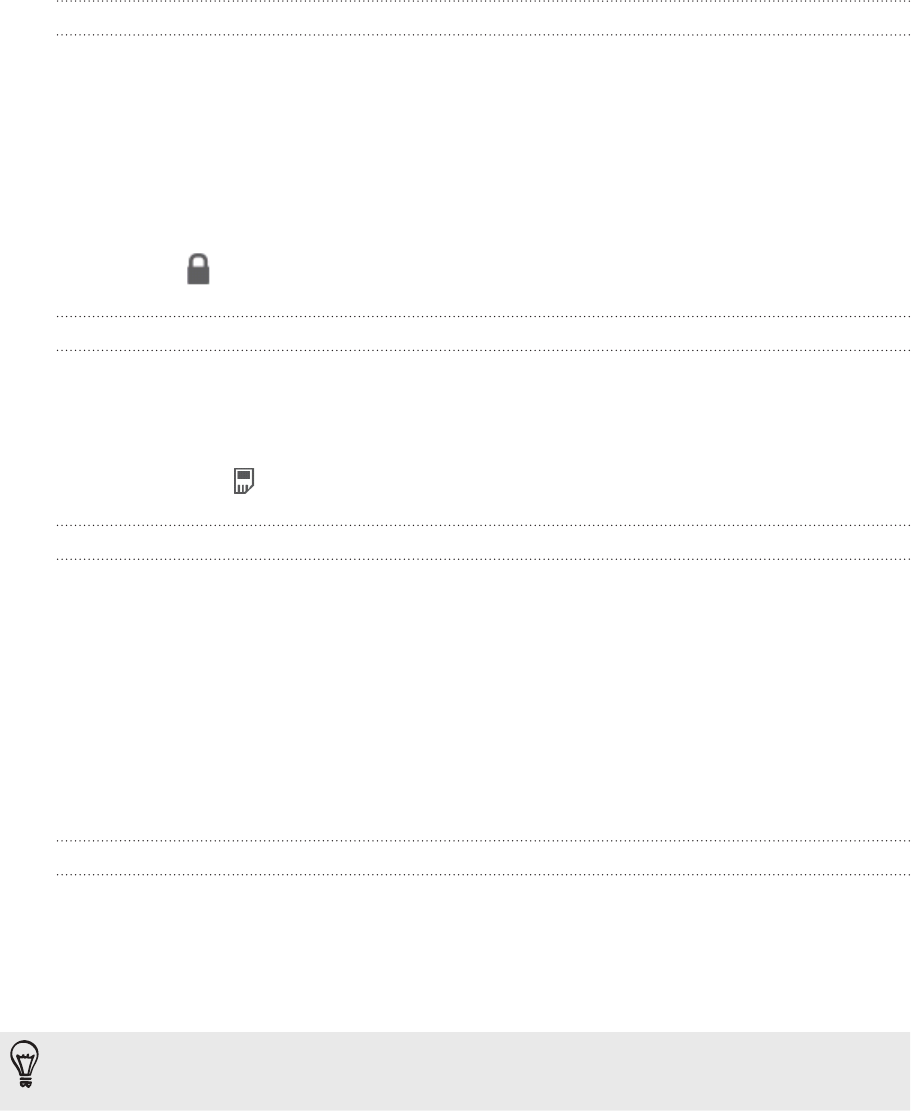
72 Messages
Managing message conversations
Protecting a message from deletion
You can lock a message so that it will not be deleted even if you delete the other
messages in the conversation.
On the All messages screen, tap a contact (or phone number) to display the
exchange of messages with that contact.
Press and hold the message that you want to lock.
Tap Lock message on the options menu.
A lock icon ( ) is displayed at the right hand side of the message.
Copying a message to your SIM card
On the All messages screen, tap a contact (or phone number) to display the
exchange of messages with that contact.
Press and hold a message, and then tap Copy to SIM.
A SIM card icon ( ) is displayed at the right hand side of the message.
Deleting a single message
On the All messages screen, tap a contact (or phone number) to display the
exchange of messages with that contact.
Press and hold the message that you want to delete.
If the message is locked, tap Unlock message on the options menu, and then
press and hold the message to display the options menu again.
Tap Delete message on the options menu.
When prompted to confirm, tap OK.
Deleting several messages within a conversation
On the All messages screen, tap a contact (or phone number) to display the
exchange of messages with that contact.
Press MENU and then tap More > Delete.
Tap Delete by selection.
You can also tap Delete by phone number if the contact used multiple phone numbers
throughout the conversation and you want to delete the messages sent from a particular
number.
4. Select the messages you want to delete and then tap Delete.
1.
2.
3.
1.
2.
1.
2.
3.
4.
5.
1.
2.
3.

73 Messages
Deleting a conversation
On the All messages screen, press and hold a contact (or phone number) whose
messages you want to delete, and then tap Delete.
While looking at the exchange of messages in a conversation, you can also press
MENU and then tap More > Delete > Delete thread.
Any locked messages in the conversation thread will not be deleted unless you
select the Delete locked messages check box.
2. When prompted to confirm, tap OK to delete the entire thread.
Deleting several conversations
On the All messages screen, press MENU, and then tap Delete.
Select the conversation threads you want to delete.
Tap Delete.
Any locked messages will not be deleted.
Setting message options
On the All messages screen, press MENU and then tap Settings. You’ll find several
groups of settings.
Received messages
Received notification Receive a notification in the status bar when a new
message arrives.
Play notification sound Set your phone to play a sound when a new message
arrives.
Notification sound Choose a sound that will play when you receive a message.
Vibrate Set your phone to vibrate when a new message arrives.
Sent messages
Sent notification Receive a notification in the status bar when a message is
sent successfully.
Failure notification Receive a notification in the status bar when a message is
not sent successfully.
Play notification sound Set your phone to play a sound when a sent or failure
notification is received.
Notification sound Choose a sound that will play when there’s a sent or failure
notification.
Vibrate Set your phone to vibrate when a new message arrives.
Display message on screen Set your phone to show pop-up notifications (not just in
the status bar) when your messages are sent successfully
or not. You can also select None to disable this option.
1.
1.
2.
3.

74 Messages
Storage settings
Delete old messages Automatically delete older messages, except for locked
messages, when the set limits are reached.
Text message limit Choose the maximum number of text messages to store
in each conversation thread (this does not include locked
messages).
Multimedia message limit Choose the maximum number of MMS messages to store
in each conversation thread (this does not include locked
messages).
Recipient list settings
Show email address Search and display the email addresses of stored contacts
when you’re adding message recipients.
Message forwarding
Forward to phone number Forward the text and multimedia messages you’ll receive to
another phone number (this may incur extra fees from your
mobile operator).
Forward to email address Forward the text and multimedia messages you’ll receive
to an email address (this may incur extra fees from your
mobile operator).
SMS settings
Delivery reports Receive a report on the delivery status of your message.
Service center Displays the message service center number used. Tap to
change the number. It is recommended that you do not
change the number here for it may cause problems in
receiving and sending messages.
Manage SIM card messages View text messages stored on your SIM card. You can also
delete or copy these messages to your phone’s memory.
MMS settings
Delivery reports Receive a report on the delivery status of your message.
Read reports Receive a report whether each recipient has read the
message or deleted it without reading.
Auto-retrieve Automatically retrieve all your MMS messages completely.
When selected, the MMS message header plus the message
body and attachments will automatically download to your
phone. If you clear this check box, only the MMS message
header will be retrieved and shown on the All messages
screen.
Roaming auto-retrieve Automatically retrieve all your MMS messages completely
when roaming. This may incur significant phone charges.
Priority setting Set the message priority of MMS messages sent.
Maximum message size Set the maximum file size of an MMS message. The MMS
message will not be sent out if it exceeds the file size set
here.

75 Accounts and sync
Accounts and sync
Synchronizing with online accounts
About online accounts
These are some of the types of information your phone can sync with your online
accounts:
Gmail™/Google™ Mail and Exchange ActiveSync email.
Google and Exchange ActiveSync contacts, as well as your friends’ contact
information in Facebook® and their Twitter™ profiles. For information on
contacts, see the People chapter.
Calendar events from your primary Google Account, from Exchange
ActiveSync, and from your Facebook account. For information on using
Calendar, see the Calendar chapter.
Status updates and links shared by your friends and yourself on social
networks such as Facebook and Twitter. For details, see the Social chapter.
Flickr™ and Facebook photo uploads. For information on viewing photos, see
the Photos, videos, and music chapter.
You can set up an Exchange ActiveSync account on your phone either in the Mail app or the
Accounts & sync setting.
To set it up in the Mail app, see “Adding a Microsoft Exchange ActiveSync account” in the
Email chapter.
Synchronizing with a Google Account
Signing in to your Google Account lets you sync Gmail/Google Mail and your Google
contacts and calendars between your phone and the Web. You also need to sign in to
a Google Account to use Google apps such as Google Talk™ and Android Market™.
If you skipped signing in to a Google Account when you first set up your phone, you may
encounter problems when using some Google apps. If these problems persist, you may need
to factory reset your phone and enter your Google Account details when you set up the
phone again. To factory reset your phone, see “Restarting or factory resetting your phone” in
the Update and reset chapter.

76 Accounts and sync
Adding more Google Accounts
You can add more than one Google Account on your phone. However, subsequent
Google Accounts can only sync contacts, emails, and calendar events. Other Google
services use the first Google Account you added.
From the Home screen, press MENU, and then tap Settings > Accounts & sync.
Tap Add account > Google.
Follow the onscreen instructions to sign in to an account or create a new
account.
Forgot your Google Account password?
You need your Google Account password to sync Google Mail (Gmail), Calendar, and
Google contacts to your phone. You also need this password to use Google Talk and
download apps from Android Market.
If you have forgotten your Google Account password, you can try to recover it by
going to the Google website.
On your phone or computer, open your web browser and go to
https://www.google.com/accounts/ForgotPasswd.
Enter the email address or username that you use to sign in to your Google
Account.
Complete the word verification process. Enter the characters that you see
onscreen and click Submit.
An email will be sent to the alternate email address you provided when you created
your Google Account. Follow the instructions in the email to reset your password.
If you don’t have an alternate email address or cannot access the email account you
used to create your Google Account, you can reset your Google Account after 24
hours by answering the security question for password recovery.
Adding a social network account
If you skipped setting up your social network account (such as Facebook, Twitter, or
Flickr) when you first turned on and set up your phone, you can still sign in to these
accounts through your phone’s settings.
From the Home screen, press MENU, and then tap Settings > Accounts & sync.
Tap Add account, and then tap the account type you want to add.
Follow the onscreen instructions to enter your account information.
Your social network account will be added to the list on the Accounts & sync
screen. Depending on how you set up the account, the new information may start
synchronizing with your phone.
1.
2.
3.
1.
2.
3.
1.
2.
3.

77 Accounts and sync
Managing your online accounts
Changing general sync settings
From the Home screen, press MENU, and then tap Settings > Accounts & sync.
Select or clear the following:
Background data If this is selected, apps can send and receive online account
information even if you are not currently using them.
Auto-sync If this is selected, apps can use the sync schedule defined in the
account settings. If this is cleared, you will need to sync accounts
manually. For instructions on doing this, see “Synchronizing an
account manually”.
Synchronizing an account manually
From the Home screen, press MENU, and then tap Settings > Accounts & sync.
Tap the account that you want to sync.
Tap Sync now.
Changing account settings
You can change settings such as the sync frequency and the types of information
synchronized, the kinds of notification you receive, and the way that account
information is displayed.
On the Accounts & sync screen, tap the account that you want to edit.
Tap the type of information you want to sync or select an item to edit its
settings.
Removing an account
You can remove an account to delete it and all information associated with it from
your phone, for example messages, contacts, or settings. Removing an account does
not delete information from the online service itself.
You cannot remove some accounts, such as the first Google Account you signed into on the
phone, except by deleting all personal information from your phone with a hard reset. For
instructions on doing this, see “Restarting or factory resetting your phone” in the Update and
reset chapter.
From the Home screen, press MENU, and then tap Settings > Accounts & sync.
Tap the account that you want to remove.
Tap Remove account, and then confirm that you want to remove the account.
1.
2.
1.
2.
3.
1.
2.
1.
2.
3.
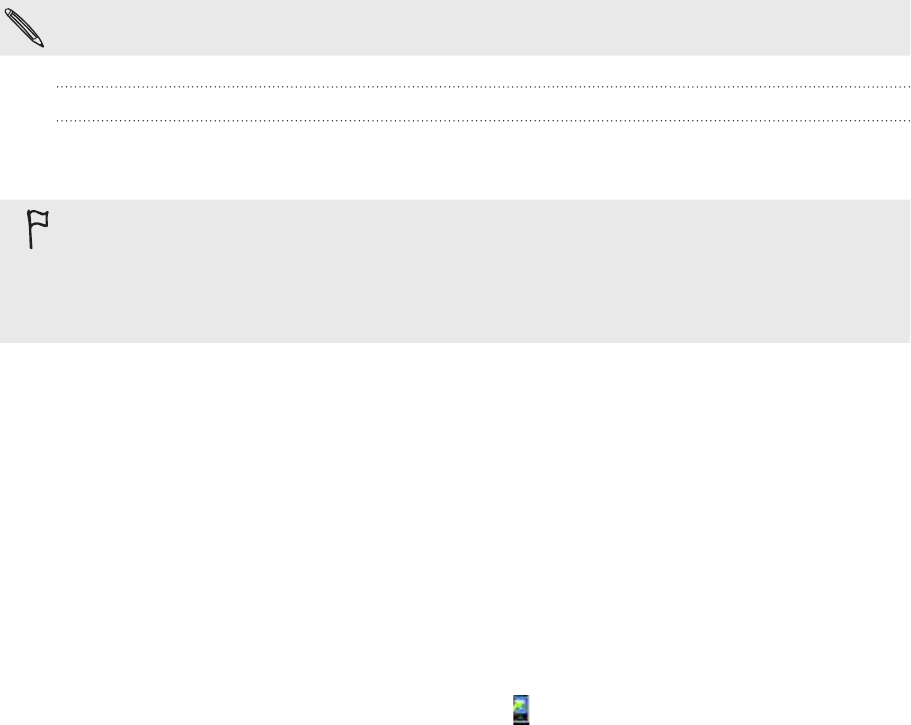
78 Accounts and sync
Synchronizing with your computer
You have your new vacation photos on your phone while your business calendar is on
your computer. Why not make these types of files and information available on both
devices? With HTC Sync™, you can:
Sync your contacts between your Microsoft® Outlook®, Outlook® Express or
Windows Contacts on your computer and your phone.
Sync your calendar events between the Outlook or Windows Calendar on
your computer and your phone.
Bring your photos, videos, documents, songs, and playlists from your
computer to your phone and enjoy them on the go.
Easily import your captured photos and videos from your phone to your
computer.
Sync bookmarks inside the “HTC Bookmarks” favorites folder on your
computer and all bookmarks stored on your phone’s web browser.
Download maps and useful add-on services for your phone’s Locations app to
your computer first, and then sync them to your phone.
Install third-party mobile phone apps (not downloaded from Android Market)
from your computer.
You need a microSD card inserted into your phone to be able to sync multimedia files, maps,
and documents.
Installing HTC Sync that came with the microSD card
Make sure the microSD card is inserted to your phone. Copy the HTC Sync installer
from the microSD card to your computer and use it to install.
The HTC Sync version in the microSD card that came with your phone can be installed on a
computer running Windows 7, Windows Vista, or Windows XP.
HTC Sync requires USB 2.0 on your computer to connect and sync with your phone.
For trouble-free installation, first quit all running programs and temporarily exit from your
anti-virus program before you start installing HTC Sync.
1. Connect your phone to your computer using the supplied USB cable.
2. On your phone’s Connect to PC screen, tap Disk drive, and then tap Done.
On your computer, the connected phone is recognized as a removable disk.
3. Navigate to the removable disk and open it.
4. Copy HTCSync.exe to your computer.
5. After copying, unmount the removable disk (that is, the connected phone) as
required by your computer’s operating system to safely remove your phone.
6. On your computer, double-click HTCSync.exe and follow the onscreen
instructions to install HTC Sync.
After installing HTC Sync, the HTC Sync icon ( ) is added to your computer’s system
tray (check the bottom-right side of your computer screen). You can double-click this
icon to open HTC Sync.
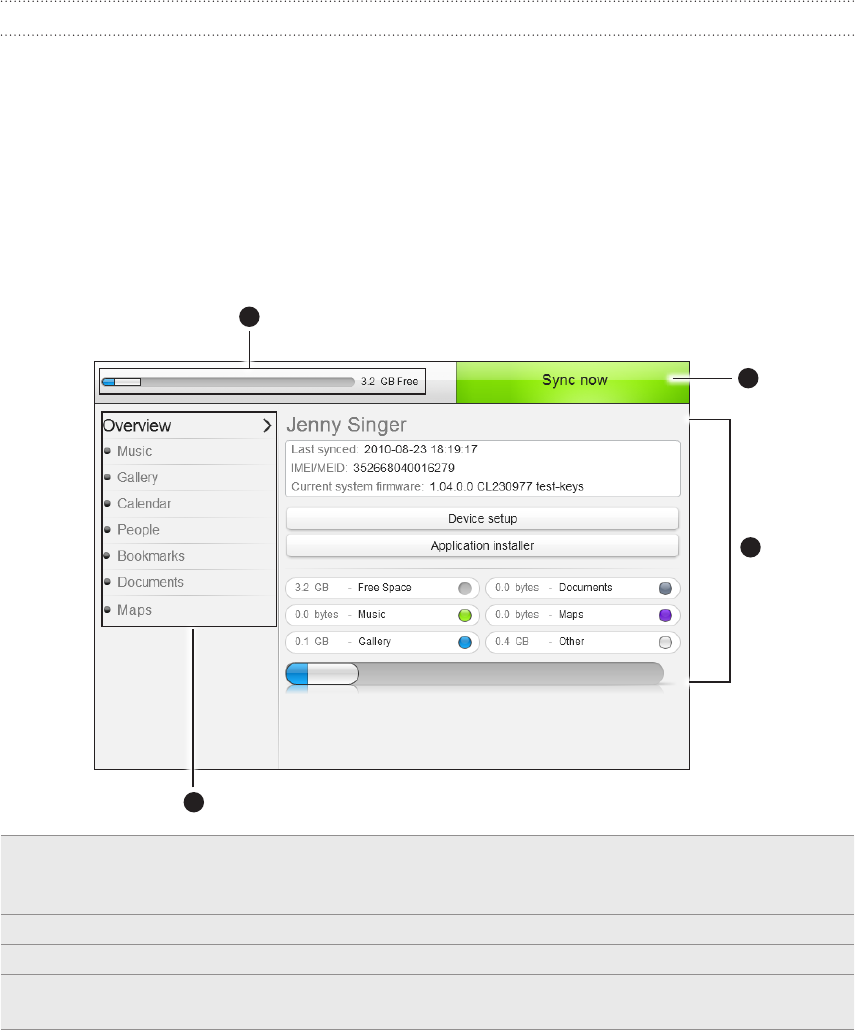
79 Accounts and sync
Setting up HTC Sync to recognize your phone
After installing, set up HTC Sync to recognize your phone.
1. Connect your phone to your computer using the supplied USB cable.
2. On your phone’s Connect to PC screen, tap HTC Sync, and then tap Done.
On your computer, wait for HTC Sync to recognize your phone.
3. When the Device setup screen opens, enter a name for your phone, and then
click Save.
The Device panel then opens.
4
2
3
1
1Click a category of items to see its sync options on the right section of the Device panel.
Click Overview to see your phone’s basic software information and storage card usage,
change the phone name, or install third-party apps to your phone.
2Shows the available sync options for the category you’ve selected.
3Click to start synchronization.
4 Estimated storage usage bar. When there are new items to be synchronized and added to
your phone, this bar shows the estimated storage card space that will be used.

80 Accounts and sync
Setting the Music sync options
Bring the music tracks and songs you play on your computer to your phone. If you
have playlists created in iTunes® or Windows Media® Player, you can sync these too and
enjoy them on the go.
You can sync audio files in these formats:
*.aac, *.amr, *.m4a, *.mid, *.midi, *.mp3, *.wav, and *.wma.
1. On the Device panel, click Music, and then click the On button.
Turning Music sync on means you want this category included every time you
sync your computer and phone.
2. Select Sync music files from, and then click Add.
3. Choose the folder that contains your audio files, and then click OK.
All supported audio files added to this folder will also be copied to your phone’s
storage card during synchronization.
4. Select Sync music files from iTunes and Windows Media Player if you’re using
any of these apps on your computer. Then, choose one of the following:
All songs and playlists Choose to sync all songs and playlists from iTunes and
Windows Media Player.
Selected playlists Choose to select only your favorite playlist titles.
Setting the Gallery sync options
You can choose to automatically copy your phone camera shots to your computer. At
the same time, when you select a folder from your computer, the photos and videos
stored in it are also synchronized on your phone’s storage card.
You can sync photos and videos in these formats:
Photos: *.bmp, *.gif, *.jpeg, *.jpg, and *.png.
Videos: *.3gp, *.3g2, *.mp4, and *.wmv.
On the Device panel, click Gallery, and then click the On button.
Turning Gallery sync on means you want this category included every time you
sync your computer and phone.
2. To automatically import your camera shots to your computer during
synchronization, select Copy device Camera Shots to PC.
Photos and videos from your storage card will be saved to the
\My Photos\Device Camera Shots folder on your computer.
3. Select Sync PC photos & videos from, and then click Add.
4. Choose the folder on your computer that contains your multimedia files, and
then click OK.
All supported image and video files added to this folder will also be copied to
your phone’s storage card during synchronization.
1.

81 Accounts and sync
Setting Calendar sync options
Your phone can sync appointments and events with your calendar in Outlook
(Outlook XP, Outlook 2003 or Outlook 2007) or Windows Calendar (for Windows
Vista).
On the Device panel, click Calendar, and then click the On button.
Turning Calendar sync on means you want this category included every time you
sync your computer and phone.
2. Select the app you want to sync calendar events with.
3. Choose the number of days of calendar events to sync. You can choose One
week ago, Two weeks ago, or One month ago.
4. In cases when conflicting information are found on both the phone and
computer, choose which information you want to keep.
You can only sync the following calendar event details: Event name, Event date, Start time,
End time, Event location, Description, Reminder, and Repetition.
Setting People sync options
Sync your phone contacts with your Outlook (Outlook XP, Outlook 2003 or Outlook
2007), Outlook Express, or Windows Contacts (for Windows Vista).
If you have contacts to sync from your SIM card, you have to import these first to your
phone storage.
1. On the Device panel, click People, and then click the On button.
Turning People sync on means you want this category included every time you
sync your computer and phone.
2. Choose the app you want to sync your contacts with.
3. In cases when conflicting information are found on both the phone and
computer, choose which information you want to keep.
Only the contact fields supported on your phone will be synchronized.
Setting Bookmarks sync options
Sync the bookmarks inside the “HTC Bookmarks” favorites folder in your computer’s
web browser with the bookmarks stored on your phone’s web browser.
1. On the Device panel, click Bookmarks, and then click the On button.
Turning Bookmarks sync on means you want this category included every time
you sync your computer and phone.
2. Choose the web browser that stores the bookmarks to sync with your phone.
Only the web page title and URL information are synchronized.
If you are using Firefox® and have selected it to sync with your phone, make sure to close all
Firefox browser windows before you begin synchronization.
When conflicting information are found on both the phone and computer, HTC Sync keeps
the information from your computer.
1.

82 Accounts and sync
Setting Documents sync options
You can sync files and documents from your computer to your phone. Make sure that
your phone has the app needed to open or view such files and documents.
Usually, your phone can open and view these file types: Microsoft Office 2003 and
2007 Word (.doc), Excel (.xls), and PowerPoint (.ppt), PDF files (.pdf), Text files (.txt).
You can also sync email attachments that you stored on your phone’s storage card to
your computer.
To sync email attachments stored on your phone’s storage card to your computer, you must
set up an Exchange ActiveSync or POP3/IMAP email account on your phone using Mail. For
more information on how to do this, see the Email chapter.
1. On the Device panel, click Documents, and then click the On button.
Turning Documents sync on means you want this category included every time
you sync your computer and phone.
2. To sync email attachments that you’ve stored on your phone’s storage card,
select Copy all download Mail documents to PC.
When you sync the phone with your computer, email attachments will be saved
to the \My Documents\Device documents\ folder on your computer.
3. To sync files and documents from your computer to your phone’s storage card,
select Sync PC documents from, and then click Add.
4. Choose a folder that contains the files you want to sync with your phone, and
then click OK.
When you sync the phone with your computer, the files and documents from
your computer will be saved to the \My Documents\Documents\ folder on your
phone’s storage card.
Setting Maps sync options
Before going on a trip to another city or country, you can download the maps you
need using HTC Sync on your computer, then sync it to your phone. Aside from
different maps, you can also purchase licenses for other useful data such as driving
and walking navigation, safety camera map views, and more.
To find out how you can use the downloaded content on your phone, see the Maps
and location chapter for more information.
1. On the Device panel, click Maps, and then click the On button.
Turning Maps sync on means you want this category included every time you
sync your computer and phone.
2. Choose one of the following:
All Maps and Licenses Choose to sync all maps and licenses between your
computer and your phone.
Select Maps and Licenses Choose to sync only the maps and licenses you want.
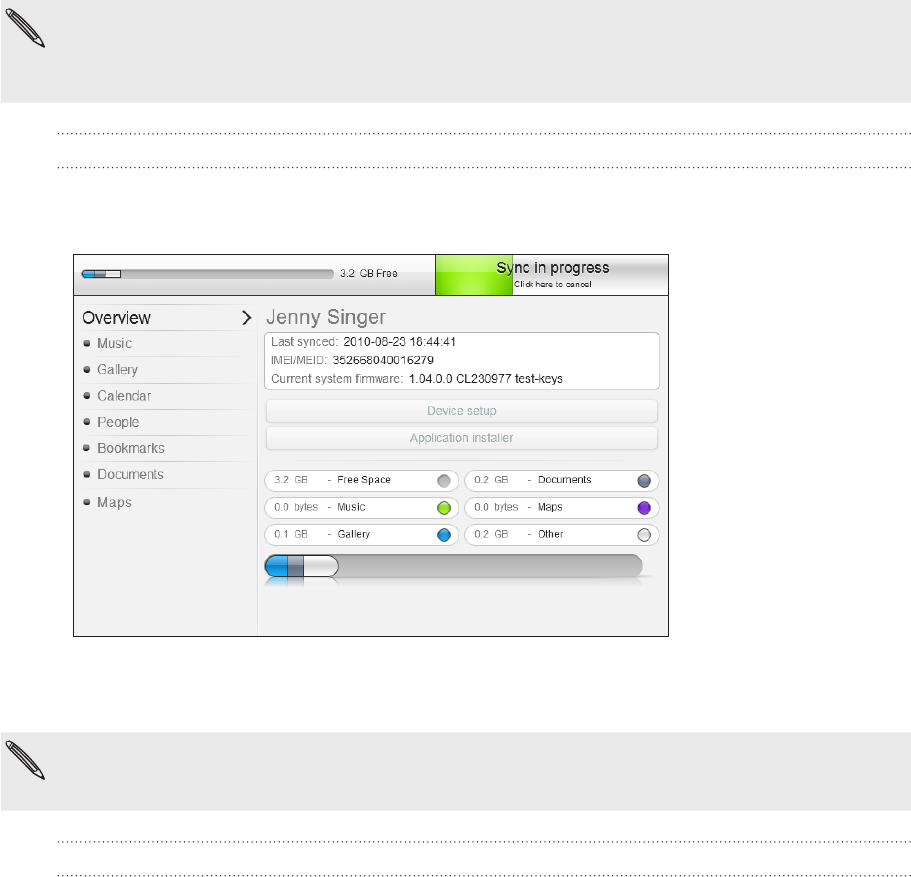
83 Accounts and sync
3. If you want to purchase and download more maps and other data, click Get
more Maps and Licenses.
The Maps feature will be available in the next release of HTC Sync. You can use it to download
maps, voices, and add-on services for your phone’s Locations app to your computer first, and
then sync them to your phone. Visit our support website (www.htc.com/support) from time to
time to check for updates and more information.
Synchronizing your phone
When you are done setting up synchronization for your selected categories, click the
Sync now button.
After synchronization is complete, click Disconnect and safely remove your phone as
required by your computer’s operating system. The next time you connect your phone
to your computer, synchronization automatically begins based on your sync options.
Always check the estimated file size of new items that you want to synchronize with your
phone. You will see a warning icon beside the estimated storage usage bar when there isn’t
enough space left on your storage card.
Installing apps from your computer to your phone
If you have app (*.apk files) on your computer, you can use HTC Sync to install them to
your phone. We strongly recommend that you install only app that you trust.
Before you begin, make sure that your phone is set to allow app from your computer
to be installed to your phone. To do this, press MENU from the Home screen, tap
Settings > Applications, and then select the Unknown sources check box.
1. Connect your phone to the computer with the supplied USB cable.
2. On your phone’s Connect to PC screen, tap HTC Sync and then tap Done.
HTC Sync automatically starts on your computer.
3. On the Device panel of HTC Sync, click Application installer.
4. Locate the app on your computer, and then click Open.
5. Click Done. The installation process starts on your phone.

84 Accounts and sync
6. Check your phone’s screen to see if there are additional instructions to complete
the installation.
7. After installation is complete, you can click Disconnect and safely remove your
phone as required by your computer’s operating system.
Synchronizing another phone with your computer
HTC Sync can synchronize up to three phones with your computer, making your
favorite music, videos, photos, and files always available to you.
Make sure that all the phones you connect with your computer and synchronize using HTC
Sync are running on Android 2.1 or later.
1. Connect the other phone to your computer using the supplied USB cable.
2. On the phone’s Connect to PC screen, tap HTC Sync, and then tap Done.
3. On your computer, wait for HTC Sync to recognize the other phone. When the
Device setup screen opens, enter a name for the phone, and then click Save.
4. You can separately customize your sync settings for this phone.
To switch between the connected phones, click Devices on the top left corner of
the Device panel, and then click the phone’s name or image.

85 Social
Social
Facebook for HTC Sense
If you signed in to your Facebook account when you turned on and set up your phone
for the first time, that means your Facebook account is linked to Facebook for HTC
Sense on your phone. (If you did not do this, see the Accounts and sync chapter to
find out how to sign in to Facebook for HTC Sense.)
With Facebook for HTC Sense, you can:
See all your Facebook contacts and their instant status updates in People.
When you tap a contact on the People screen, slide
to the Updates and events tab to see updates such
as posted status messages, uploads, and profile
changes.
When there is a notification of the contact’s birthday,
you can tap the notification to call the contact
directly or send a message greeting.
See Facebook photos right on the Gallery app.
You can also upload one or more photos from your
storage card to Facebook, then tag and add captions
that go with it.
When you’re viewing the albums of a Facebook
friend, you can also share a link to a particular album,
or comment on the album photos.
To know more about viewing Facebook photos, see
the Photos, videos, and music chapter.
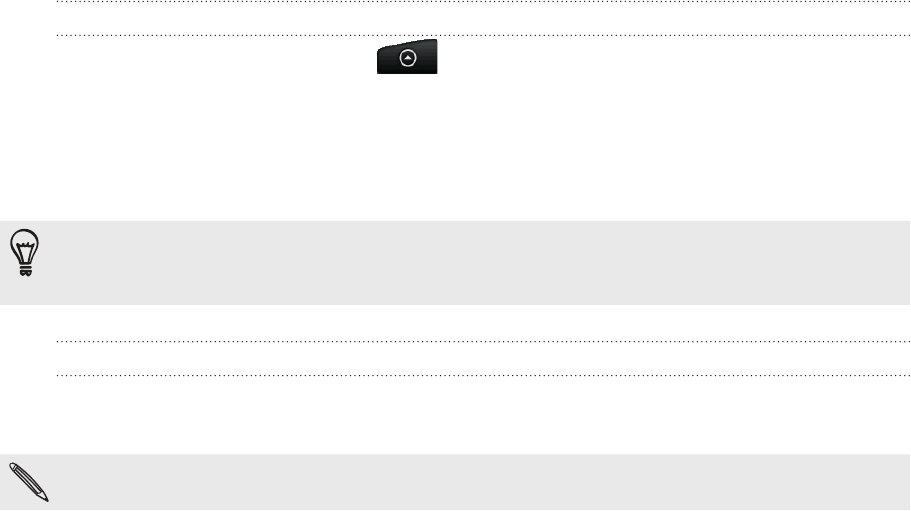
86 Social
Check your friends’ Facebook status updates in Friend Stream. See “Friend
Stream” to find out the things you can do on the Friend Stream app.
Add your Facebook events and your friends’ birthdays to the Calendar app.
See the Calendar chapter for details.
Facebook for Android
The Facebook app on your phone lets you keep up and stay close with your friends
in Facebook. It offers most of the features that you are familiar with when using
Facebook on your computer.
With the Facebook app, you can:
Share your thoughts and check other people’s status updates.
View your friends list and write on someone’s wall.
Comment on and like a friend’s post.
View someone’s personal information, including photo albums.
Check your Facebook notifications.
Take a photo and upload it straight to your Facebook account.
Using the Facebook app
1. Press HOME, and then tap > Facebook.
2. If this is your first time to use Facebook, follow the onscreen instructions to sign
in to your Facebook account.
3. On the News Feed screen, press MENU, and then tap Home to access the other
functions.
While on the Facebook home screen, press MENU, and then tap Settings to set refresh and
notification options.
On some Facebook screens, you can press and hold an item to open an options menu.
Adding the Facebook widget
Add the Facebook widget to the Home screen by following the steps in “Personalizing
your Home screen with widgets” in the Personalizing chapter.
The widget will only link to the Facebook account that you logged into on the Facebook app.

87 Social
What’s the difference between Facebook for
Android and Facebook for HTC Sense?
Facebook for HTC Sense is not a standalone app. It is integrated in People,
Friend Stream, Gallery, and Calendar to give you up-to-date information
about your Facebook contacts (their status updates, shared links, and photos)
in these apps.
Facebook for Android is a standalone app. Use this app to do most of the
things that you would do when you’re using your computer’s web browser
to access your Facebook account, such as adding a friend and sending
Facebook messages.
The two do not share the same login credentials. Signing in to Facebook for
HTC Sense does not sign you in to the Facebook for Android app and vice
versa. If you want to use the same Facebook account for both, you’ll have to
sign in to both using the same login credentials.
If you have more than one Facebook account, you may sign in to the Facebook app using
your second account, since the Facebook app does not share the same login credentials as
Facebook for HTC Sense.
Tweeting on your phone
You can post and read tweets, send and receive direct messages, search for new
Twitter users to follow using the Peep app. Peep is a Twitter client that lets you enjoy
“tweeting” on your phone.
You can also link your contacts in People to their Twitter profiles (if you’re following
them). To find out how, see “Merging contact information” in the People chapter.
If you did not sign in to your Twitter account when you first turned on the phone, you
can do one of the following:
Sign in to your Twitter account from Peep. From the Home screen, tap
> Peep, then follow the onscreen instructions.
Add the Twitter for HTC Sense account in Settings > Accounts & sync. To find
out how, see “Adding a social network account” in the Accounts and sync
chapter.
Twitter for HTC Sense and Peep share the same login credentials. This means that when you
use Peep on your phone for tweeting, you can also link your contacts to their Twitter profiles
via Twitter for HTC Sense.
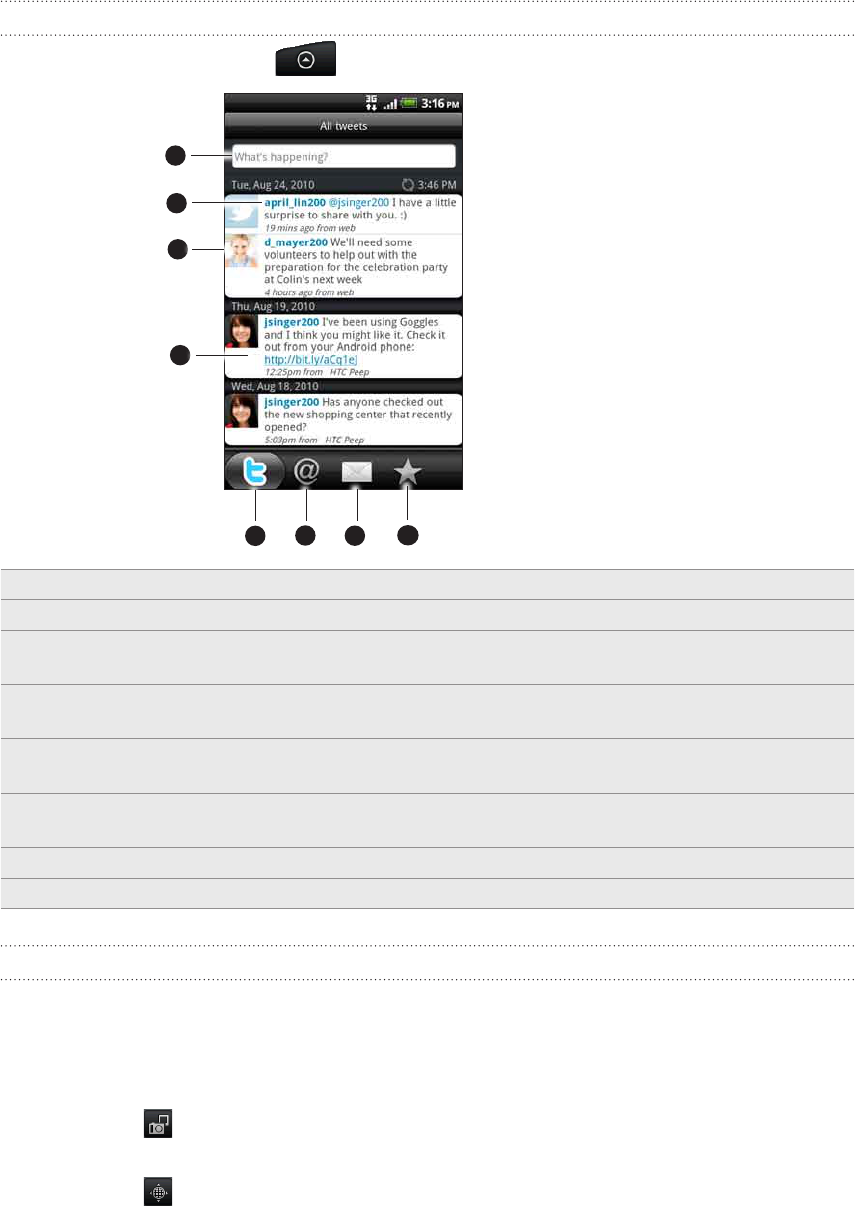
88 Social
Using Peep
From the Home screen, tap > Peep. Peep opens in the All tweets tab.
4
567
1
2
3
8
1 Tap in this area to compose and send a tweet.
2 Tap a person’s name to check profile details and all of his or her tweets.
3 If you have linked the contact in People, tap the photo or icon to open a menu where you
can quickly choose how to communicate with the contact.
4 Press and hold a tweet to open an options menu to reply, send a direct message, retweet,
and more.
5 All tweets tab. View all the tweets from people you follow and tweets that you have
posted.
6 Mentions tab. View all tweets that mention your username using the “@[your username]”
convention.
7 Direct message tab. View all private/direct messages that you have received or sent.
8 Favorites tab. View tweets that you have marked as favorites.
Sending a tweet
On the All tweets tab, tap the box that says “What’s happening?”.
Type your tweet.
Add a picture or location to your tweet.
Tap to post a picture from Gallery or Camera to your default photo
hosting site and add the link to the picture in your tweet.
Tap to insert your location into the tweet. You can choose to add a map
link, insert your location name, or insert your position coordinates.
4. Tap Update.
1.
2.
3.

89 Social
Searching for Twitter users to follow
On the Peep screen, press the SEARCH button.
Type a Twitter name in the search box.
You can also narrow down the search when you tap > Users.
3. Tap .
4. In the list of search results, tap the Twitter user you want to follow.
5. Press MENU, and then tap Follow.
Unfollowing a Twitter user
On the Peep screen, tap the name of the Twitter user you want to stop following.
Press MENU, and then tap Unfollow.
Sending a direct message
You can only send a direct message to someone who is following you.
On the Peep screen, press MENU, and then tap New message.
2. Tap the To field, and then enter the name. As you enter characters, the names of
the Twitter users that match the characters you enter will appear. Tap the name
when you see it.
3. Enter your message, and then tap Update.
You can also send a direct message when you press and hold a tweet of the person
you want to send the direct message to, and then tap Send direct message on the
options menu.
Setting Peep options
On the Peep screen, press MENU, and then tap More > Settings. You can set these
options:
Account settings Sign out of your Twitter account.
General settings Choose whether to show the screen name or the real name of the
people you follow.
Send & receive Set the frequency to check for new tweets and set the number of
tweets to download.
Services Set your photo hosting site, photo quality, location options, and URL
shortening host.
Notification settings Select when and how you want to be notified.
About the Twitter widget
Use the Twitter widget to send and follow your tweets right on your Home screen.
To find out how to add a widget to the Home screen, see “Personalizing your Home
screen with widgets” in the Personalizing chapter.
1.
2.
1.
2.
1.
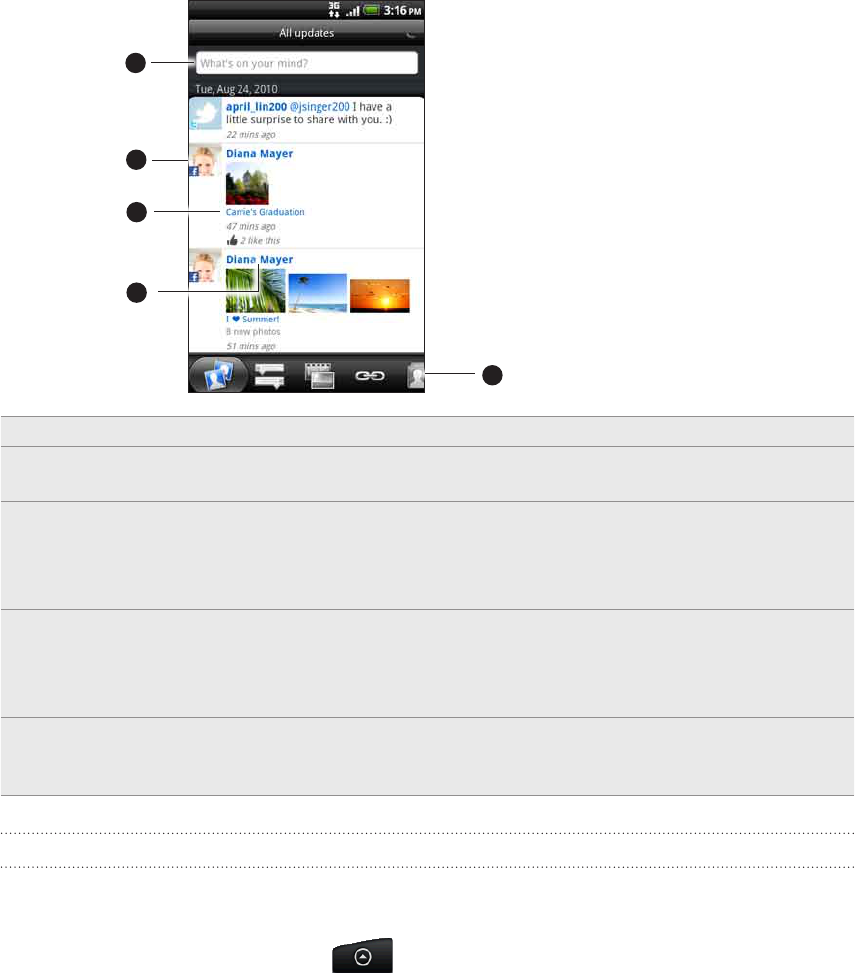
90 Social
Friend Stream
Friend Stream connects you to your social networks. Share and get updates
from friends in popular networks like Facebook and Twitter in a single feed. With
Friend Stream, you can easily track your friends’ status messages, photo uploads,
notifications, and more — or comment and post your own.
You must be signed in to at least one social network account to use Friend
Stream. To find out how, see “Adding a social network account” in the
Accounts and sync chapter.
To use your Facebook account on Friend Stream, you need to be signed in via
Facebook for HTC Sense. See “Facebook for HTC Sense” in this chapter.
2
1
4
3
5
1 Tap in this area to compose and send a status update.
2 If you have linked the contact in People, tap the photo or icon to open a menu where you
can quickly choose how to communicate with the contact.
3 When you tap someone’s status update, you can:
Open Peep and view all tweets. See “Tweeting on your phone” in this chapter.
Write a comment. Like or unlike someone’s Facebook posts.
Look at someone’s album photos.
4 When you tap someone’s name, you can:
Check the person’s profile details.
Look at the person’s Facebook wall.
Check the person’s posted tweets.
5 Slide to the other tabs to view social network updates grouped as status updates only,
photo uploads, links, updates from members of your Facebook list, or social network
notifications.
Updating your status
You can update your status simultaneously on all the social network accounts you are
signed in to.
From the Home screen, tap > Friend Stream.
On the All updates tab, tap the box that says “What’s on your mind?”.
1.
2.
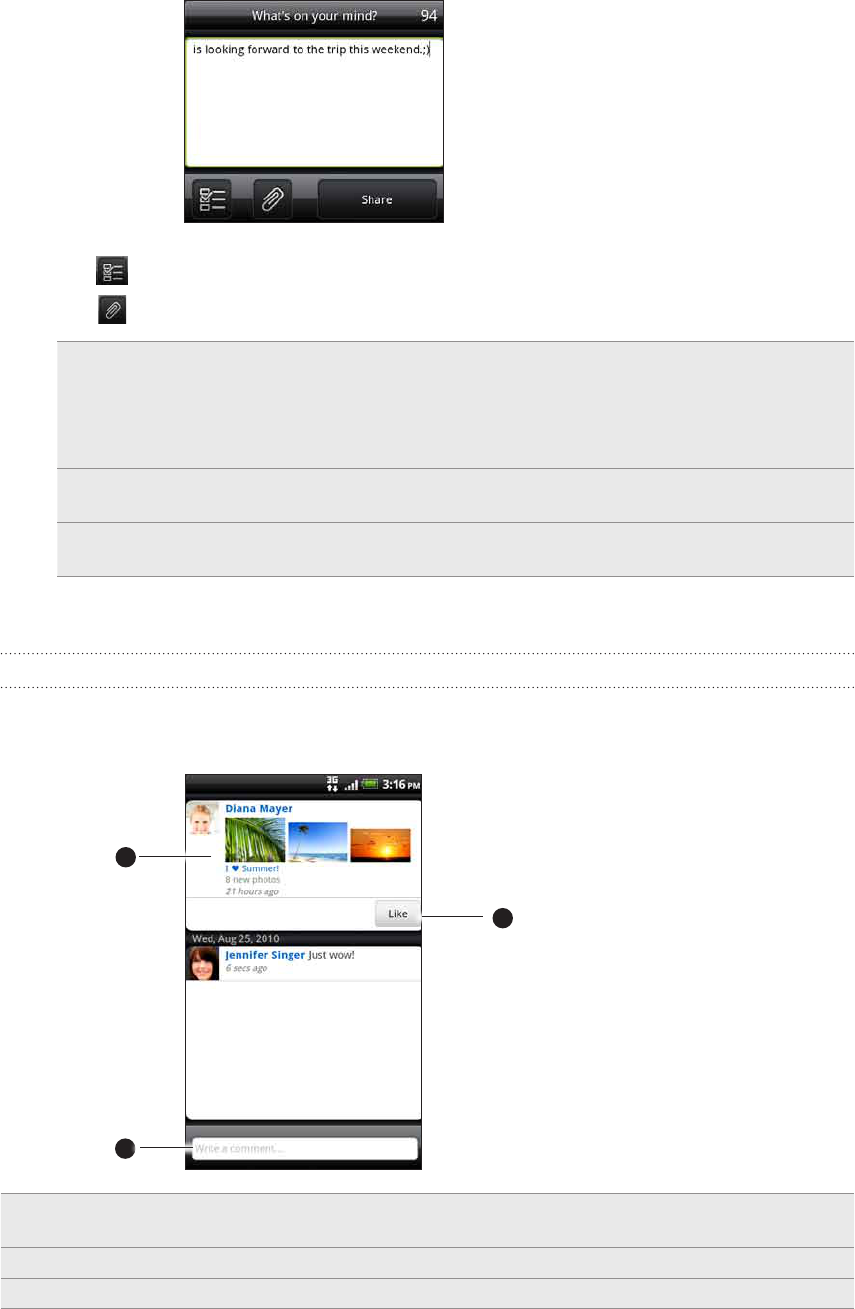
91 Social
Enter your status update.
4. If you do not want to send the status update to all your social network accounts,
tap and clear the check boxes of the social networks to exclude.
5. Tap and then choose what you want to attach to your tweet or status update.
App recommendation Choose an app you’ve installed from Android Market that you
want to share with others. The URL from which the app can be
downloaded will be inserted to your status.
To find out more about sharing app, see “Sharing games and
apps” in the More apps chapter.
Picture Select From Camera to take a photo and attach it or From
Gallery to attach a photo from your storage card.
Location Add your current location or a location you pick on a map. See
the Maps and location chapter for details.
6. Tap Share.
Commenting on and liking Facebook posts
After tapping someone’s status update on the All updates tab, you can do the
following:
2
1
3
1 Tap a photo or the album name shown in the status update to view and comment on the
album photos using the Gallery app. See the Photos, videos, and music chapter.
2 Type what you think about the person’s status update.
3 Like or unlike the person’s status update.
3.
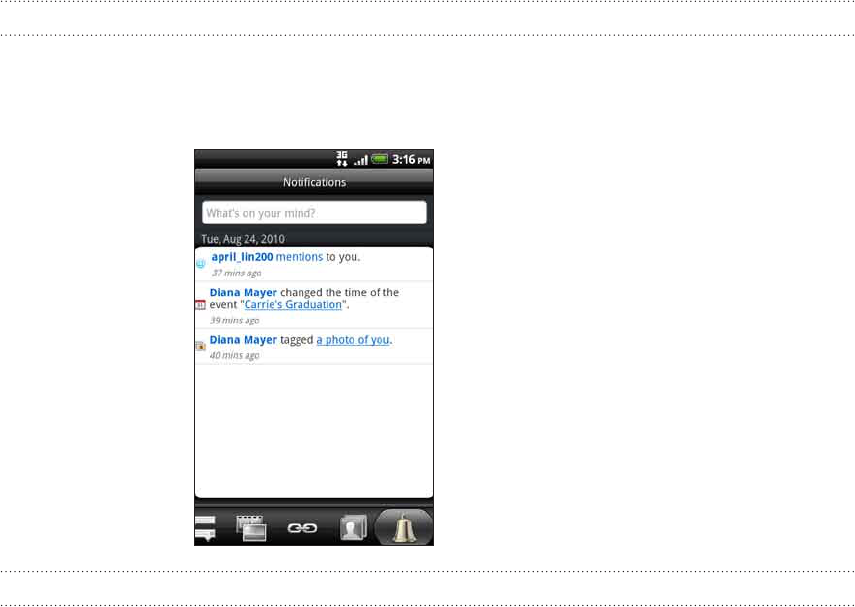
92 Social
Checking notifications from your social networks
Slide to the Notifications tab to easily see a single feed of your notifications from
different social networks. It can be a comment on your Facebook post, a mention or
direct message in Twitter, a tagged photo of you, and more.
About the Friend Stream widget
Use the Friend Stream widget so you can easily update your status and view other
people’s status updates right on the Home screen.
If you don’t have this widget on your Home screen, see “Personalizing your Home
screen with widgets” in the Personalizing chapter to find out how to add it to the
Home screen.
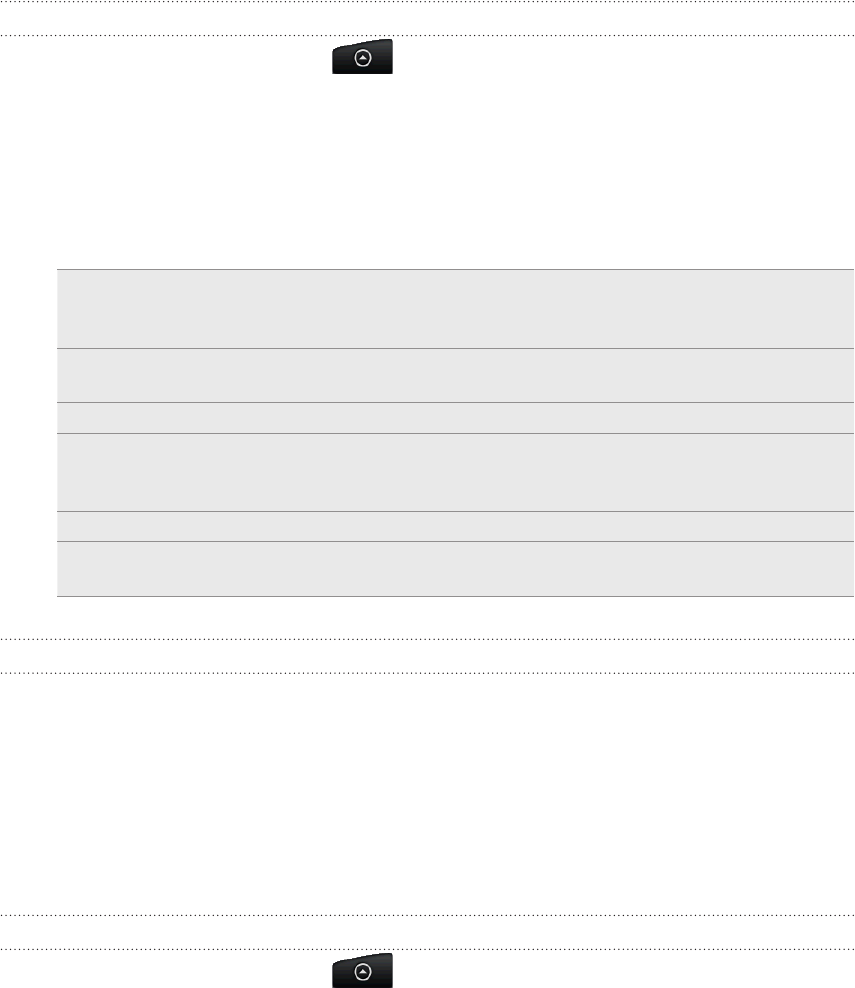
93 Social
Chatting in Google Talk
Google Talk is Google’s instant messaging program. It lets you communicate with
other people that also use Google Talk.
If you signed in to your Google Account when you first set up the phone, you are
already signed in to Google Talk.
Chatting with friends
From the Home screen, tap > Talk.
Tap a friend in the Friends list.
Enter your message in the text box. You can also insert a smiley by pressing
MENU, and then tapping More > Insert smiley.
Tap Send.
While chatting, press MENU and then tap any of these options:
Chat off record Your Google Talk messages are stored in the Chats folder of your
Gmail account. Tap this option if you don’t want to store your chat
messages.
Switch chats If you have more than one chat going, tap this to switch chat with
another friend.
Friends list Return to the Friends list.
Add chat Add another friend to your chat. The friend you invited and the friend
your currently chatting with receive an invitation to a group chat. Each
one who accepts the invitation joins the group chat.
End chat End your current chat.
More Clear the chat history, insert a smiley or view your friend’s contact
details.
Accepting chat invitations
When a friend sends you a Google Talk message, you receive a notification. Their entry
in the Friends list turns white and displays the message.
Do one of the following:
In the Friends list, tap the friend who sent you the invitation to chat.
Open the Notifications panel, and then tap the chat notification. See “Opening
the Notifications panel” in the Getting started chapter.
Changing your online status and picture
From the Home screen, tap > Talk.
In the Friends list, tap your name to open the Set Status screen.
Enter your new status message, or press BACK to choose a custom status from
the list.
Tap the online status beside your picture, and then select the status you want on
the menu.
1.
2.
3.
4.
5.
1.
2.
3.
4.
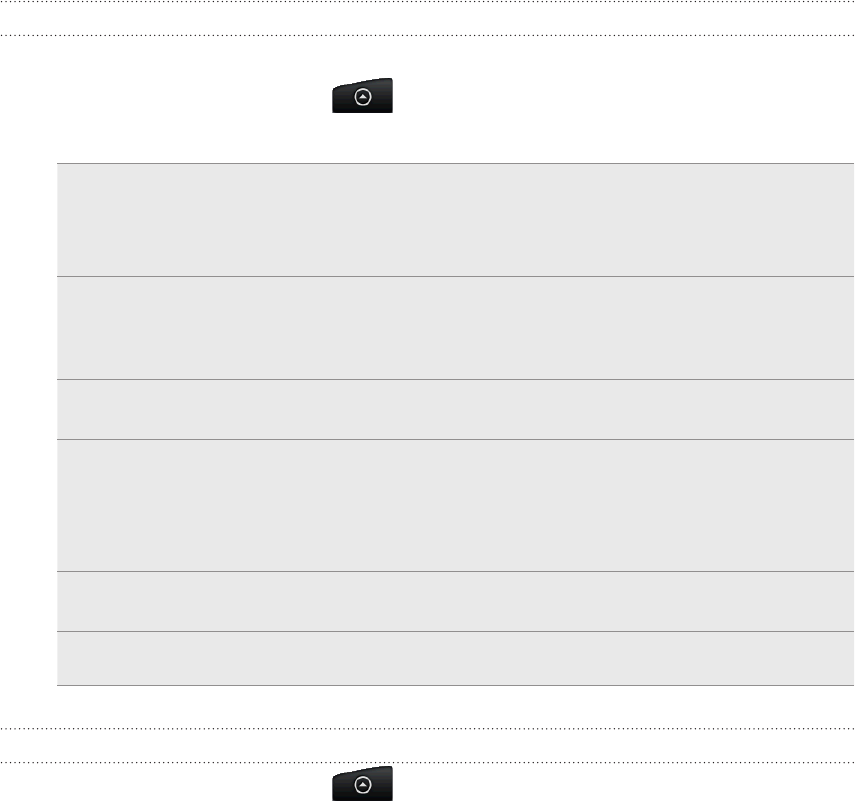
94 Social
Tap your picture, and then tap Remove to remove your photo, or Change to
select another picture on the storage card. Note that if you’ve selected a big
picture, you will be asked to crop it.
Tap Done.
Your online status, message, and picture appear in your contact’s Friends lists and in
other apps where your Google Talk status are displayed.
Adding and managing friends
The Friends list is where you add and manage your friends in Google Talk.
From the Home screen, tap > Talk.
In the Friends list, do any of the following.
Invite a friend 1. Press MENU, and then tap Add friend.
2. Enter the Google Talk instant messaging ID or Gmail address of
the friend you want to add.
3. Tap Send invitation.
View all friends Initially, only those friends that you often chat with — the most
popular — are shown in the Friends list. To view all your friends,
press MENU, and then tap All friends. To view only friends that you
often chat with, press MENU, and then tap Most popular.
Make a friend
popular
1. Press MENU, and then tap All friends.
2. Press and hold a friend’s name, and then tap Always show friend.
Block a friend You can block a friend from sending you messages. When blocked,
your friend is removed from the Friends list and is added to the
blocked friends list.
1. Press MENU, and then tap All friends.
2. Press and hold a friend’s name, and then tap Block friend.
Unblock a friend 1. Press MENU, and then tap More > Blocked.
2. Tap the name of the blocked friend, and then tap OK.
View all invited
friends
Press MENU, and then tap More > Invites. Friends who have not yet
accepted your invitation are listed in the screen.
Changing the settings and signing out
From the Home screen, tap > Talk.
In the Friends list, press MENU and then tap:
Settings to change the app and notification settings.
Sign out to sign out from Google Talk.
5.
6.
1.
2.
1.
2.
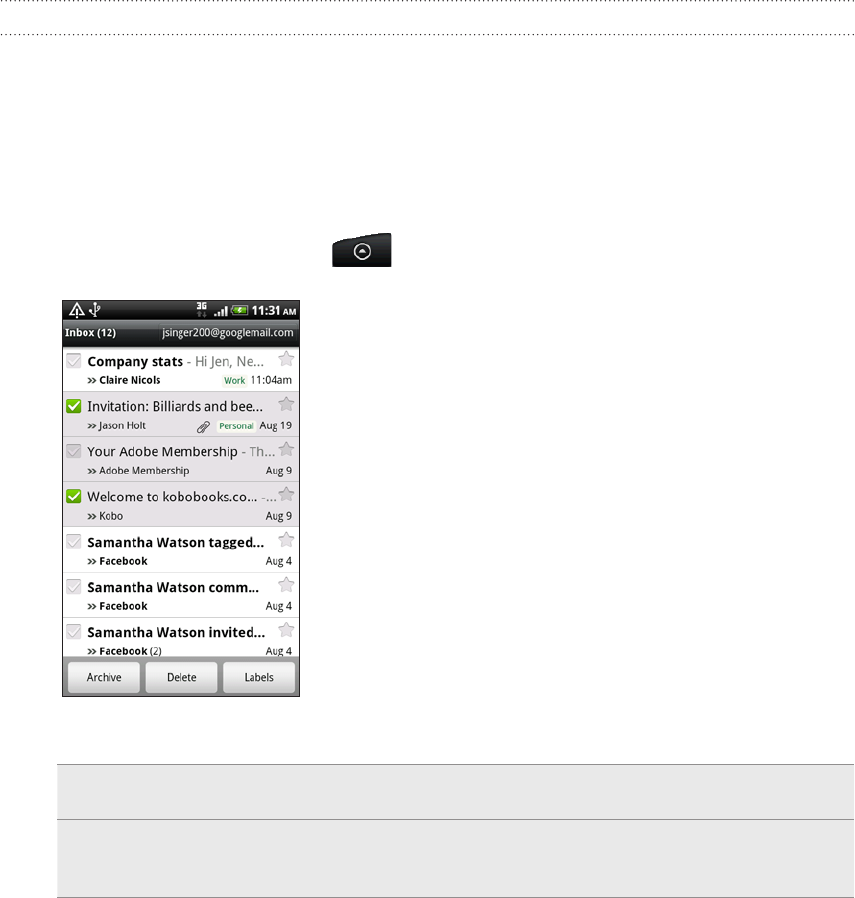
95 Email
Email
Using Gmail/Google Mail
Gmail/Google Mail is Google’s web-based email service. When you first set up your
phone, make sure you sign into your Google Account so you can send and receive
Gmail/Google Mail messages. If you didn’t do so, go to the Accounts & sync setting to
sign in.
You can also set up more than one Google Account on your phone, and then switch
between accounts in Gmail/Google Mail. To find out how to set up several Google
Accounts, see “Adding more Google Accounts” in the Accounts and sync chapter.
Viewing your Gmail/Google Mail Inbox
The Inbox conversations list is your default Gmail/Google Mail view. All your received
emails are delivered to your Inbox.
Gmail/Google Mail groups each message you send with all the responses you receive.
This conversation list continues to grow as new replies arrive, so you can always see
your messages in context. A new message or a change to the subject of a current
message will begin a new conversation.
1. From the Home screen, tap > Gmail/Google Mail.
Your inbox appears.
2. Do any of the following:
View more email
messages
If the Inbox is full, swipe your finger up the screen to view more
messages and conversations.
Read a new email
message
Tap the unread message or the conversation with an unread
message (just arrived items display in bold). For more
information, see “Reading your messages.”
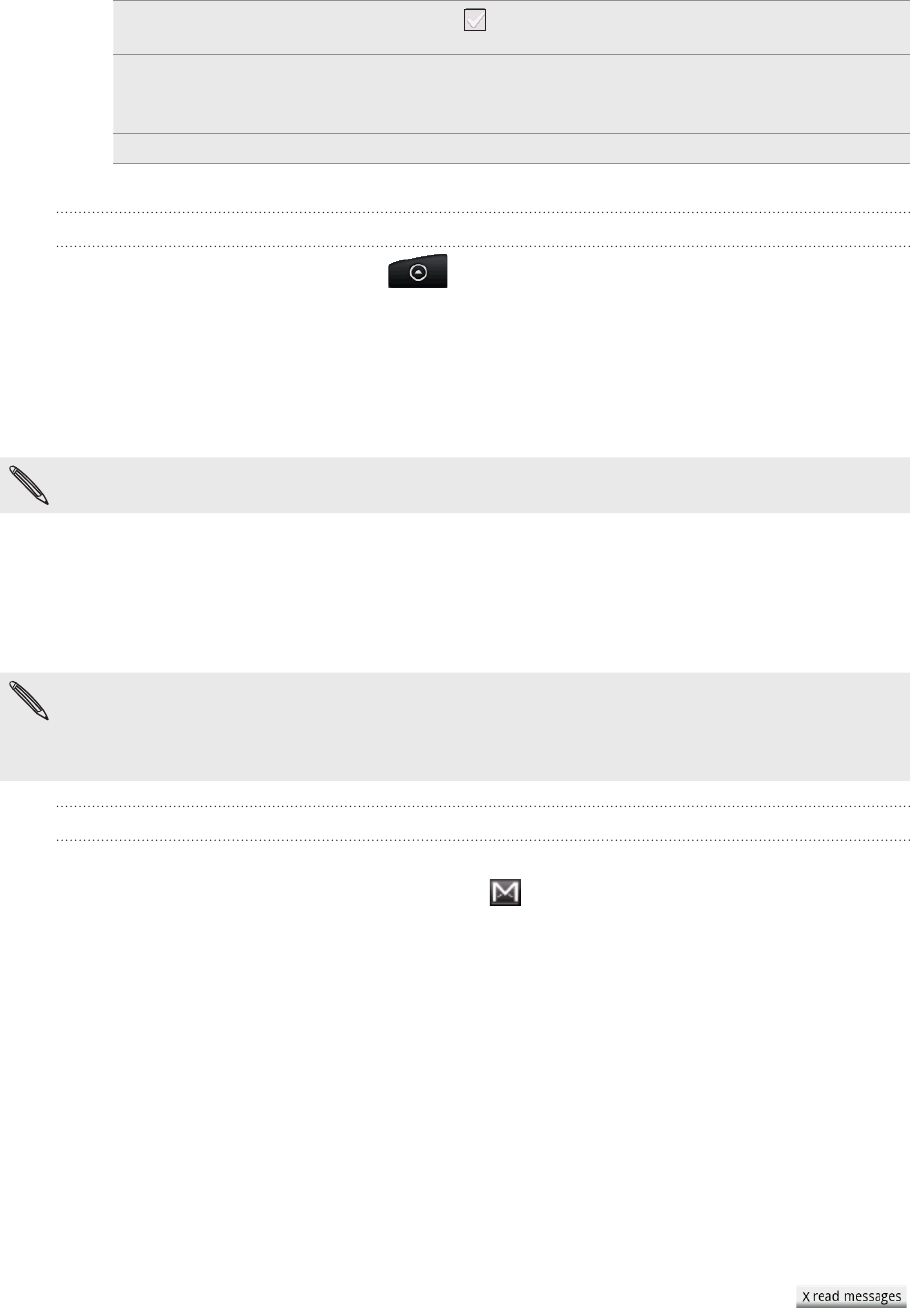
96 Email
Select messages and
conversations
Tap the box ( ) before the email or conversation.
View the Inbox of your
other Gmail/Google
Mail account
Press MENU, tap Accounts, and then tap the account you want
to view.
Refresh the Inbox Press MENU, and then tap Refresh.
Sending a new message
1. From the Home screen, tap > Gmail/Google Mail.
2. In the Inbox, press MENU and then tap Compose.
3. Enter the message recipient’s email address in the To field. If you are sending the
email to several recipients, separate the email addresses with a comma.
As you enter email addresses, any matching addresses from your contacts list
are displayed. Tap a match to enter that address directly.
If you want to send a carbon copy (Cc) or a blind carbon copy (Bcc) of the email to other
recipients, press MENU and then tap Add Cc/Bcc.
4. Enter the email subject, and then compose your email.
5. If you want to attach a picture, press MENU and then tap Attach. Locate and
then tap the picture you want to attach.
6. After composing your message, tap Send.
While composing the message, tap Save as draft or press the BACK button to save it as a
draft. To view your draft email messages, in the Inbox, press MENU and then tap
Go to labels > Drafts.
To view your sent messages, in the Inbox, press MENU and then tap Go to labels > Sent.
Reading your messages
Depending on your notification settings, the phone plays a ringtone or vibrates when
you receive a new email. A new email icon ( ) also appears on the notifications
area of the status bar to tell you that you have a new email. For more information on
email notification settings, refer to “Changing Gmail/Google Mail settings” later in this
chapter.
1. Press and hold the status bar, and then slide down your finger on the screen to
open the Notifications panel.
2. Tap the new email.
3. In the Inbox, tap the unread email or the conversation with the unread email to
view it.
4. On the email message or conversation, do any of the following:
Scroll through the messages in the conversation by swiping your finger up
or down the screen.
If you have two or more email messages in the conversation, tap
to expand all message headers in the conversation.
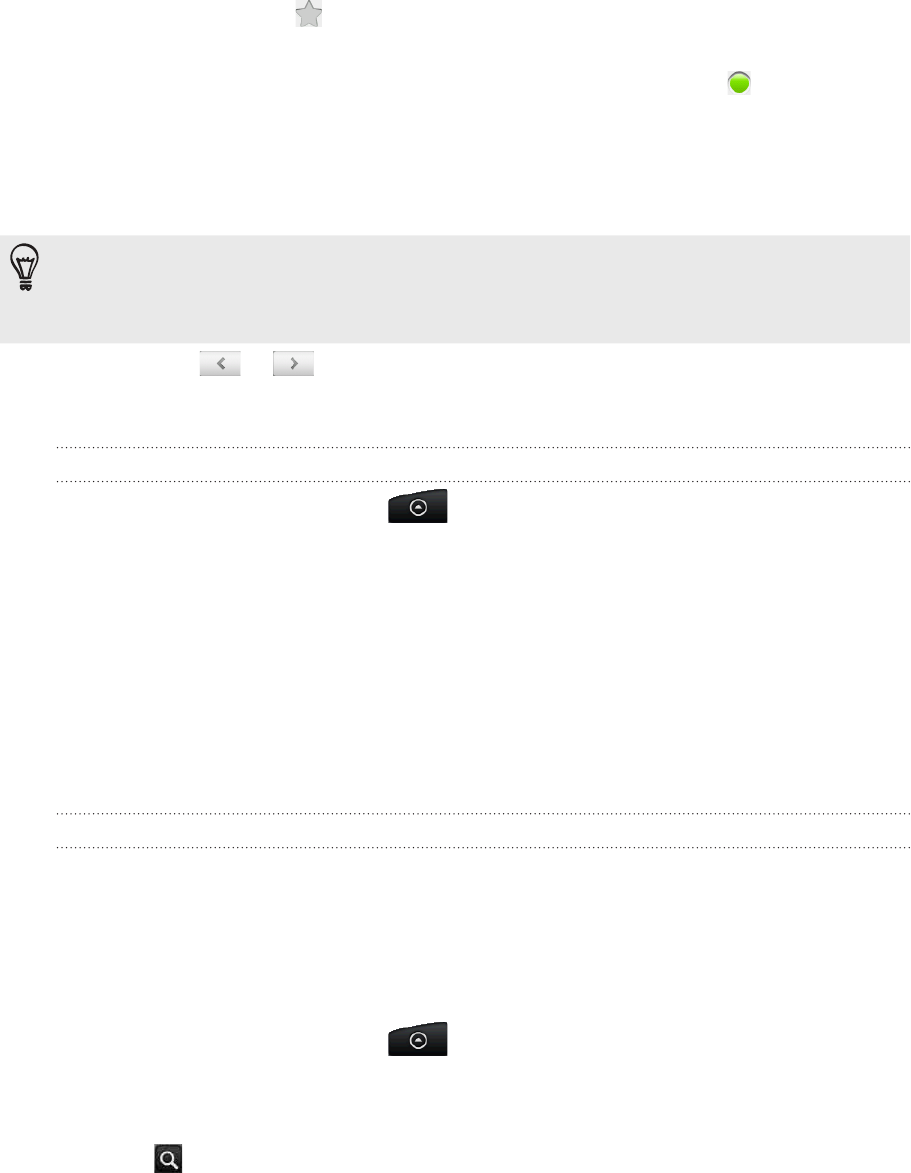
97 Email
Tap the star ( ) to star the message. See “Searching and organizing your
emails” for more information.
If the sender is a friend in Google Talk, check the button ( ) before the
star in the message header to know your friend’s online status.
Tap Archive to remove the conversation from your Inbox and transfer it to
the All mail folder in your Google Account.
Tap Delete to delete the conversation from your Inbox.
If you’ve archived or deleted a conversation by accident, tap Undo at the top of the
conversations list. The conversation is returned to your Inbox.
To view your archived or deleted messages, in the Inbox, press MENU and then tap
Go to labels > All Mail (for archived messages) or Trash (for deleted messages).
Tap or to see the previous or next conversation in your Inbox.
Press MENU to see more options.
Replying to or forwarding an email message
1. From the Home screen, tap > Gmail/Google Mail.
2. In the Inbox, tap the email message or conversation.
If the email message is long, swipe your finger up the screen.
3. Tap Reply, Reply to all, or Forward.
4. Do one of the following:
If you selected Reply or Reply to all, enter your reply message.
If you selected Forward, specify the message recipients.
5. Tap Send.
Searching and organizing your emails
Searching for messages
You can search for messages that contain one or more words in their contents or in
their addresses, subjects, labels, and so on. When you search for messages, all of the
messages in your Gmail/Google Mail account on the web are included (except those
labeled Trash or Spam), not just those that you’ve synchronized onto your phone.
1. From the Home screen, tap > Gmail/Google Mail.
2. In the Inbox, press SEARCH.
3. Enter the word or words to search for.
4. Tap , or tap the Enter key on the onscreen keyboard.
A conversation list opens, displaying all of the conversations with messages that
contain the words you searched for. The words you searched for are displayed below
the status bar. You work with the conversations in this list just as you would with the
conversations in your Inbox or any other conversation list.

98 Email
Starring an email message or conversation
You can star an important message or a conversation so that you can easily find it
again. To view just starred messages or conversations with starred messages, see
“Filtering conversations” in this chapter.
1. From the Home screen, tap > Gmail/Google Mail.
2. Do one of the following:
In the Inbox, tap the star ( ) to the right of the conversation subject to star
the latest message in the conversation. Conversations with starred messages
are displayed with a star in your Inbox and in other conversation lists.
In the inbox, tap a conversation and then go to the message that you want to
star. Touch the star ( ) in the message header.
To unstar a message or conversation, touch its star again. You can also tap a star in a
conversation list to unstar all messages in that conversation.
Labeling a conversation
You can organize conversations by labeling them. Gmail/Google Mail has several
preset labels you can use, and you can also add your own labels, using Gmail/Google
Mail on the web.
1. From the Home screen, tap > Gmail/Google Mail.
2. Tap a conversation to view the messages in it.
3. Press MENU and then tap Change labels.
4. Select the labels that you want to assign to the conversation, and then tap OK.
Filtering conversations
You can choose to display conversations that have the same label or only those that
are starred.
1. From the Home screen, tap > Gmail/Google Mail.
2. In the Inbox or in another conversation list, press MENU, and then tap
Go to labels.
3. Tap a label to view a list of conversations bearing that label.
The conversation list resembles your Inbox, but the label replaces “Inbox” below the
status bar. You work with labeled conversations lists in the same way as with your
Inbox.
Cleaning up your Inbox
You can clean up your Inbox by archiving, deleting, or muting conversations. You can
also report a conversation as spam to stop receiving any future messages from that
sender.
1. From the Home screen, tap > Gmail/Google Mail.
2. In the Inbox, tap the box ( ) before the conversations you want to work on,
and then do any of the following:
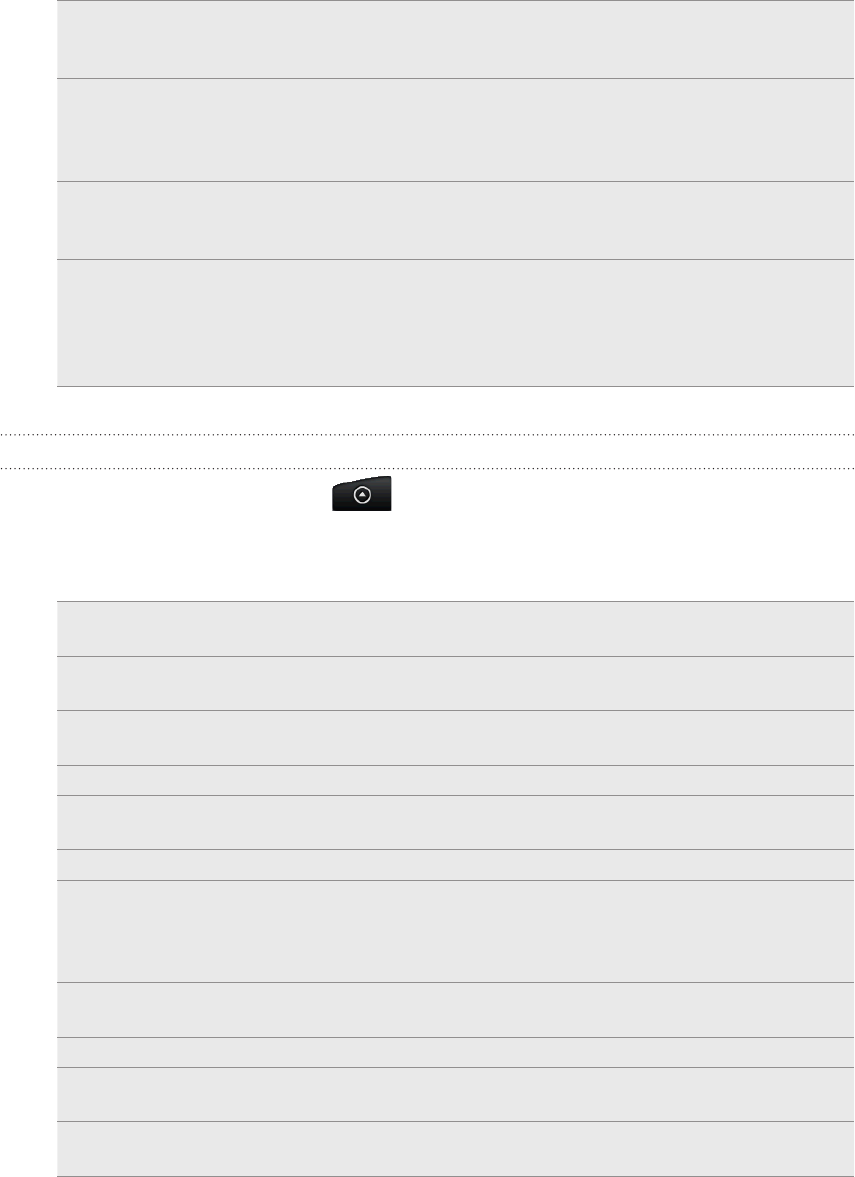
99 Email
Delete Tap Delete.
If you’ve deleted the conversation by accident, tap Undo at the
top of the screen to move the conversation back to the Inbox.
Archive Tap Archive.
If you’ve archived the conversation by accident, tap Undo at
the top of the screen to move the conversation back to the
Inbox.
Mute Press MENU, and then tap Mute.
If you ‘mute’ a conversation, you will not receive any future
messages for that conversation.
Report as spam Press MENU, and then tap Report spam.
The Gmail/Google Mail webmail service works hard to prevent
spam (unwanted and unsolicited “junk” mail) from reaching
your Inbox. But when spam makes it through, you can help
improve the service by reporting the conversation as spam.
Changing Gmail/Google Mail settings
1. From the Home screen, tap > Gmail/Google Mail.
2. In the Inbox, press MENU and then tap More > Settings.
3. Set the following options:
Signature Enter a signature that automatically appears at the end of your
email messages.
Confirm actions Show a confirmation box when you archive, delete or send a
conversation.
Auto-advance Select which conversation to display after you delete or archive
a conversation.
Message text size Adjust the size of text in your email messages.
Batch operations When selected, this adds a check box to the left of each
conversation so you can add it to a batch.
Clear search history Remove the searches you have performed.
Labels Set how many days and which Gmail/Google Mail labels to
synchronize.
See “Changing Gmail/Google Mail synchronization settings” in
this chapter.
Email notifications Show a notification icon on the status bar when you receive a
new email.
Select ringtone Choose a notification sound for new email messages.
Vibrate Make your phone vibrate when you receive a new email
message.
Notify once When cleared, you are notified every time you receive a new
email message.

100 Email
Changing Gmail/Google Mail synchronization settings
1. From the Home screen, tap > Gmail/Google Mail.
2. In the Inbox, press MENU, and then tap More > Settings > Labels.
3. To set the number of days to synchronize, tap Number of days to sync.
4. To set synchronization for a particular message label, tap the label, and then
select whether you want messages bearing that label to sync according to the
default number of days you selected earlier, sync all, or sync none of them.
Using Mail
Use the Mail app to add your webmail and other POP3 or IMAP email accounts. You
can also set up and use your Exchange ActiveSync email on your phone.
Adding a POP3/IMAP email account
From the Home screen, tap > Mail.
Do one of the following:
If this is your first time to add an email account in Mail, tap Other (POP3/
IMAP) on the Choose a mail provider screen.
If you’ve already added an email account in Mail, press MENU, and then tap
More > New account. If the Choose a mail provider screen is displayed, tap
Other (POP3/IMAP).
3. Enter the email address and password for your email account and then tap Next.
4. If the account type you want to set up is not in the phone database, you’ll be
asked to enter more details.
5. Enter the account name and your name and then tap Finish setup.
Adding a Microsoft Exchange ActiveSync account
You can add one or more Microsoft Exchange ActiveSync accounts on your phone.
You can sync with Microsoft Exchange Server 2003 Service Pack 2 (SP2) or later.
You can add up to 15 Exchange ActiveSync accounts on your phone.
From the Home screen, tap > Mail.
Do one of the following:
If this is your first time to add an email account in Mail, tap Microsoft
Exchange ActiveSync on the Choose a mail provider screen.
If you’ve already added an email account in Mail, press MENU, and then tap
More > New account. If the Choose a mail provider screen is displayed, tap
Microsoft Exchange ActiveSync.
1.
2.
1.
2.
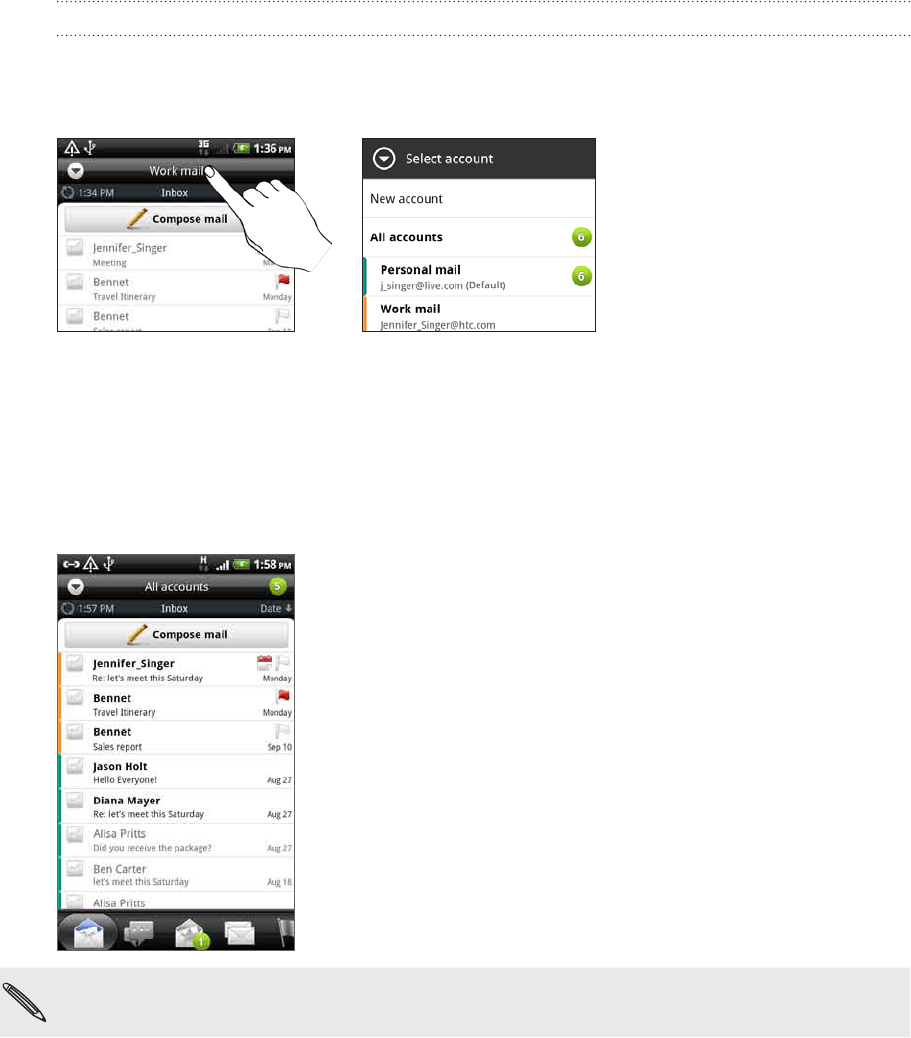
101 Email
3. Enter the Exchange ActiveSync account details, and then tap Next. Your
corporate Exchange Server must support auto-detect for the phone to
automatically set up the Exchange ActiveSync account. If your corporate
Exchange Server does not support auto-detect, you’ll need to enter your
Exchange Server settings after you tap Next. Ask your Exchange Server
administrator for details.
4. Choose the types of information you want to sync. Also choose how often you
want to update and sync email to your phone.
5. Tap Finish setup.
Checking your Mail inbox
When you open the Mail app, it displays the inbox of one of your email accounts that
you’ve set up on your phone. To switch between email accounts, tap the bar that
shows the current email account, and then tap another account.
Viewing the unified inbox of all your email accounts
You can view email from all your accounts just in one place without having to switch to
different accounts.
Just tap the bar that shows the current email account, and then tap All accounts.
Email messages are color coded so you can easily distinguish which email accounts
they belong to.
Up to 15 email accounts can be shown in the unified inbox.
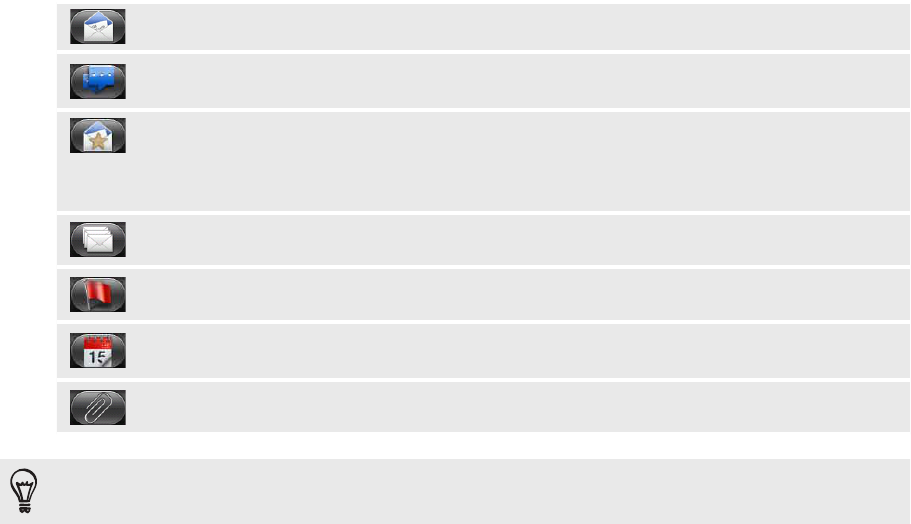
102 Email
Different views of your inbox
If you have lots of email messages, it may take you some time to browse through the
long list and find a single email or related email messages. To skim through your email
messages easier, tap one of the following tabs to change the view of your inbox:
Received. Displays email messages as individual items.
Conversations. Displays email messages as conversations, grouped according to the
subject line. Tap a subject in the list to show the email conversation.
Group. Displays all email messages from a contact group. To choose which contact
group to display, press MENU, tap View, and then select a group.
To find out more about working with contact groups, see “Contact groups” in the
People chapter.
Unread. Displays unread messages.
Marked (Exchange ActiveSync only). Displays all flagged messages.
Meeting invitations (Exchange ActiveSync only). Displays meeting invitations which
you have not yet accepted or declined.
Attachments. Displays all messages that have attachments.
You can rearrange the tabs to the order that you want. To find out how, see “Rearranging or
hiding application tabs” in the Personalizing chapter.
Refreshing your email account
Whatever your automatic synchronization settings are, you can also synchronize your
sent and received emails manually at any time.
While in the account you want to sync, press MENU, and then tap Refresh.
If you have several email accounts, you can refresh them all at the same time.
Go to the unified inbox first. Then press MENU and tap Refresh.
To find out how to display the unified inbox, see “Viewing the unified inbox of
all your email accounts.”
Sorting email messages
You can sort email messages by date received, priority, subject, sender, or size.
On the inbox, press MENU, tap Sort, and select from the sorting options.
Quickly browsing your inbox
If you have a long list of email messages in your inbox, it may not be easy to browse
the list and find an email that you want.
You can quickly browse through your inbox by using finger gestures.
Choose a sorting order for displaying your email messages. See “Sorting email
messages.”
Press and hold your two fingers on any email message, and then slightly drag
downward without lifting your fingers.
1.
2.
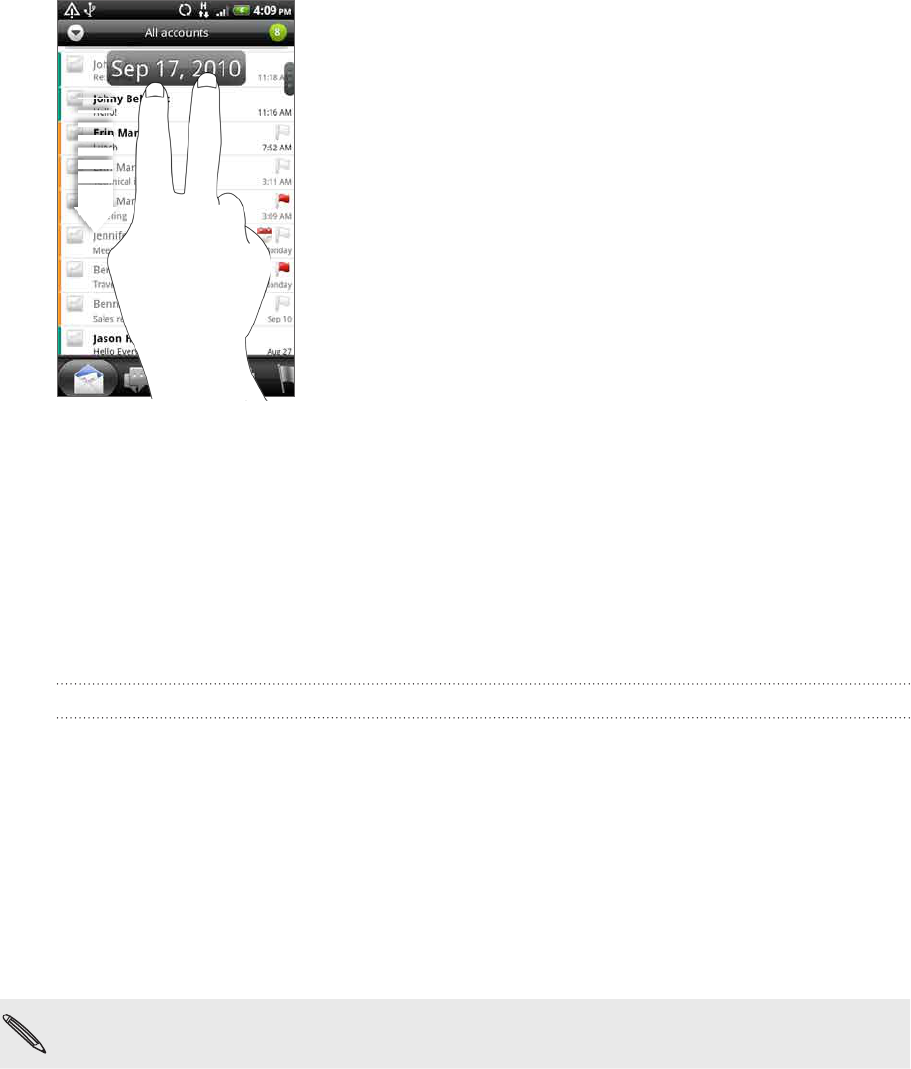
103 Email
Your screen then jumps to the next or previous set of email messages based on your
chosen sorting order. For instance:
If your email messages are arranged by date, your screen jumps to the email
messages received on the previous or next date, depending on your sorting
order.
If your email messages are arranged alphabetically by sender name or
subject, your screen jumps to the previous or next sender or subject,
depending on what’s your sorting order.
Managing email messages
Deleting an email message
On the inbox, press and hold the message you want to delete.
On the options menu, tap Delete.
Selecting several email messages
Tap the check boxes of email messages to select them.
Choose what you want to do with the selected messages: Mark unread, Delete,
or Move to another folder.
You cannot move email messages when you’re in the unified (All accounts) inbox.
Moving several email messages to another folder
Switch to the email account you want to use.
Go to the Received tab or any other tab (except for the Conversations tab).
Tap the check boxes of email messages you want to move.
Tap Move to, and then tap the folder where to move the email messages.
1.
2.
1.
2.
1.
2.
3.
4.
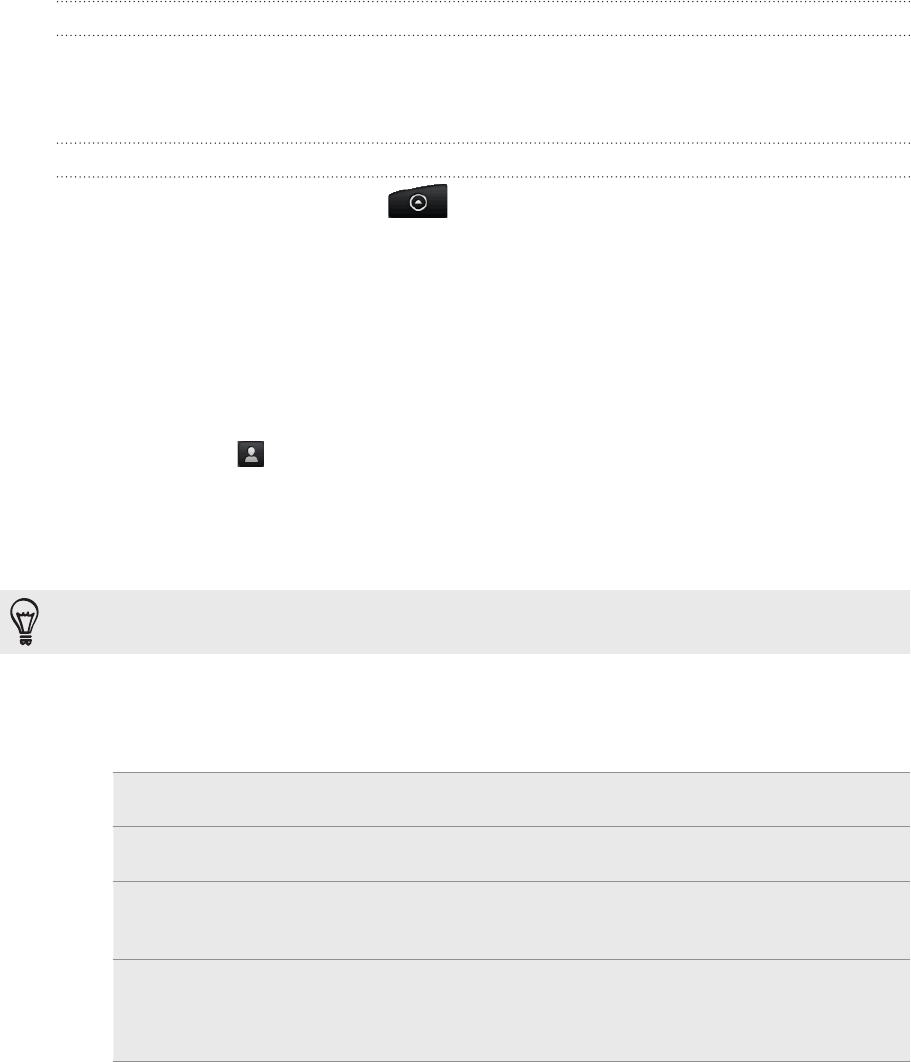
104 Email
Moving an email message after reading
In the open message, press MENU, and then tap More > Move to.
Deleting all messages
First tap the check box of any email message.
Press MENU, and then tap Select all.
Tap Delete.
Switching to other mail folders
Press MENU, and then tap Folders.
Tap the mail folder whose messages you want to view.
Sending an email message
From the Home screen, tap > Mail.
Switch to the email account that you want to use for sending email.
On the email account inbox, tap Compose mail.
Fill in one or more recipients. You can:
Enter email addresses directly in the To field, separating them with a
comma. As you enter email addresses, any matching addresses from your
contacts list are displayed. Tap a match to enter that address directly.
Tap the icon, and then choose the contacts to whom you want to
send the message. You can also select contact groups as recipients, or
search and add contacts from the company directory if you have set up an
Exchange ActiveSync account on your phone. When you have selected all
the message recipients, tap OK.
If you want to send a carbon copy (Cc) or a blind carbon copy (Bcc) of the email to other
recipients, press MENU, and then tap Show Cc/Bcc.
4. Enter the subject, and then compose your message.
5. To add an attachment, press MENU, tap Attach, and choose from the following
options:
Picture Select Camera to take a photo and attach it, or Gallery to
attach a photo from your storage card.
Video Select Camcorder to capture a video and attach it, or
Videos to attach a video from your storage card.
Audio Select Voice Recorder to make a voice recording and
attach it, or Files to attach a music file or voice recording
from your storage card.
App recommendation Choose an app you’ve installed from Android Market that
you want to tell other people about. The URL from which
the app can be downloaded will be inserted in your email.
See “Sharing games and apps” in the More apps chapter.
1.
2.
3.
1.
2.
1.
2.
3.
4.
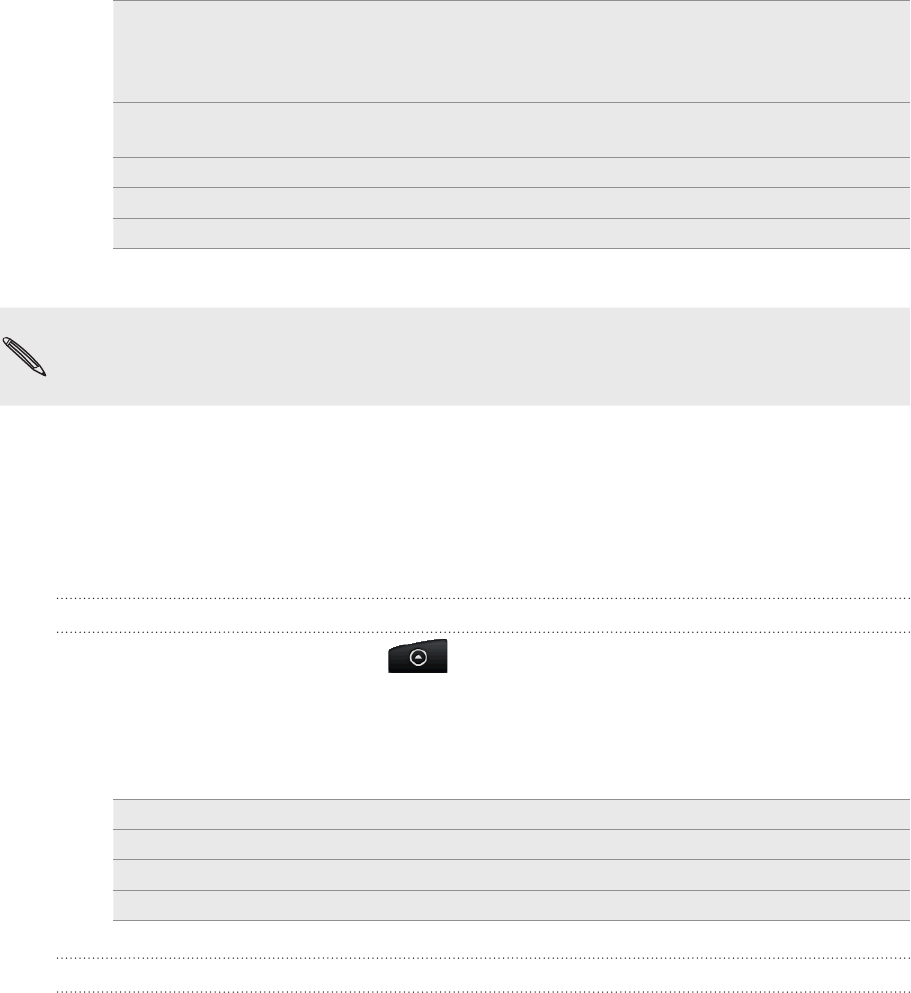
105 Email
Location You can attach location information. Send your current
location (requires GPS to be turned on) or a location you
pick on a map. For more information, see the Maps and
location chapter.
Document Attach a PDF file or an Office document such as a text file
or a spreadsheet.
Contact (vCard) Attach someone’s contact information.
Appointment (vCalendar) Attach a calendar event.
File Attach any file from your storage card.
6. Tap Send to send the message immediately, or tap Save as draft to send it later.
If there’s no Wi-Fi or data connection available or Airplane mode is on when you send your
email, the email will be saved to the Outbox folder. Once there’s Wi-Fi or data connection
available, the saved email will be sent automatically next time your phone syncs.
Resuming a draft email message
In the email account inbox, press MENU, and then tap Folders > Drafts.
Tap the message.
When you finish editing the message, tap Send.
Reading and replying to an email message
From the Home screen, tap > Mail.
Switch to the email account you want to use.
On the email account inbox, tap the email you want to read.
Do any of the following:
Reply to the message Tap Reply or Reply all.
Forward the message Press MENU, and then tap More > Forward.
Delete the message Press MENU, and then tap Delete.
Mark the message as unread Press MENU, and then tap Mark unread.
Setting the priority for an email message
You can set the priority for an email message that you send.
While composing the message, press MENU.
Tap Set priority.
Select the priority for the message.
If you selected High or Low priority, the priority appears below the subject line of the
message.
1.
2.
3.
1.
2.
3.
4.
1.
2.
3.

106 Email
Working with Exchange ActiveSync email
If you sync your phone with your work Exchange ActiveSync account, you can read,
reply, send, and manage email in the same easy way as with a POP3/IMAP account. In
addition, you can also use some powerful Exchange features.
To find out how you can set up your Exchange ActiveSync account, see “Adding a
Microsoft Exchange ActiveSync account” in this chapter.
Flagging an email
While viewing the inbox, tap the white flag icon that appears on the right of an
email message. The icon turns red after you flagged the email.
While reading an email, you can also tap the flag icon in the email.
Setting out of the office status
You can set your out of office status and auto-reply message right from your phone.
Switch to your Exchange ActiveSync account.
Press MENU and then tap More > Out of the office.
Tap the box, and then select Out of the office.
Set the dates and times for the period when you will be out of the office.
Enter the auto-reply message.
Tap Save.
Sending a meeting request
Switch to your Exchange ActiveSync account.
Go to the Meeting invitations tab, and then tap New meeting invitation.
Enter the meeting details,
Tap Send.
1.
2.
3.
4.
5.
6.
1.
2.
3.
4.
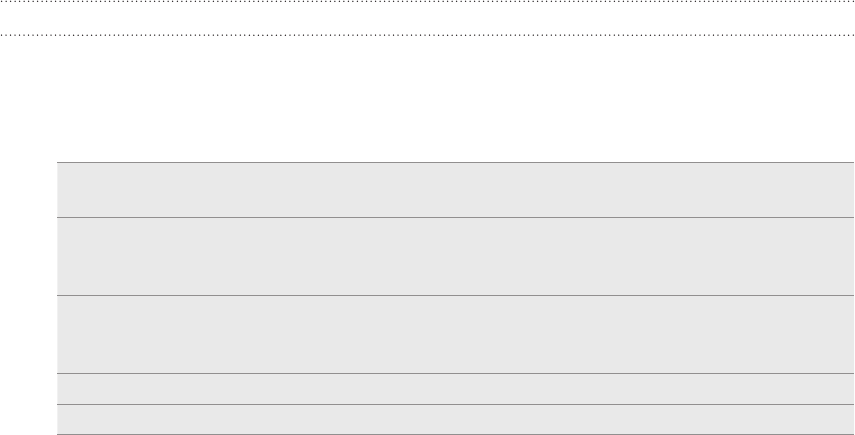
107 Email
Changing email account settings
Switch to the email account whose settings you want to change.
Press MENU and then tap More > Settings.
Select from the following:
Account settings Change the email account settings such as the name, email
address, password, and description.
General settings Set the font size when reading emails, enable, disable or set the
signature, set the account as the default email account, and set
where to save email attachments.
Send & Receive Set the maximum email file size limit when receiving and
frequency to check for new emails and how many to check for.
You can also set to have emails that you send bcc’d to yourself.
Notification settings Set email notification settings.
Delete account Tap to delete the email account.
4. Press BACK to save your changes.
Deleting an email account
Switch to the email account you want to delete.
Press MENU, and then tap More > Settings > Delete account.
1.
2.
3.
1.
2.

108 Calendar
Calendar
About Calendar
Never miss an important date again. Use your phone’s Calendar to schedule your
events, meetings, and appointments.
You can set up your phone to stay in sync with the following types of calendars:
On your phone, sign in to your Google Account so you’ll be able to sync your
phone’s Calendar with your Google Calendar online. You can add multiple
Google accounts. If you have not signed in to your Google Account yet, see
the Accounts and sync chapter to find out how to sign in.
If you’re using Microsoft Outlook on your computer, you can set up HTC Sync
on your computer to sync Outlook Calendar with your phone’s Calendar. See
“Synchronizing with your computer” in the Accounts and sync chapter.
If you have a Microsoft Exchange ActiveSync account and you have added
it on your phone, you can sync your phone’s Calendar with your Exchange
ActiveSync calendar events. See the Email and Accounts and sync chapters
for details.
If you’ve signed in to your social network accounts such as Facebook, birthdays and
events of friends from your social networks will appear in Calendar. To find out how to
sign in to your social networks, see “Adding a social network account” in the Accounts
and sync chapter.
Creating calendar events
You can create events that appear on your phone only, as well as events that sync with
your Google Calendar, your computer’s Outlook Calendar, or Exchange ActiveSync
calendar.
1. From the Home screen, tap , and then tap Calendar.
2. On any Calendar view, press MENU and then tap New event.
When you are in the Month or Agenda view, you can also tap at the bottom-right of the
screen to create a new event.
3. If you have more than one calendar, select a calendar in which to add the event:
Select My Calendar to create an event that will appear only on your phone.
Select your Google Account to create a Google Calendar event. If you have
several Google Calendars on the Web, select one in which to add your
event.

109 Calendar
Select PC Sync to create an Outlook Calendar event to sync with your
computer.
Select your Exchange ActiveSync account to create an Exchange
ActiveSync calendar event.
4. Enter a name for the event.
5. To specify the date and time of the event, do one of the following:
If there is a time frame for the event, tap the From and To date and time to
set them.
If it is a special occasion such as a birthday or a whole-day event, set the
From and To date, then select the All day check box.
6. Enter the event location and description.
7. Set the reminder time.
You can add another reminder time in a Google Calendar event. Press MENU and then tap
Add reminder.
8. If the event occurs on a regular basis, tap the Repetition box and then choose
how often the event occurs.
9. Scroll to the bottom of the screen and then tap Save.
Inviting guests to your event (Google Account only)
If you want to invite guests to your event, you need to create and add the event
in your Google Calendar. An invitation email will be sent to your guests using your
Google Account.
1. Open Calendar and create a new event. Tap the Calendar field and then select
your Google Account (or one of your other Google Calendars). For the steps, see
“Creating calendar events”.
2. Add details about the event, such as date and time, location, and more.
3. In the Guests field, enter the email addresses of everyone you want to invite to
the event. Separate multiple addresses with commas ( , ).
If the people to whom you send invitations use Google Calendar, they’ll receive
an invitation in Calendar and by email.
4. Tap Save to add the event to your Google Calendar.
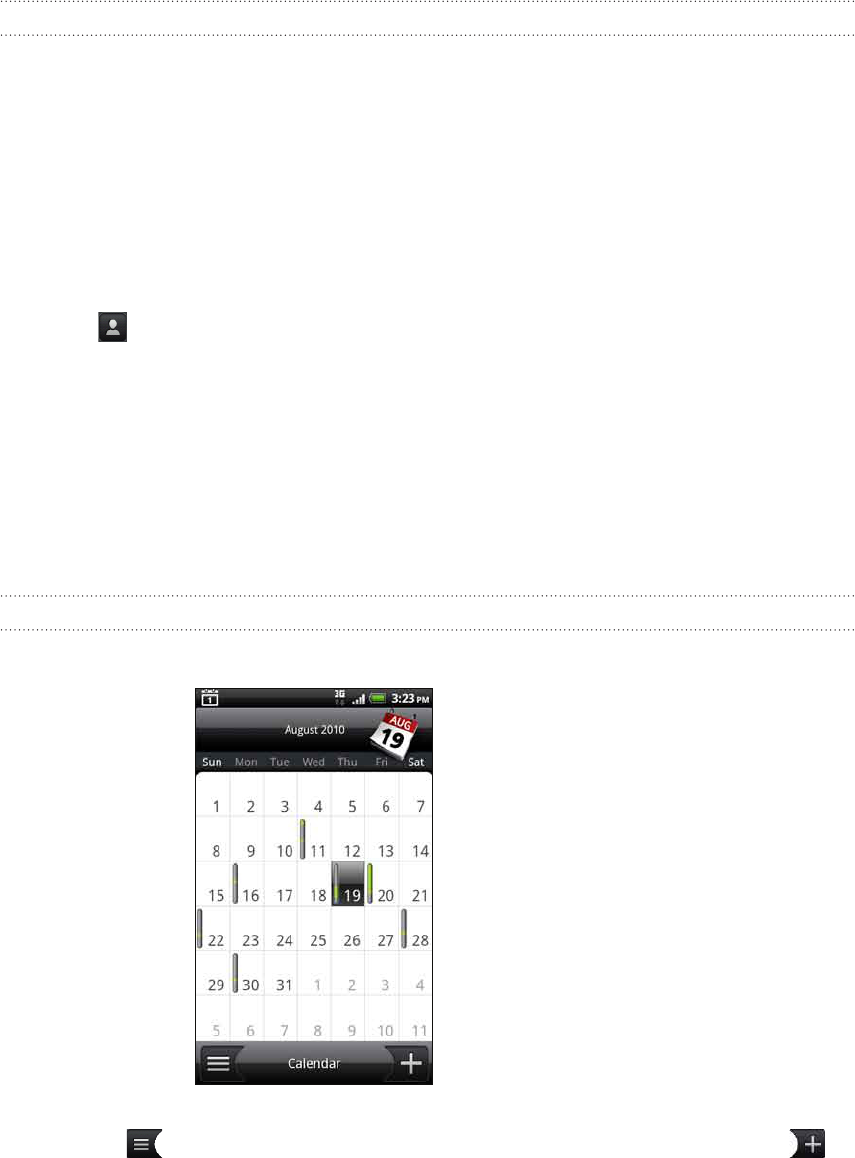
110 Calendar
Sending a meeting request using Calendar (Exchange ActiveSync only)
If you have an Exchange ActiveSync account set up on your phone, you can use
Calendar to create a meeting appointment and send a meeting request email to the
people you want to invite to your meeting.
1. Open Calendar and create a new event. Tap the Calendar field and then select
your Exchange ActiveSync account. For the steps, see “Creating calendar
events”.
2. Add details about the meeting, such as date and time, location, and more.
3. Press MENU and then tap Meeting Invitation.
4. Tap and choose attendees from your contacts or Company directory.
5. Enter your message and then tap Send.
Changing calendar views
When you open Calendar, it displays the Month view by default. You can also display
the Calendar in Agenda, Day, or Week view. To change between calendar views, press
MENU, and then choose the type of view that you want.
Month view
In Month view, you’ll see markers on days that have events.
When in Month view:
Tap on the bottom left of the screen to switch to Agenda view. Tap
on the bottom right to create a new event.
Tap a day to view the events of that day.
Press and hold a day to open an options menu from which you can also
choose to create an event or switch to either Day or Agenda view.
Slide your finger up or down the screen to view earlier or later months.
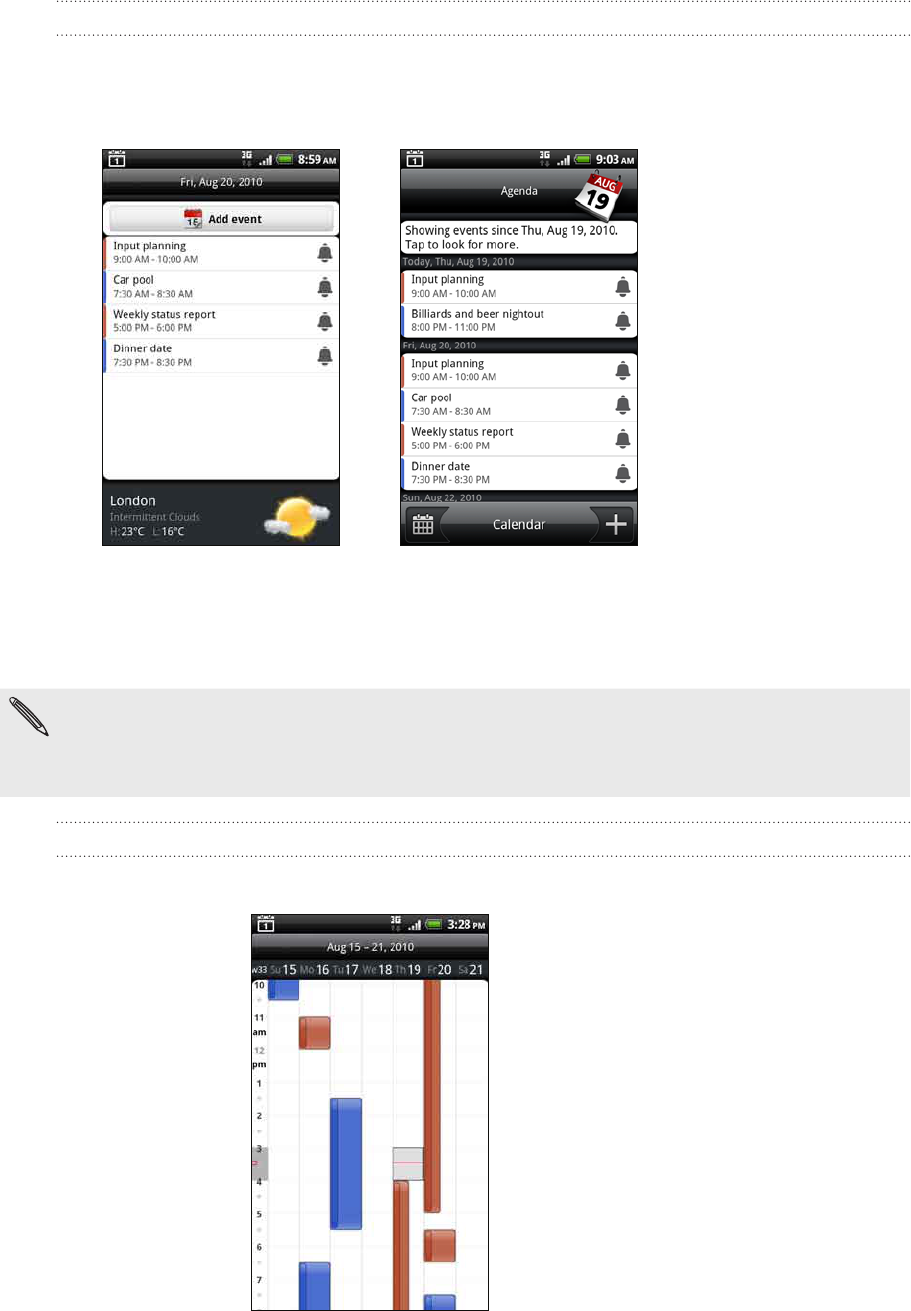
111 Calendar
Day and Agenda views
Day view displays a list of the events of one day and also shows weather information
at the bottom of the screen when you’re viewing events of the current day. Agenda
view shows a list of all your events in chronological order.
The color bars on the left side of the events indicate the type of calendar in which
the event is part of. To find out what each color represents, press MENU and then tap
More > Calendars.
When in Day view, slide left or right across the screen to view earlier or later days.
In Day view, the weather information appears only if the event is within the five-day forecast
of the Weather app.
Weather information does not appear in Day view when you change Day view to display as
a time list. See “Changing Calendar settings” for details.
Week view
Week view displays a chart of the events of one week.

112 Calendar
When in Week view:
You can press and hold on a time slot to create a new event at that time.
Tap an event to view its details.
Slide left or right across the screen to view earlier or later weeks.
Managing calendar events
You can view, edit, delete, or share events that you created. You can also view and
share event invitations that other people sent to you.
Viewing an event
1. From the Home screen, tap , and then tap Calendar.
2. In Month view, tap the day when the event takes place, and then tap the event to
open it.
The Event details screen then opens and shows the summary of the event.
3. When viewing the event summary, you can do the following:
Find the event’s location in Maps.
Call any phone number included in the event location or description.
Check the participants of the event you sent or are invited to.
Respond whether you’ll attend the event you’re invited to.
If it’s an Exchange ActiveSync calendar event, reply by email to the
organizer or to all the guests. Press MENU, and then either tap Reply or
Reply all.
Select any text and look it up on the web. To learn more, see “Selecting text”
in the Keyboard chapter and “Quickly looking up information on the Web” in
the Getting started chapter.
Tap the reminder time to change it. Press BACK to save changes.
Editing an event
1. While viewing an event, press MENU, and then tap Edit event.
2. Make your changes to the event.
3. When you’re done editing, tap Save.
Deleting an event
There are a number of ways to delete an event.
While viewing the summary of an event on the Event details screen, press
MENU and then tap Delete event.
In Day, Agenda or Week view, press and hold an event and then tap Delete
event.

113 Calendar
When editing an event, scroll down to the bottom of screen and then tap
Delete.
If the event repeats, you’ll be asked whether you want to delete just that
occurrence, this and all future occurrences, or all past and future occurrences in
your Calendar.
Sharing an event (vCalendar)
You can share a calendar event as a vCalendar to someone’s phone using Bluetooth or
by sending it as a file attachment with your email or message.
While viewing an event, press MENU, and then tap Share.
Do one of the following:
Tap Bluetooth. you’ll be asked to turn on Bluetooth on your phone and
connect to the receiving Bluetooth device. Follow the steps in “Sending
information using Bluetooth” in the Bluetooth chapter.
Tap Email. A new message window opens and automatically includes the
vCalendar as an attachment. Your default email account that’s selected
in the Mail app will be used to send. For more information, see the Email
chapter.
Tap Message. A new message window opens and automatically includes
the vCalendar as a multimedia attachment. For more information, see the
Messages chapter.
Calendar event reminders
If you have set at least one reminder for an event, the upcoming event icon will
appear in the notifications area of the status bar to remind you of the upcoming event.
Dismissing or snoozing event reminders
1. Tap the status bar, then slide your finger down the screen to open the
Notifications panel.
2. Do one of the following:
Tap Clear to dismiss event reminders and all other notifications. Other types
of notifications such as new messages and missed calls will also be deleted.
After sliding open the Notifications panel, tap the calendar event reminder.
You’ll then see a list of all pending event reminders. Tap Snooze all to
snooze all event reminders for five minutes, or tap Dismiss all to dismiss all
event reminders.
Press BACK to keep the reminders pending in the notifications area of the
status bar.
1.
2.